SGR 1935+2154的FRB-持续更新
SGR 1935+2154 的FRB -- 第一个5.1日分享了,一更新就要审核,干脆复制一个再更新。
2020年5月1日 及后续观测更新
1. 4.10日的伽玛暴
1.1 最早应该是4.10号,看到了软伽玛射线,
1.2 GBM的观测:
1.3 Konus-WIND看到了
1.4 Swift/BAT 说是45s的GRB 200410A
2. 4.22日的爆发
2.1 Konus-WIND看到的,
3. 4.27日的爆发
3.1 Swift/BAT观测,
3.2 GBM也看到了,
3.3 MAXI/GSC也看到了多次爆发,
3.4 HXMT也计划看
3.5 日本的CALET Gamma-ray Burst Monitor (CGBM)看到了很多,
3.6 Konus-WIND说有几十个
4 4.28有FRB的观测
4.1 CHIME看到了FRB http://www.astronomerstelegram.org/?read=13681
4.2 STARE2也看到这个FRB http://www.astronomerstelegram.org/?read=13684
4.2.5 FAST也看到了一个弱的FRB http://www.astronomerstelegram.org/?read=13699
4.3 INTEGRAL看到的,
4.4 Konus-WIND的观测,
4.5 Insight-HXMT也观测到了,数据非常好
4.6 AGILE也看到了,
5 爆发前后的其它观测
5.1 伽玛射线波段
5.1.1 AGILE看到了burst forest
5.1.2 Konus-Wind在5.10看到了一个伽玛暴
5.2 X-ray波段
5.2.1 NICER看到了它的大量的暴
5.2.2 Swift/XRT也看到了几个暴
5.2.3 AGILE在5.3日又看到一个
5.2.4 HXMT又看到一个,和AGILE、Fermi同时; 而且这段时期看到了很多
5.2.5 NuSTAR, NICER and Swift监视
5.2.6 SRG 四天前扫过了哪里,没看到什么
5.3 光学波段
5.3.1 MASTER-Amur robotic telescope没看到,给出了极限星等。
5.3.2 MASTER Global Robotic 跟踪了4.27号的,
5.3.3 Tomo-e Gozen camera也没看到
5.4 射电波段
5.4.1 VLA什么都没看到
5.4.2 FAST也没看到
5.4.3 LOFAR也没找到
5.4.4 DSN也没找到FRB,并且也找了射电脉冲星,也没找到
5.4.5 Aricibo在20191007的历史数据里也没有FRB
5.5 高能宇宙线、中微子
5.5.1 IceCube说看到了一个中微子
5.5.2 ANTARES说没看到
6. 关于SGR 1935+2154
6.1 基本参数
6.1.1
6.1.2. 它的3.2s是X-ray的,
6.1.3 没有射电脉冲星
6.1.4 频率变化 doi:10.1093/mnras/sty3213
6.2 射电图像
6.3 关于它的距离
6.3.1 历史文章,12kpc,9kpc等
6.3.2 看 SNR G57.2+0.8 推测 SGR 1935+2154 的距离6.6 +/- 0.7 kpc arXiv:2005.03517
6.4 红外辐射
6.5 射电脉冲星
2020年5月2日
如果用激波朗道阻尼来解释,有这样一些点:
2020年5月3日
也许和II型太阳的射电暴是同样的机制呢。
2020年5月4日
和三型暴应该是不同的,虽然三型的研究的比较清楚了,是电子注入到了等离子中
2020年5月22日
CHIME的观测文章
STARE2的观测文章
2020年5月24日
慧眼的观测
Konus-WIND的观测
2020年5月26日
FAST给出了限制,在其它的flare时没有FRB
AGILE对FRB时期X-ray的观测
2020年6月2日
Swift,NICER,NuSTAR在暴前后的观测
又一篇想投Nature的,说同时的这个X射线暴比别的暴都硬
2020年7月30日
又发现了1935的两个FRB,流量低四五个量级,https://arxiv.org/abs/2007.05101
2020年8月21日
射电和X射线都有周期,3s
2020年9月18日
NICER的文章出来了
2020年11月5日
2022年4月1日
总结一下FRB的一些基本特征
距离:~12kpc
FRB时间: 2020-04-28 14:34:33 UTC,双峰,时标各自5ms,间隔30ms;可能1.4GHz的是另外一个峰,流量更高很多。
谱:低中高频都有,但并不同时。
DM: ~332.8 pc/cc。
有同时的X射线爆发,HXMT看得最清楚。
2020年5月1日 及后续观测更新
爆炸性新闻,居然是在放本地新冠新闻的胖友圈上看到的:
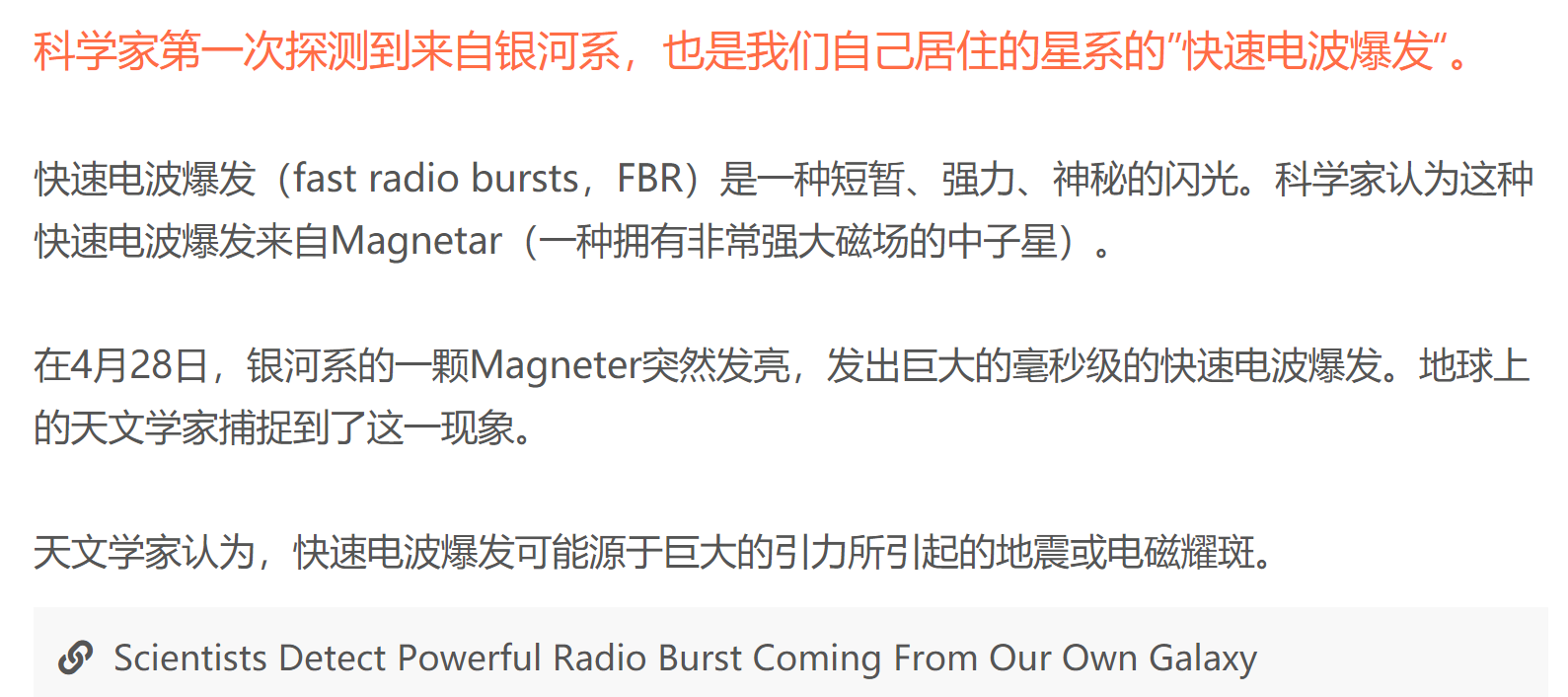
他们又是看的这里: https://futurism.com/scientists-fast-radio-bursts-milky-way
另外一些新闻: https://www.sciencealert.com/a-galactic-magnetar-just-spat-out-something-shockingly-like-a-fast-radio-burst
下面是一些观测结果。
1. 4.10日的伽玛暴
1.1 最早应该是4.10号,看到了软伽玛射线,
这是给出了IPN的定位: https://gcn.gsfc.nasa.gov/gcn3/27527.gcn3
A bright, short-duration, soft burst has been observed by Fermi (GBM trigger 608204639) and Konus-Wind, so far, at about 35034 s UT (09:43:54) on April 10. 它们给出了定位,说和1935一致。
1.2 GBM的观测:
At 09:43:54.30 UT on 10 April 2020,T90=128ms,Ep=32.7keV https://gcn.gsfc.nasa.gov/gcn3/27531.gcn3
又叫 Fermi GRB200410.41 (trigger No 608204639) , SGR 1935+2154 (trigger 608204639 / 200410405)
The light curve shows a short bright peak with a duration (T90) of about 128 ms (50-300 keV). The time-averaged spectrum from T0-64 ms to T0+192 ms is best fit by a power law function with an exponential high-energy cutoff. The power law index is 0.70 +/- 0.10 and the cutoff energy, parameterized as Epeak, is 32.7 +/- 0.3 keV
1.3 Konus-WIND看到了
UT (09:43:52.256),时标0.2s, Ep = 28(-7,+4) keV https://gcn.gsfc.nasa.gov/gcn3/27554.gcn3
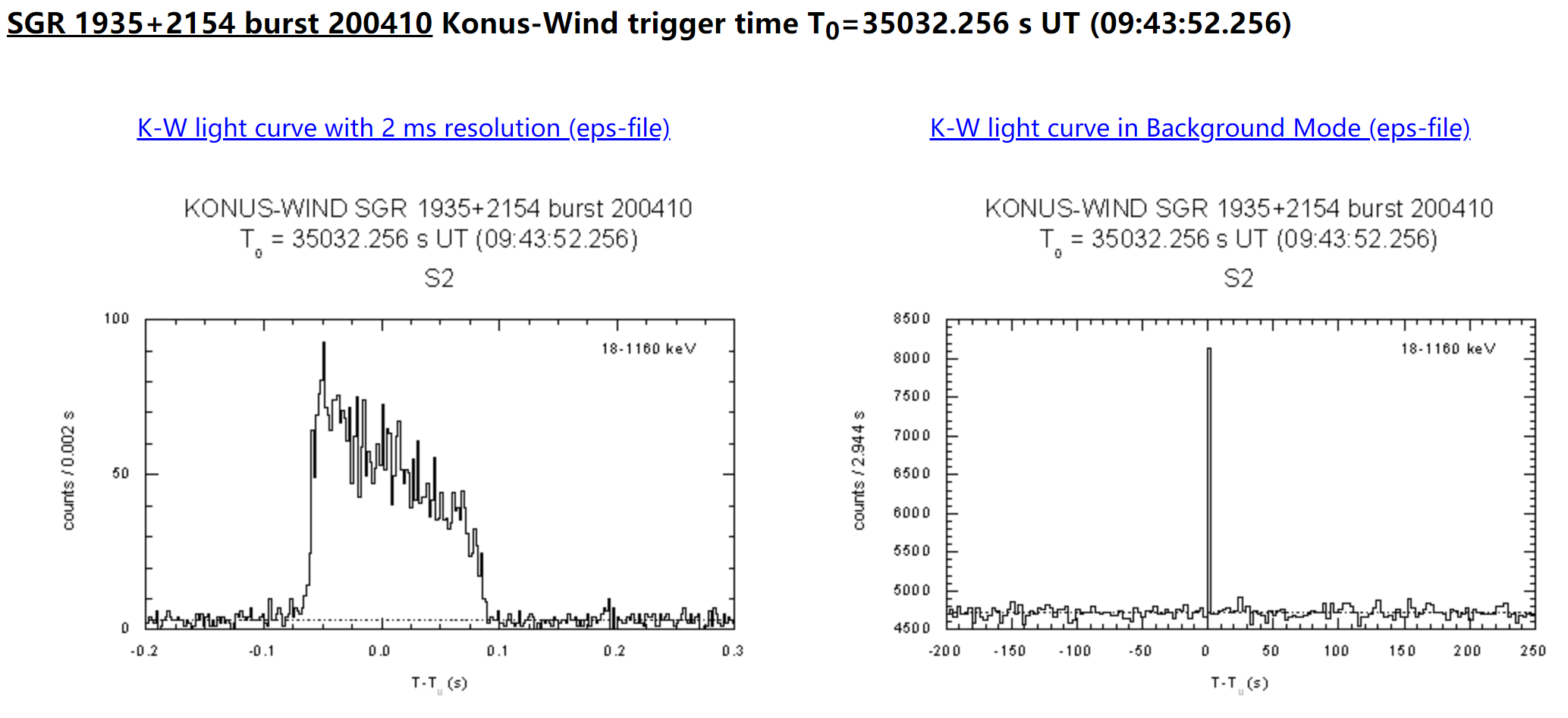
1.4 Swift/BAT 说是45s的GRB 200410A
https://gcn.gsfc.nasa.gov/gcn3/27518.gcn3
The BAT light curve shows multiple peaks with a total duration of about 45 sec. The peak count rate was ~1000 counts/sec (15-350 keV), at ~1 sec after the trigger. 这个不是,时间不同。02:25:10 UT,
2. 4.22日的爆发
2.1 Konus-WIND看到的,
UT (08:53:16.933) on 2020 April 22,时标0.6s https://gcn.gsfc.nasa.gov/gcn3/27631.gcn3
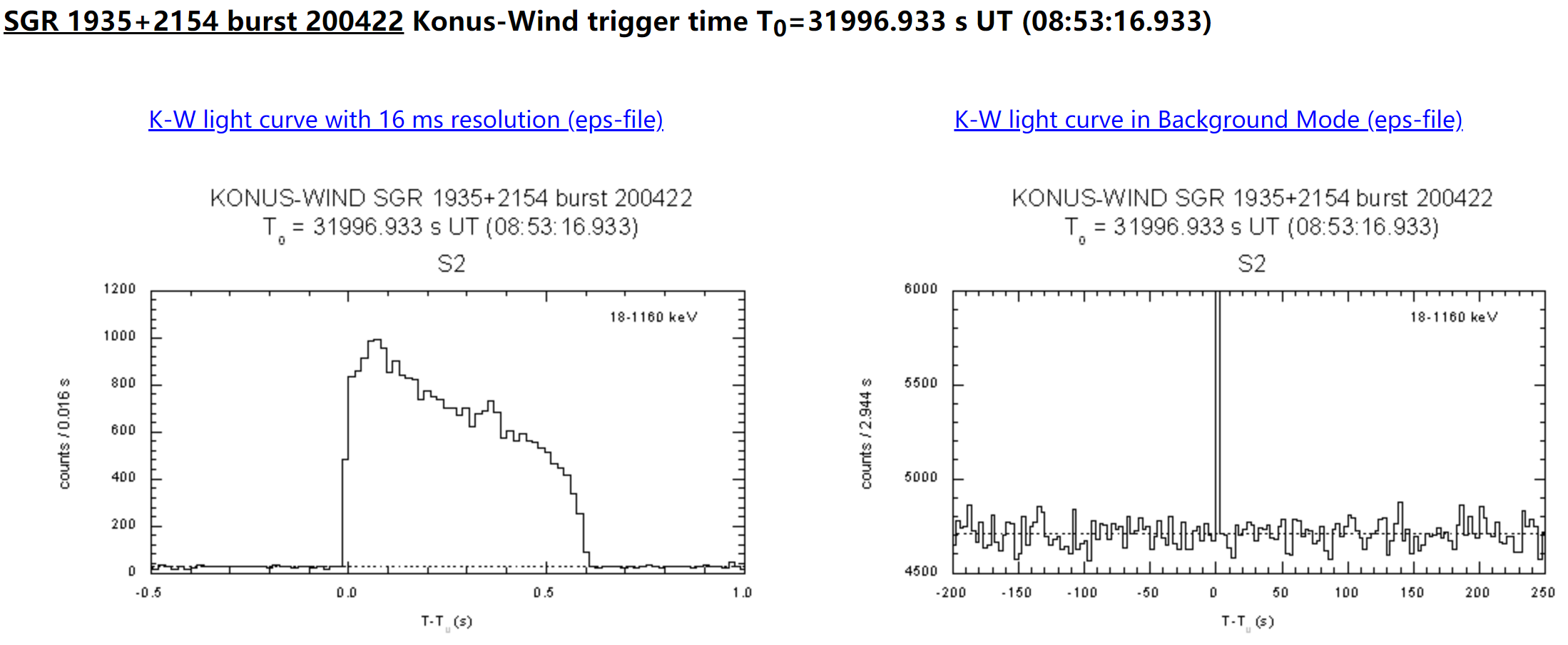
3. 4.27日的爆发
3.1 Swift/BAT观测,
18:26:20 UT https://gcn.gsfc.nasa.gov/gcn3/27657.gcn3
多次爆发
3.2 GBM也看到了,
18:26:20.16 UT on 27 April 2020,T90=2s,也是多次 https://gcn.gsfc.nasa.gov/gcn3/27659.gcn3
It is well-fit by a power law function with an exponential high-energy cutoff. The power law index is 0.02 +/- 0.68 and the cutoff energy, parameterized as Epeak, is 27.2 +/- 2.5 keV.
The event fluence (10-200 keV) from T0-1.024 to T0+1.024 is (2.0 +/- 0.2)E-7 erg/cm^2.
The average photon flux in the 10-200 keV band during this period is 2.5 +/- 0.2 ph/s/cm^2.
Fermi GBM also subsequently triggered on multiple bursts from SGR 1935+2154 on 27 April 2020 with a fraction of these being misclassified as GRBs.
3.3 MAXI/GSC也看到了多次爆发,
20:01:45.99 of 2020-04-27 UT (时间和上面不一样) https://gcn.gsfc.nasa.gov/gcn3/27661.gcn3
Showing a double-peaked profile, the first one started at 20:01:45.99 of 2020-04-27 UT with a total duration of ~100 ms.
The 5ms peak flux was about 75 Crab in the 2-20 keV band for each pulse.
The second burst started at 21:56:02.63 UT with a single-peaked structure with a duration of 50 ms. This peak flux was about 40 Crab in 5 ms.
3.4 HXMT也计划看
https://gcn.gsfc.nasa.gov/gcn3/27662.gcn3
他们还提到了它的前面几次爆发,很频繁。SGR 1935+2154 went into outbursts in 2014 July, 2015 Feb., 2016 May and June (Lin et al. 2020). Several short bursts including very bright ones were detected in 2019 November and 2020 April by multi instruments.
3.5 日本的CALET Gamma-ray Burst Monitor (CGBM)看到了很多,
从18:32 UTC on 27 April 2020开始,和Swift,Fermi基本一致,晚了几分钟 https://gcn.gsfc.nasa.gov/gcn3/27663.gcn3
The first CGBM trigger was shortly followed by another CGBM trigger at 18:46:08.675 UTC (trigger 1272047979:
http://cgbm.calet.jp/cgbm_trigger/flight/1272047979/index.html) with several intense bursts.
Additional two unalerted CGBM triggers with multiple short intense soft bursts were detected at ~20:15 UTC and ~21:49 UTC on 2020-04-27. After this, CGBM on-board trigger was disabled because it reached the maximum numbers of the accepted triggers.
Further episodes of SGR activity were observed in CGBM TH data at ~23:18 UTC on 2020-04-27 and at ~00:43 - 00:57 UTC on 2020-04-28.
Totally several tens of short bright SGR bursts have been detected by CGBM so far. So, SGR 1935+2154 did enter a new phase of activity as was suggested in GCN 27623.
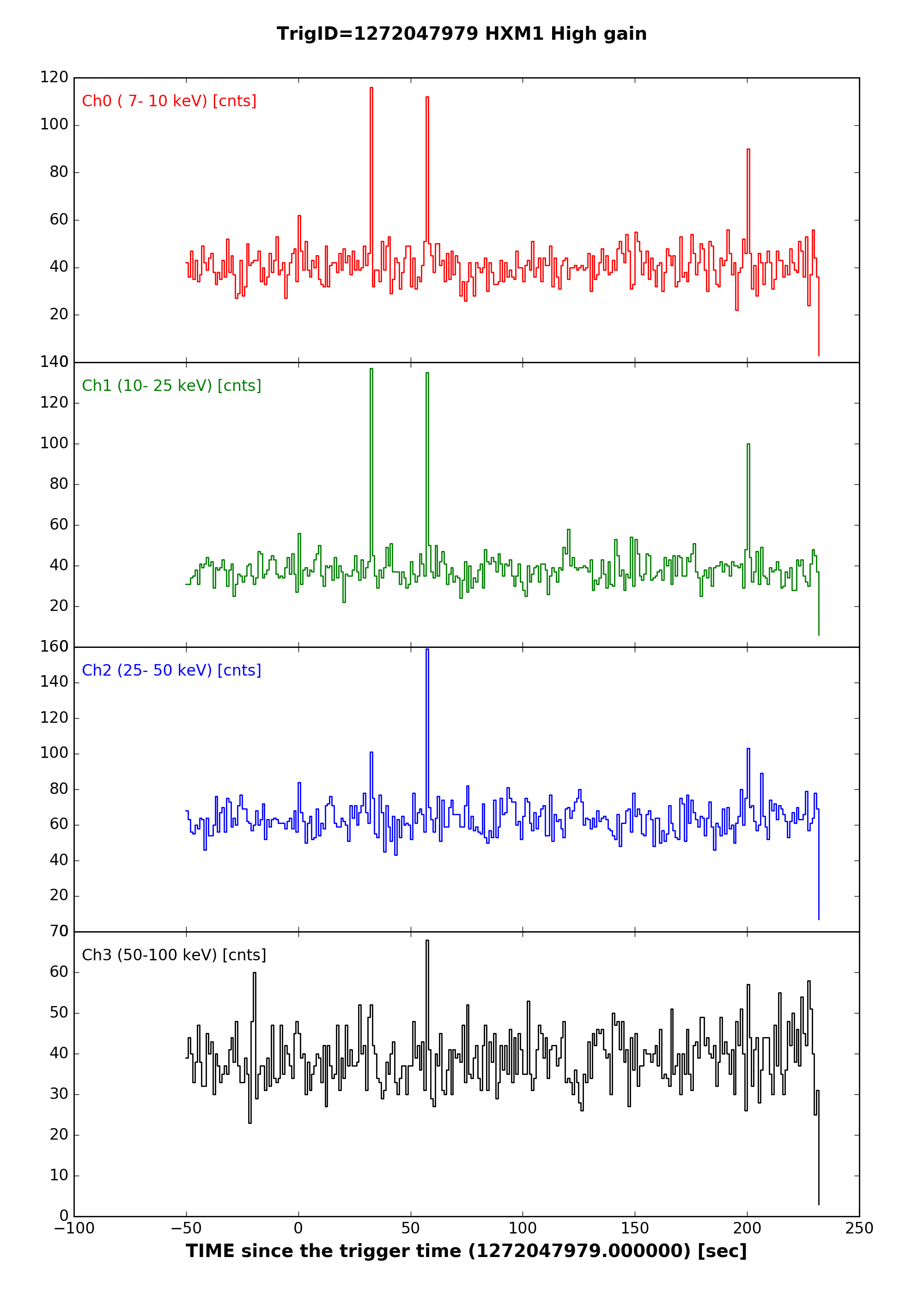
http://cgbm.calet.jp/cgbm_trigger/flight/1272047979/index.html 很多这样的
3.6 Konus-WIND说有几十个
https://gcn.gsfc.nasa.gov/gcn3/27667.gcn3
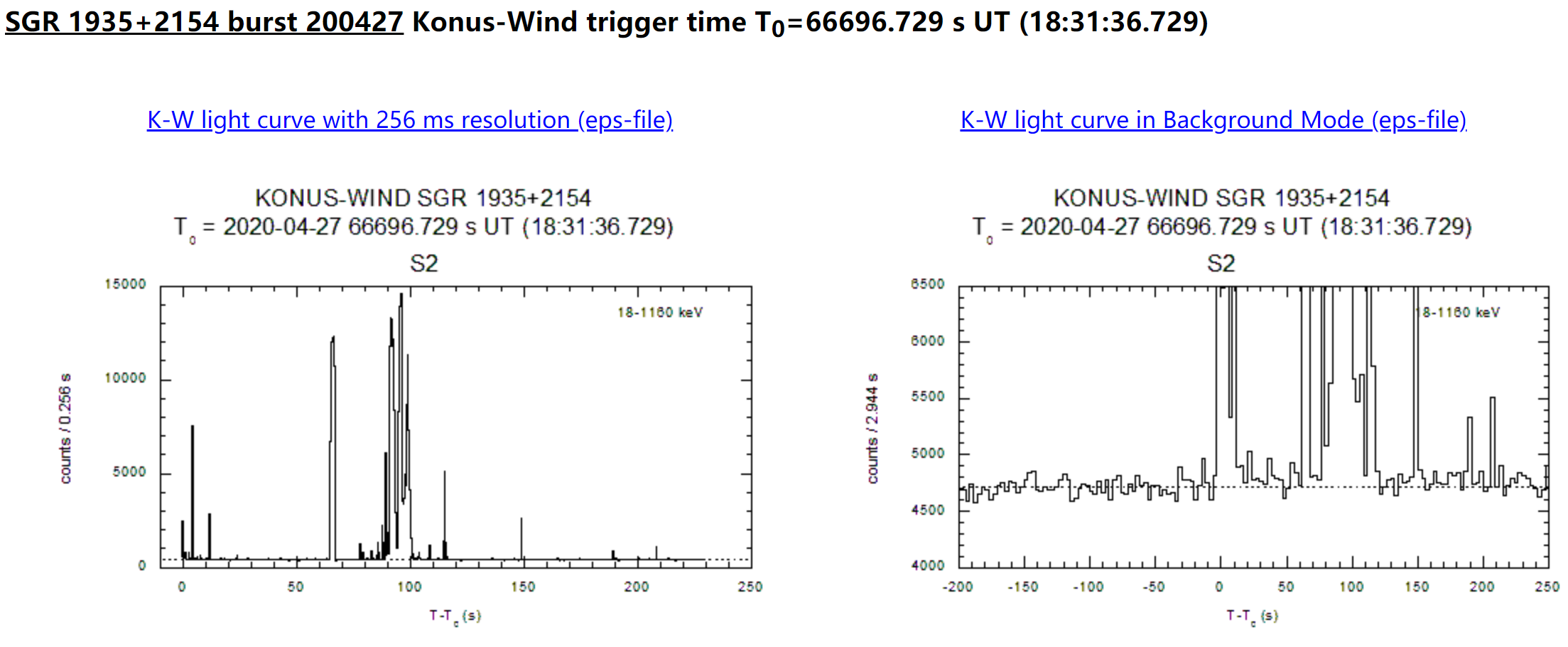
4 4.28有FRB的观测
4.1 CHIME看到了FRB http://www.astronomerstelegram.org/?read=13681
2020-04-28 14:34:33 UTC , DM of 332.8 pc/cc.
通过之前X射线得到的NH:the measured NH of SGR 1935+2154 of 1.6e22 cm^-2 (Israel et al. 2016, MNRAS, 457, 3448).所对应的DM是 530 +/- 200 pc/cc
可能和超新星遗迹成协:potentially associated with SNR G57.2+0.8. 则DM towards G57.2+0.8 of ~290 pc/cc.,比前面的332稍微小一点儿。
流量: estimate the 400-800 MHz radio fluence to be a few kJy ms.
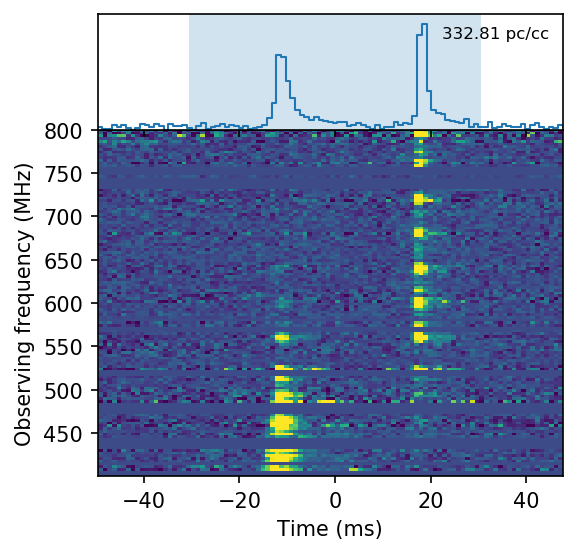
If confirmed, this would be the first radio detection of SGR 1935+2154. Previous observations of this source by Surnis et al. (2014, ATel #6376) at 326.5 MHz and 610 MHz during a different active phase yielded upper limits of 0.4 mJy and 0.2 mJy, respectively. Burgay et al. (2014, ATel #6371) reported upper limits at 3 and 1.5 GHz of about 0.07 mJy and 0.1 mJy, respectively. Younes et al. (2017, ApJ, 847, 85) reported upper limits of 14 uJy and 7 uJy at 4.6 and 1.4 GHz, respectively.
说之前也看过的,只是没看到,而且还给了很严格的上限。
据此还给出了光度-宽度图
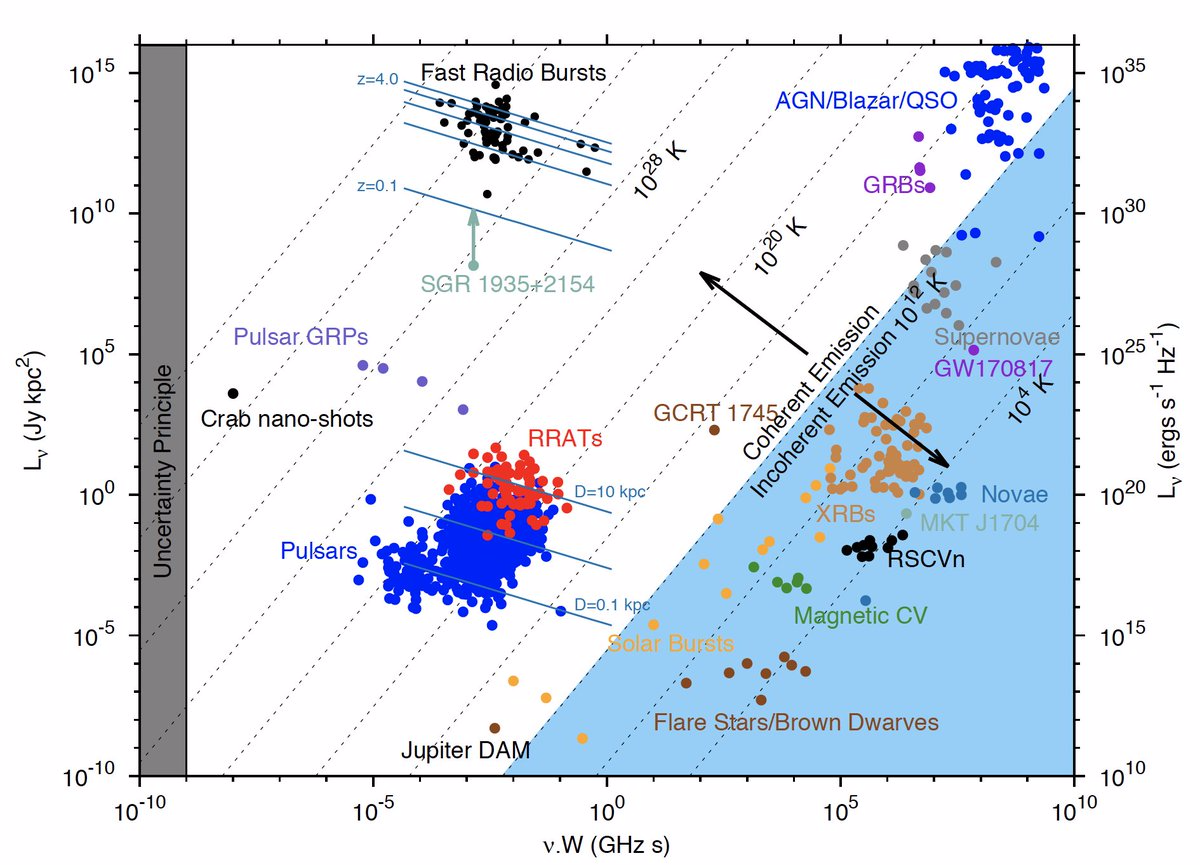
from https://twitter.com/evanocathain/status/1255540882658537473/photo/1
4.2 STARE2也看到这个FRB http://www.astronomerstelegram.org/?read=13684
他们是在1.4GHz灵敏,DM 333.2 +/- 0.8 pc cm^-3,流量:>1.5 MJy ms,比CHIME看到的高了三个量级!
We report the detection of a burst on 4/28/2020 at UTC 14:34:25 at all three stations with dispersion measure of 333.2 +/- 0.8 pc cm^-3, and preliminary inferred fluence of >1.5 MJy ms. The arrival time and the dispersion measure of this burst are consistent with those reported in ATel #13681, although we report a 1000x higher fluence than the CHIME telescope.
射电的天空依然是太阳最亮,The brightest discrete radio source is the Sun, but it is much less dominant than it is in visible light. ( https://www.cv.nrao.edu/course/astr534/Tour.html )一般是1e4Jy,活动的时候是几百倍( https://en.wikipedia.org/wiki/Jansky );而这个超过了1e6Jy。所以可以说和太阳一样亮。
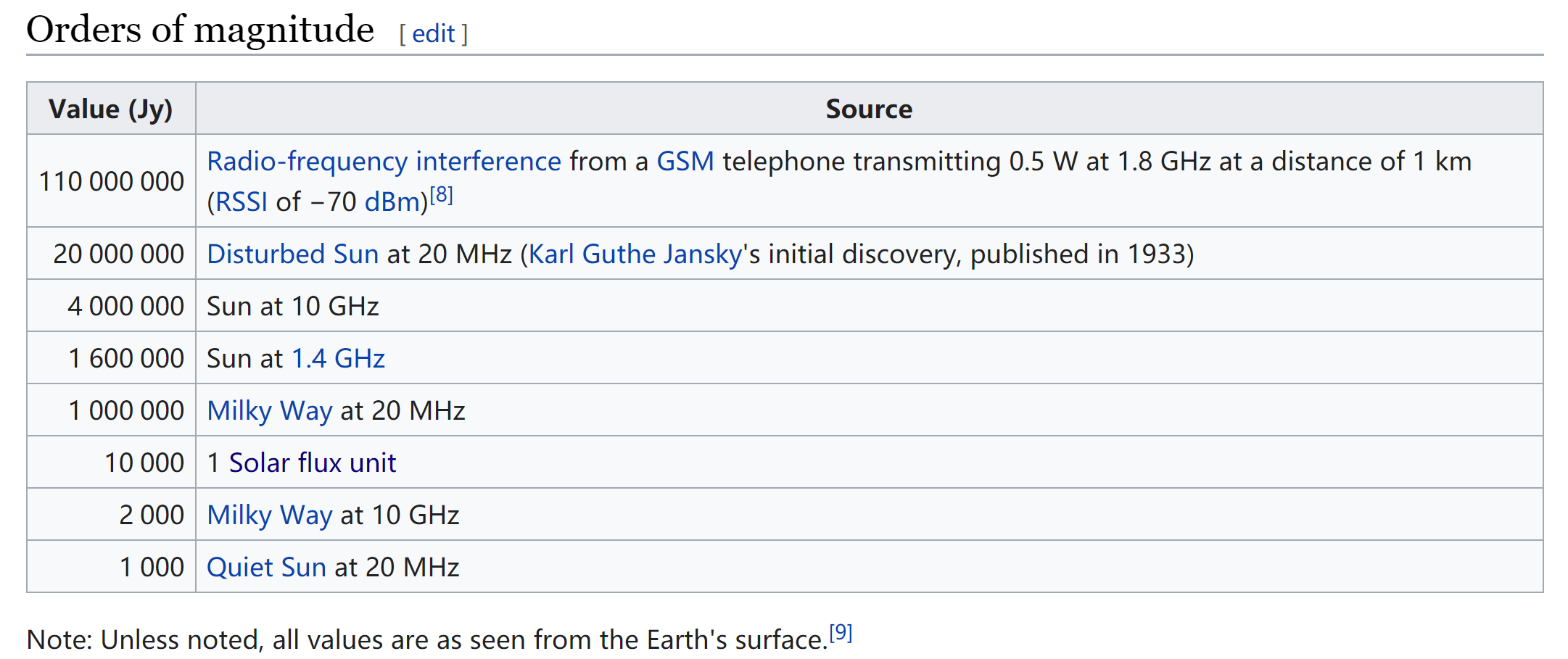
4.2.5 FAST也看到了一个弱的FRB http://www.astronomerstelegram.org/?read=13699
时间更晚些 MJD 58969.9048669008 (4.30日)The estimated flux is 30 mJy and fluence is 60 mJy ms. 比CHIME看到的弱了四个量级;而STARE2看到的又比CHIME的强三个量级。关键是FAST只是看了一个小时(started at 21:18:00 UTC and stopped at to 22:20:00 on 30th April 2020.)就看到一个,说明现在的FRB很频繁。
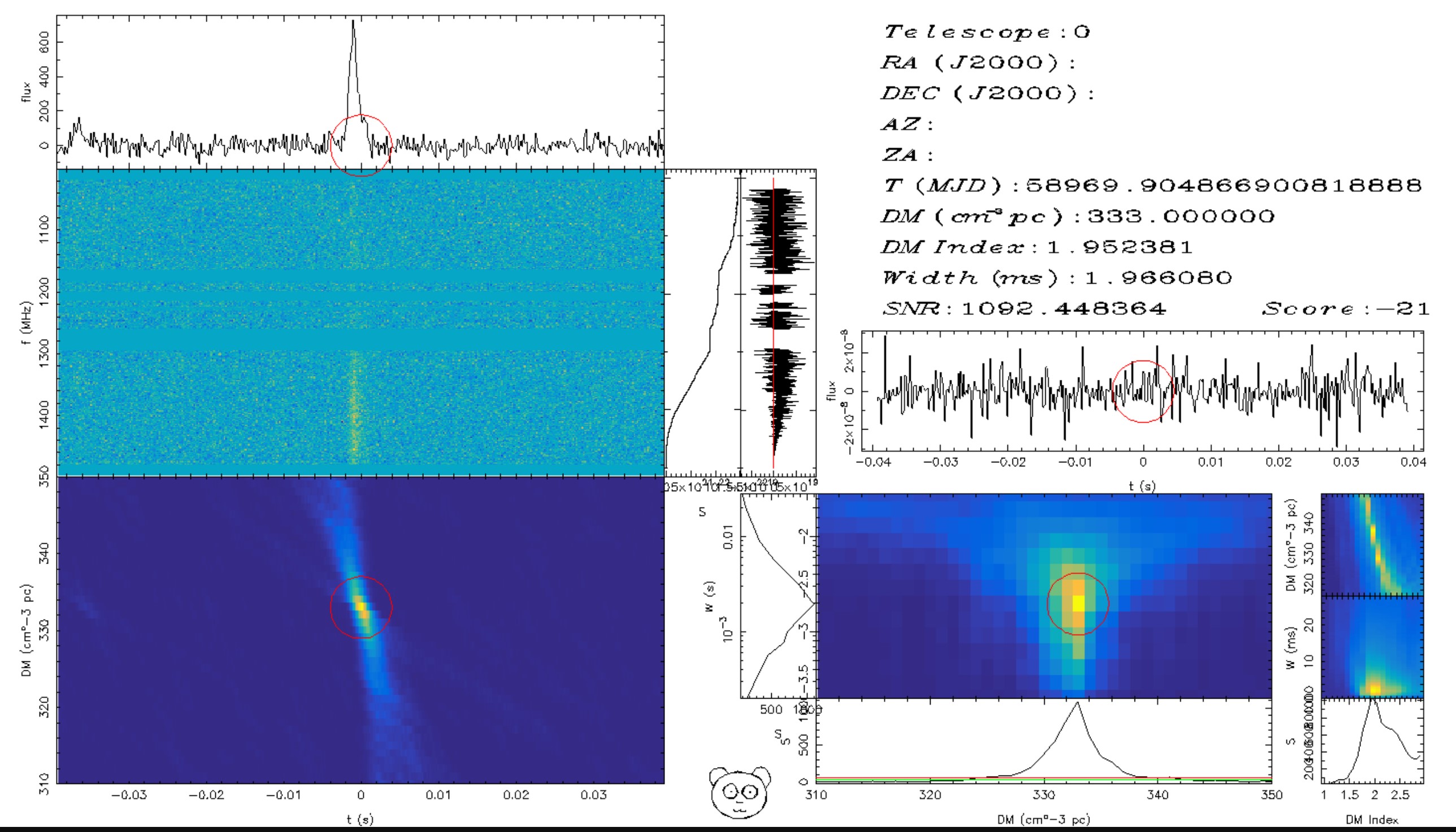
但是这个没有X-ray, HXMT给了上限的 http://www.astronomerstelegram.org/?read=13703 说明至少X-ray弱。说明X-ray和radio之间的相关性。
4.3 INTEGRAL看到的,
14:34:24 UT of April 28(时间没做校准,可能相差几秒),时标0.3s https://gcn.gsfc.nasa.gov/gcn3/27667.gcn3
A preliminary analysis indicates that the burst had a duration of about 0.3 s, a fluence of 3.9+/-0.2e-7 erg/cm2 in the 25-80 keV range and a peak flux of 1.2+/-0.1 e-6 erg/cm2/s on 10 ms timescale.
The burst was also marginally detected in the SPI-ACS with S/N=4.65 on a 0.65s time scale. The ACS observation independently gives a FAP at the level of 0.0019 (2.9 sigma).
We note that another weaker burst from SGR 1935+2154, lasting about 0.1 s was detected by IBAS at 09:51:05 UT of April 28 (Weak Alert Packet n. 8610).
ISGRI and SPI-ACS lightcurves of the bright event are available at:
https://www.isdc.unige.ch/integral/ibas/cgi-bin/ibas_acs_web.cgi/?trigger=2020-04-28T14-34-23.4100-00000-00000-0
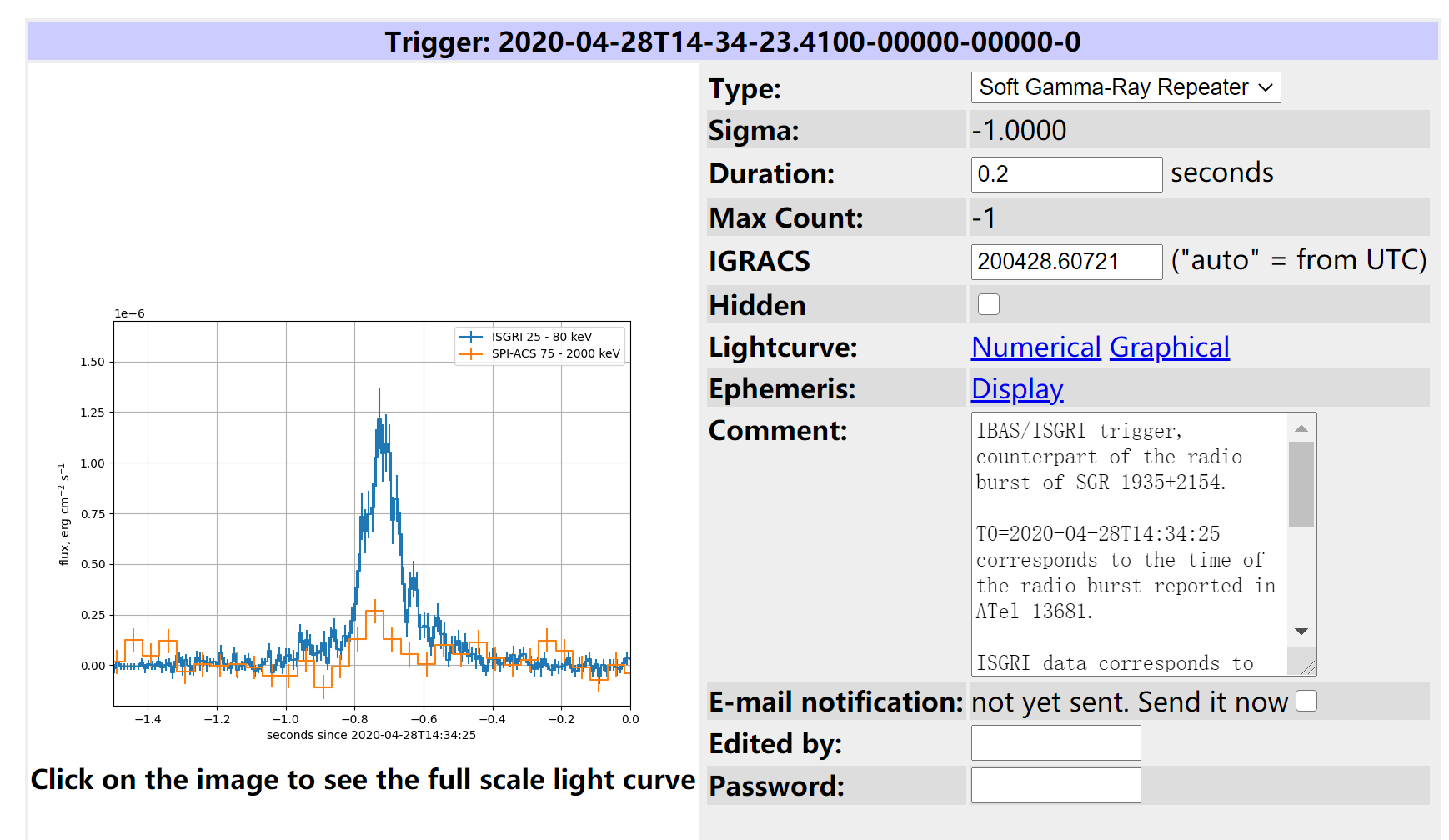
他们在ATel上也放了,http://www.astronomerstelegram.org/?read=13685
甚至很快都把观测文章放出来了(2020年5月14日):
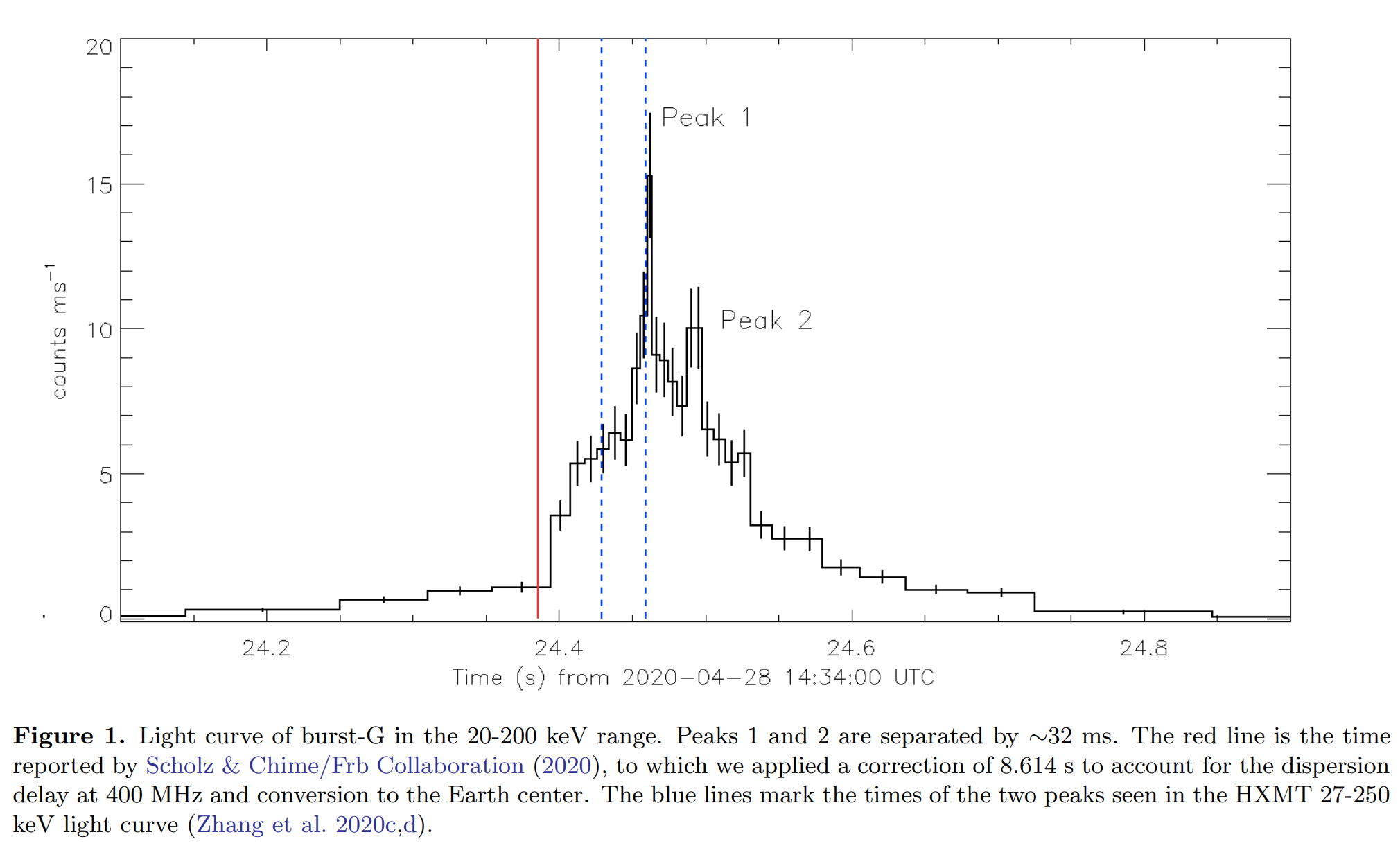
arXiv:2005.06335 INTEGRAL discovery of a burst with associated radio emission from the magnetar SGR 1935+2154
S. Mereghetti, et al https://arxiv.org/abs/2005.06335
这段时间也有好多暴
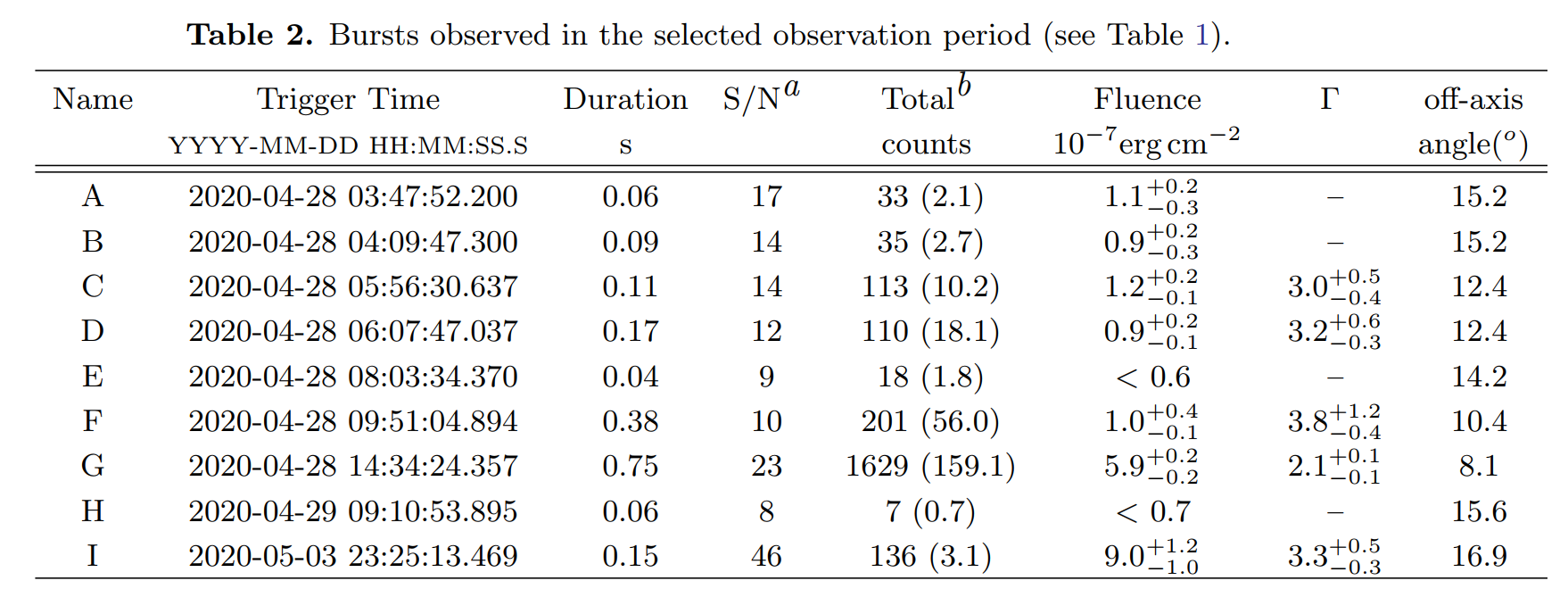
可以看到14:34的时候是最亮的一个。
4.4 Konus-WIND的观测,
UT (14:34:24.084) on 2020 April 28,0.5s,Ep = 82(-9,+12) keV https://gcn.gsfc.nasa.gov/gcn3/27669.gcn3
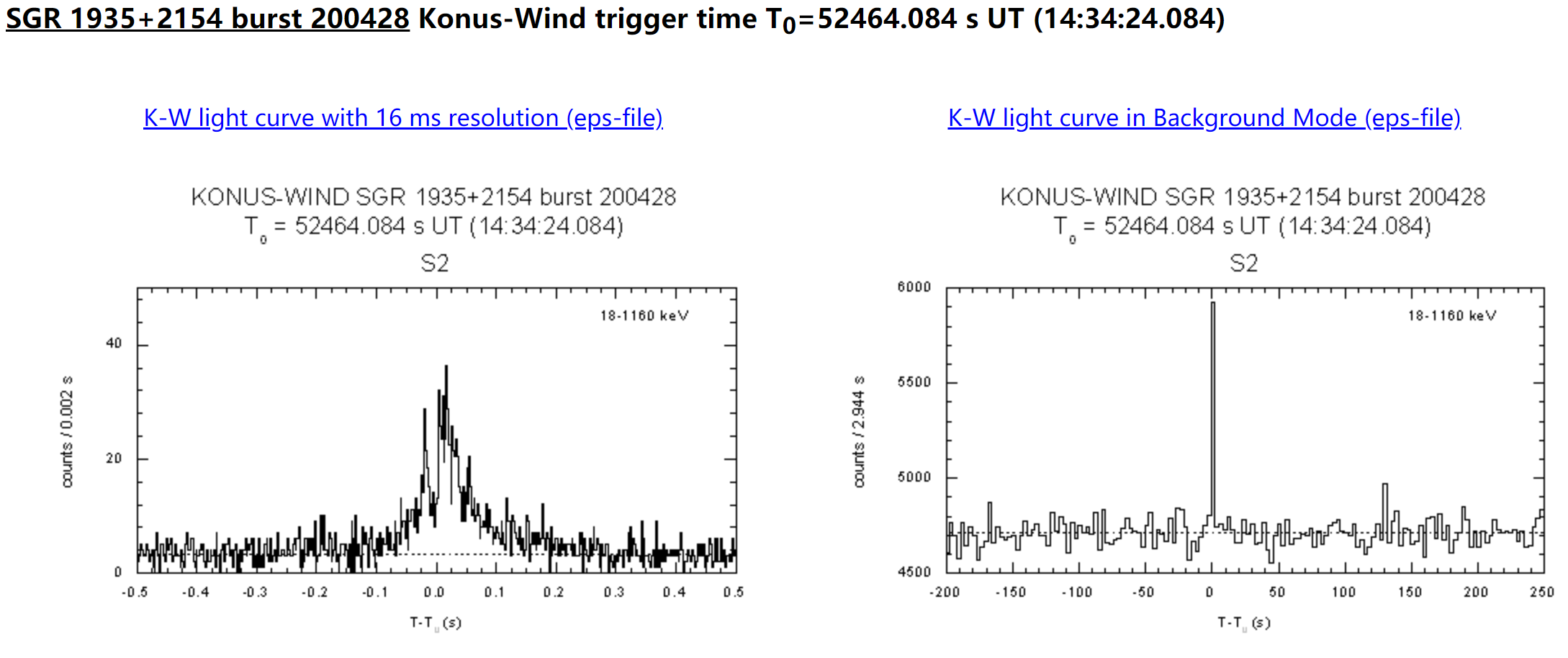
4.5 Insight-HXMT也观测到了,数据非常好
https://gcn.gsfc.nasa.gov/gcn3/27675.gcn3
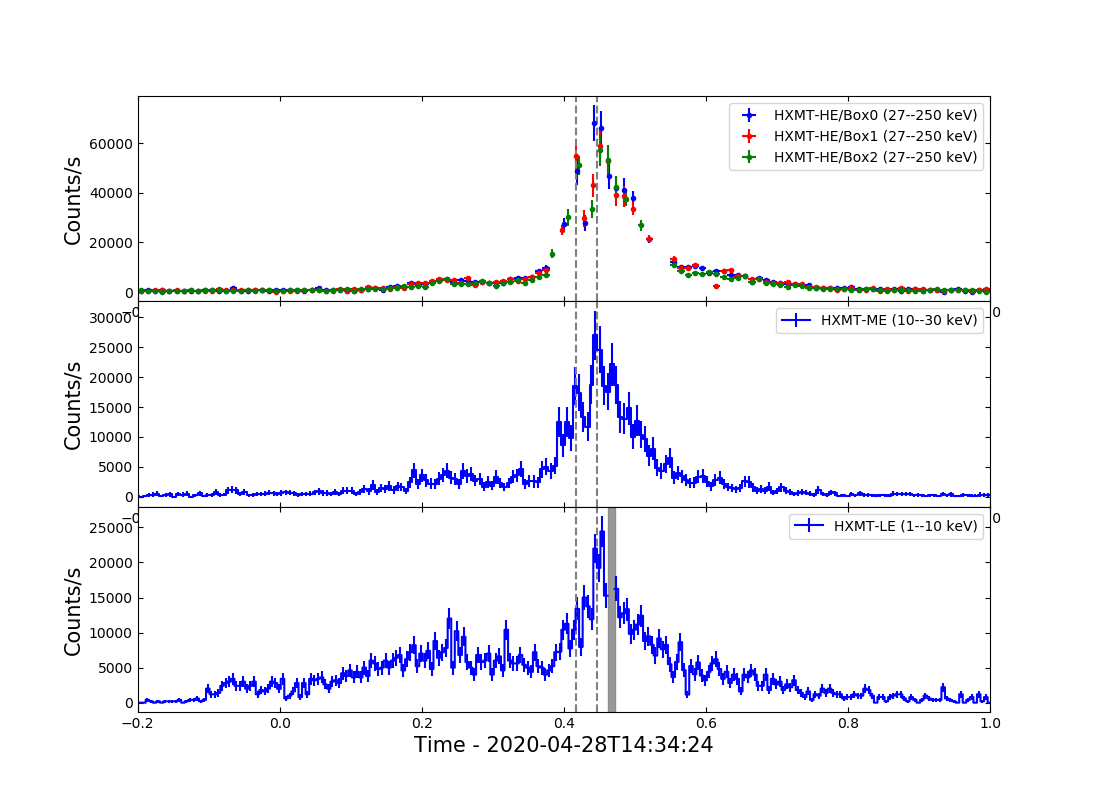
In HE and ME, there are two narrow peaks (14:34:24.4175 UT and 14:34:24.4475 UT) riding on the second major bump. In LE, these two narrow peaks are also visible, although the first peak is rather weak. Considering that the separation time between these two narrow peaks (~30 ms) is almost the same as that of the radio ones (~30 ms, Atel #13681), and that the apparent time lag between these two peaks and radio peaks (~8.6 s) is in perfect agreement with the calculated dispersion (8.63 s) between X-ray and radio using the measured DM (332.81 pc/cc) by CHIME/FRB (Atel #13681), we suggest that these two peaks are very likely the X-ray and hard X-ray counterparts of the double-peaked radio burst reported by CHIME/FRB (Atel #13681).
说时间上刚刚好,有个8.6s的lag,是DM导致的X射线和FRB的lag。http://www.astronomerstelegram.org/?read=13704 做了11ms的修正,是望远镜的位置和地球的位置差导致的。
不过他们在ATel上说可能还有intrinsic的delay: but nevertheless by about 4-5 seconds more, suggesting a possible intrinsic delay of the radio bursts with respect to the X-ray burst. http://www.astronomerstelegram.org/?read=13687
然后更正了,说没有: http://www.astronomerstelegram.org/?read=13692
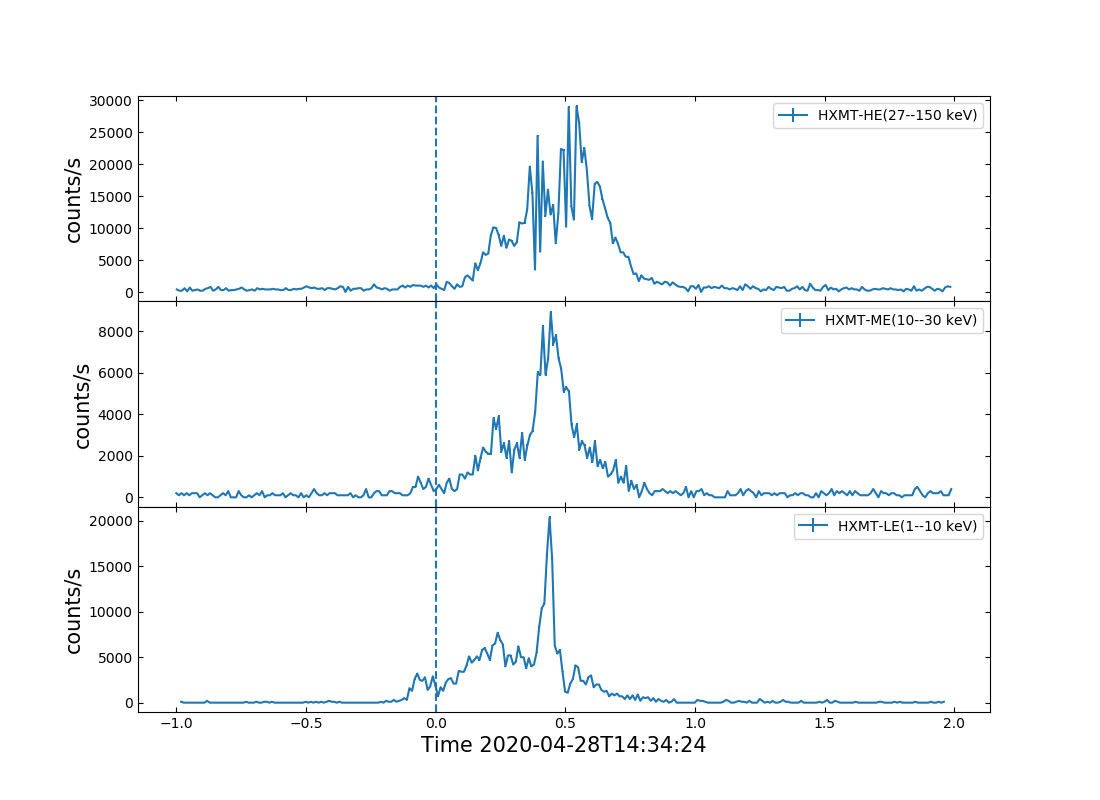
而且ATel上的图也不完全一样。原因是这是初步的,在他们后续的ATel里改成上和GCN一样的图: http://www.astronomerstelegram.org/?read=13696 而且也没提那个4-5s的delay了。
4.6 AGILE也看到了,
http://www.astronomerstelegram.org/?read=13686
T = 2020-04-28 14:34:24 UTC,比CHIME的T0 = 2020-04-28 14:34:33 UTC提前了刚好9s的样子,和HXMT一致。
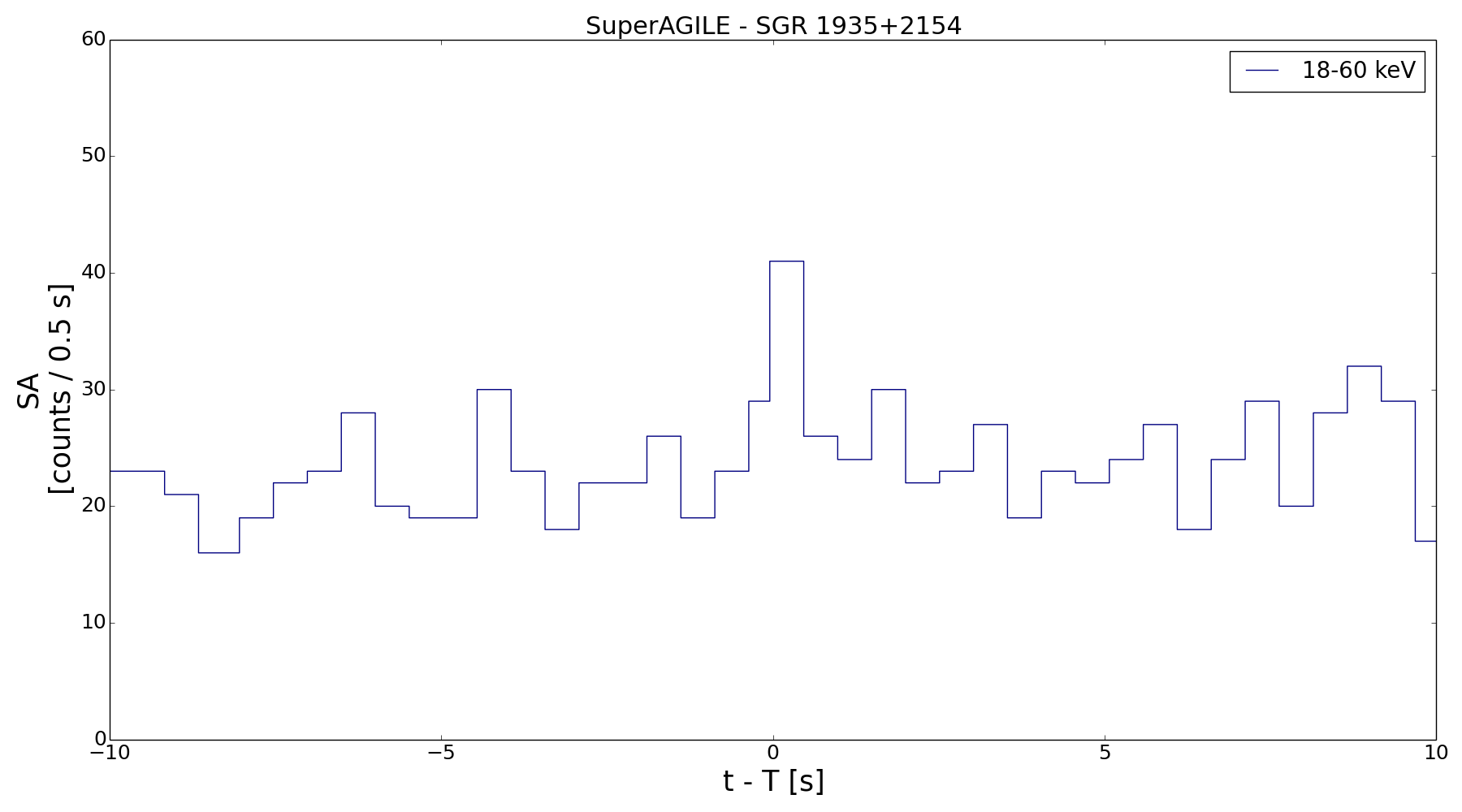
5 爆发前后的其它观测
5.1 伽玛射线波段
5.1.1 AGILE看到了burst forest
http://www.astronomerstelegram.org/?read=13682
只到28号0点,所以还没到FRB开始的时候
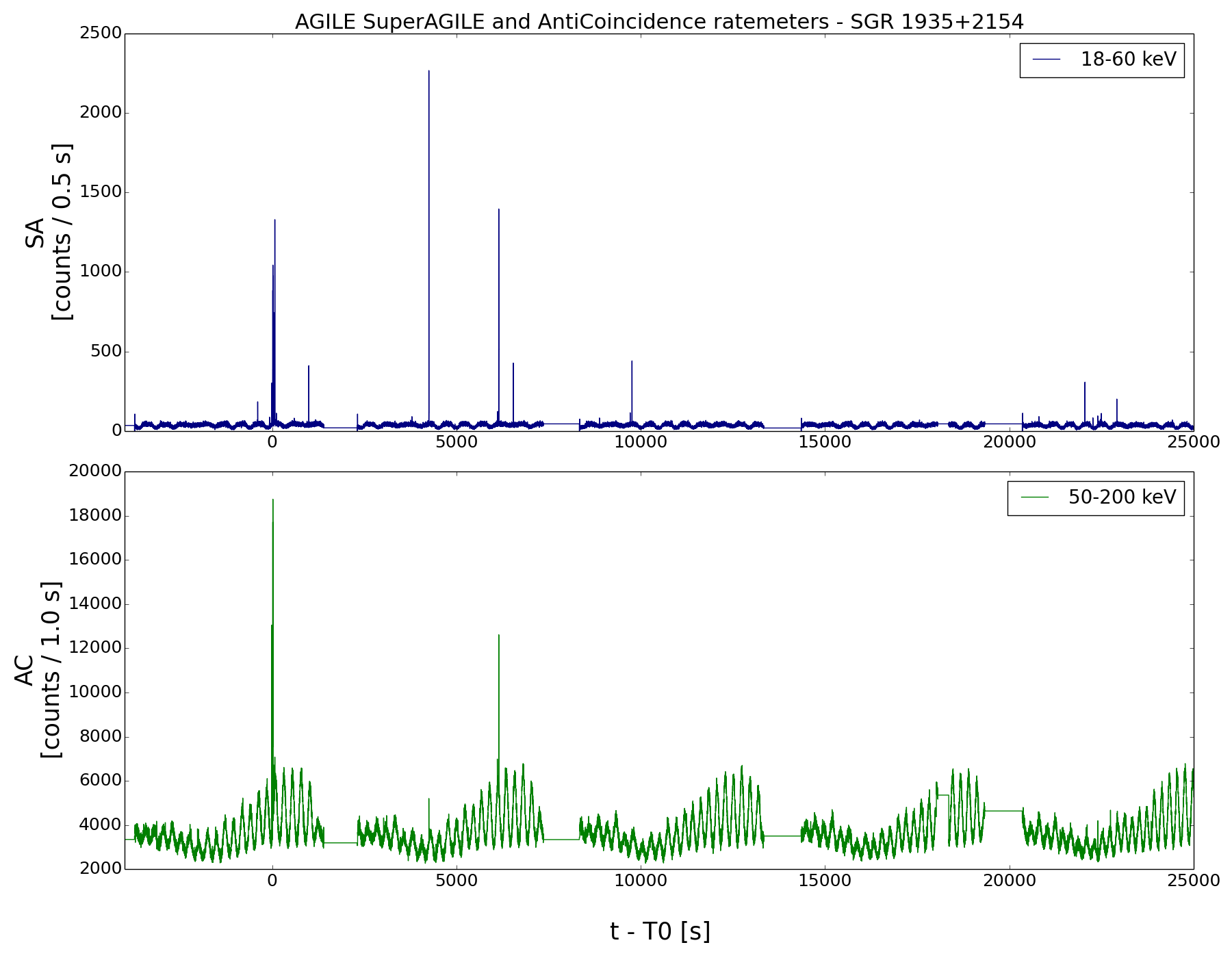
但是他们The MiniCalorimeter detector (0.4-100 MeV)什么都没看到。说明谱很软。
5.1.2 Konus-Wind在5.10看到了一个伽玛暴
https://gcn.gsfc.nasa.gov/gcn3/27715.gcn3
其它的某些伽玛射线探测器也看到了的
at 22322.624 s UT (06:12:02.624) and 78677.28 s UT (21:51:17.280) on 2020 May 10.
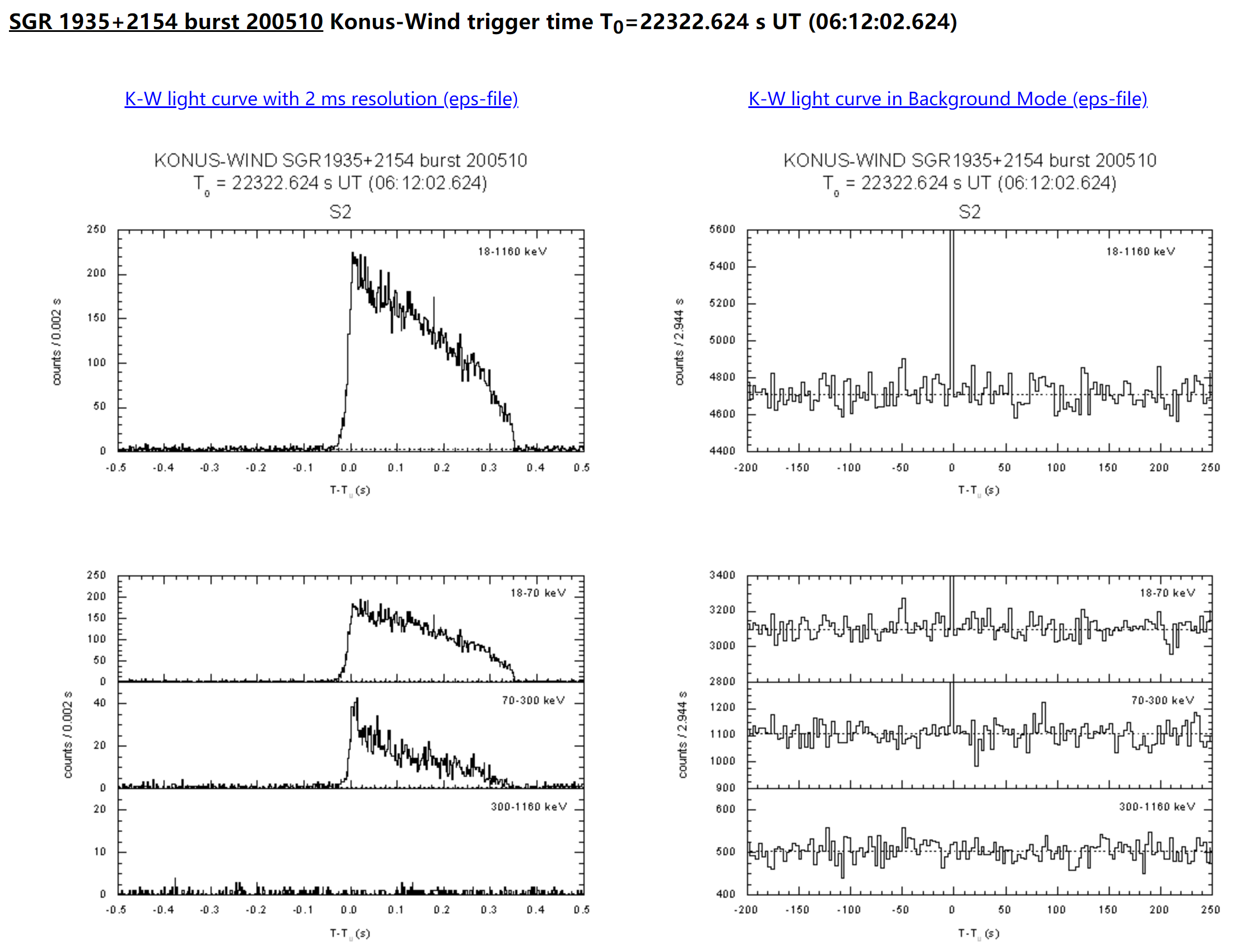
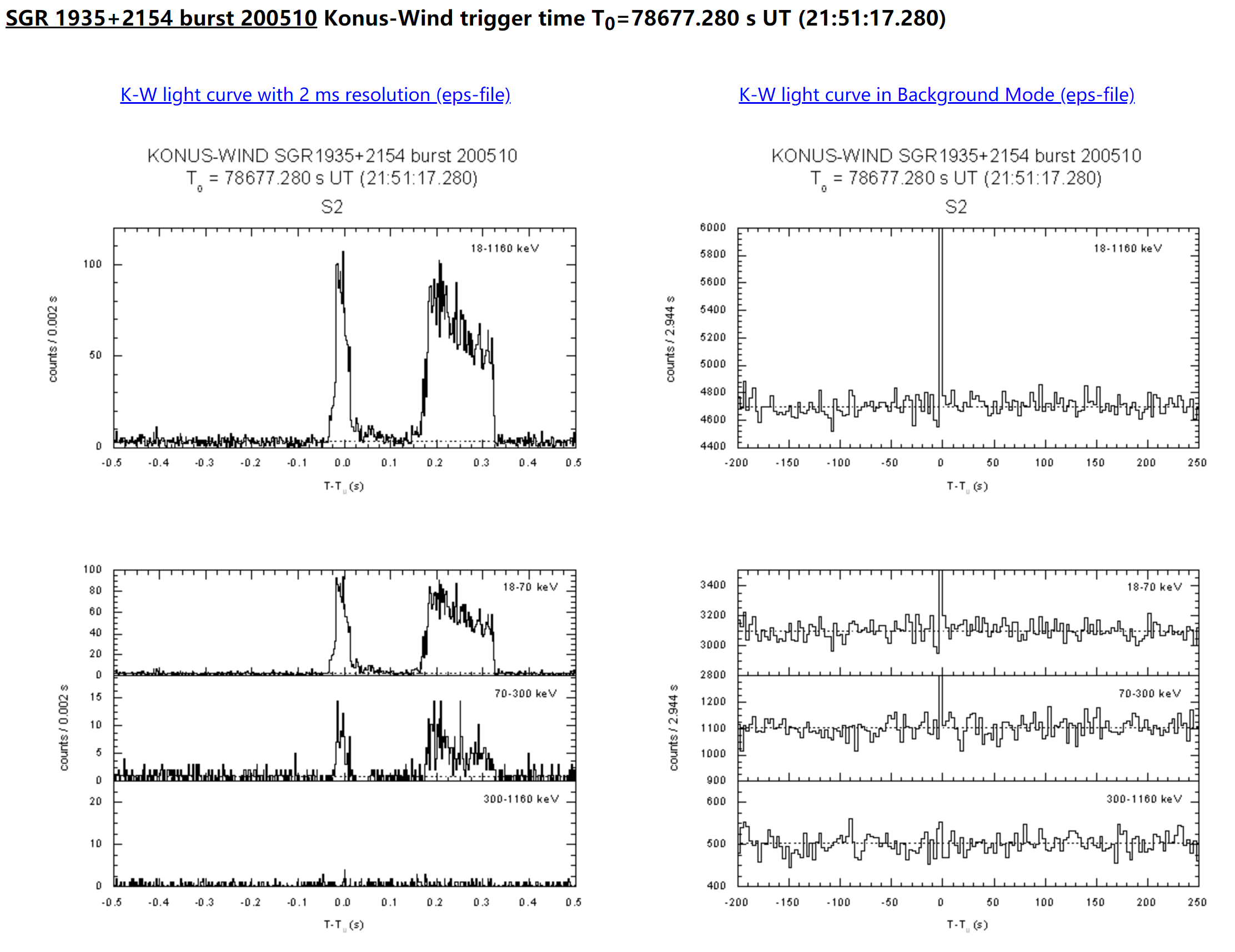
5.2 X-ray波段
5.2.1 NICER看到了它的大量的暴
http://www.astronomerstelegram.org/?read=13678
开始时间 00:40:58.000 UTC of 2020-04-28 UTC and lasted approximately 1 ks.
看到了超过100个爆发。最亮的在00:46:21.2 UTC (不是FRB的时间), a 4 ms peak flux for this burst of about 2.7e-6 erg/s/cm2 (1 - 9 keV)
用这些数据计算的NH是:(4.10 +/- 0.17)e22 /cm2,和4.1引用的“1.6e22 cm^-2”相差二倍的样子。(这会导致DM的差异的)
4ms bin的光变
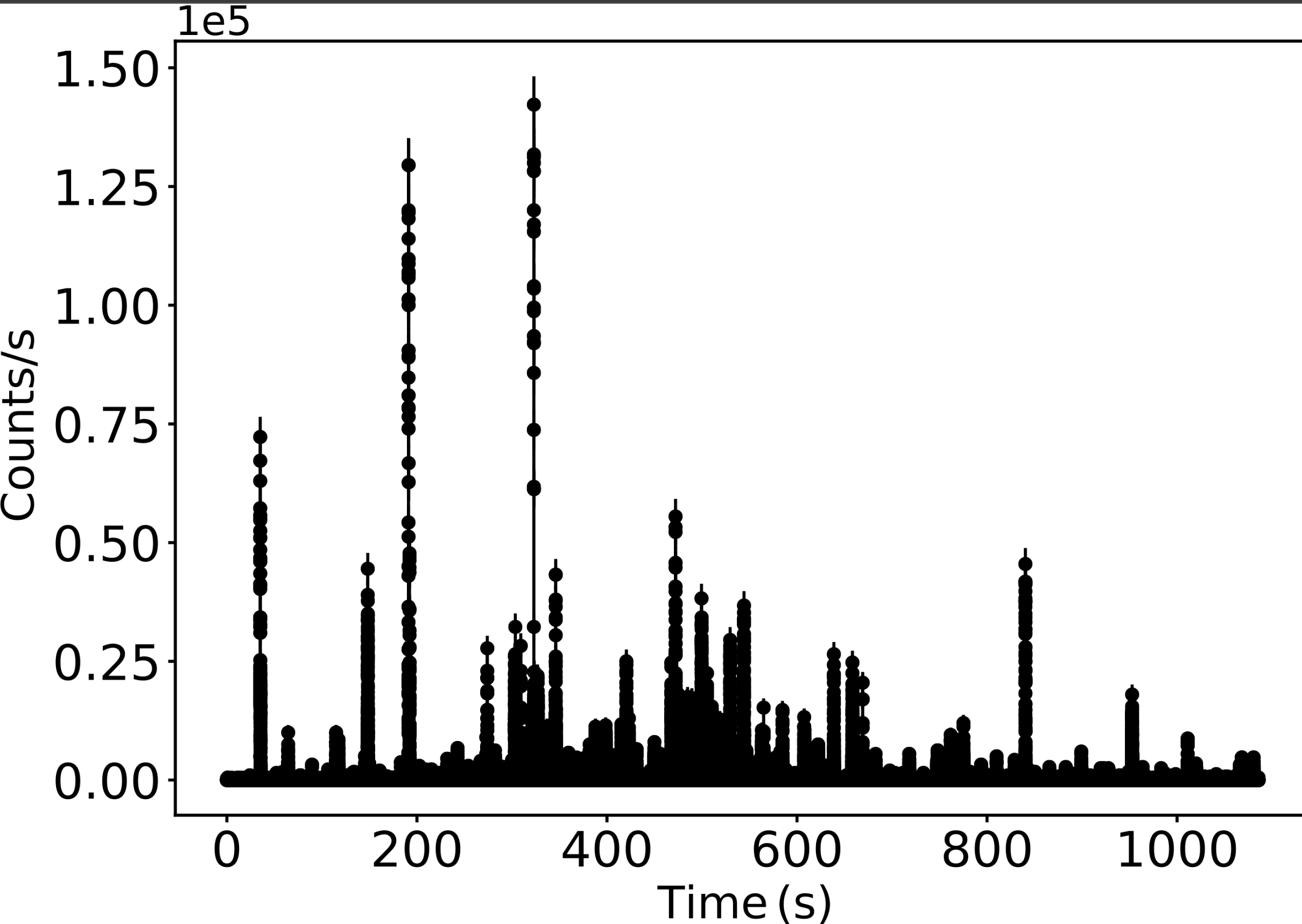
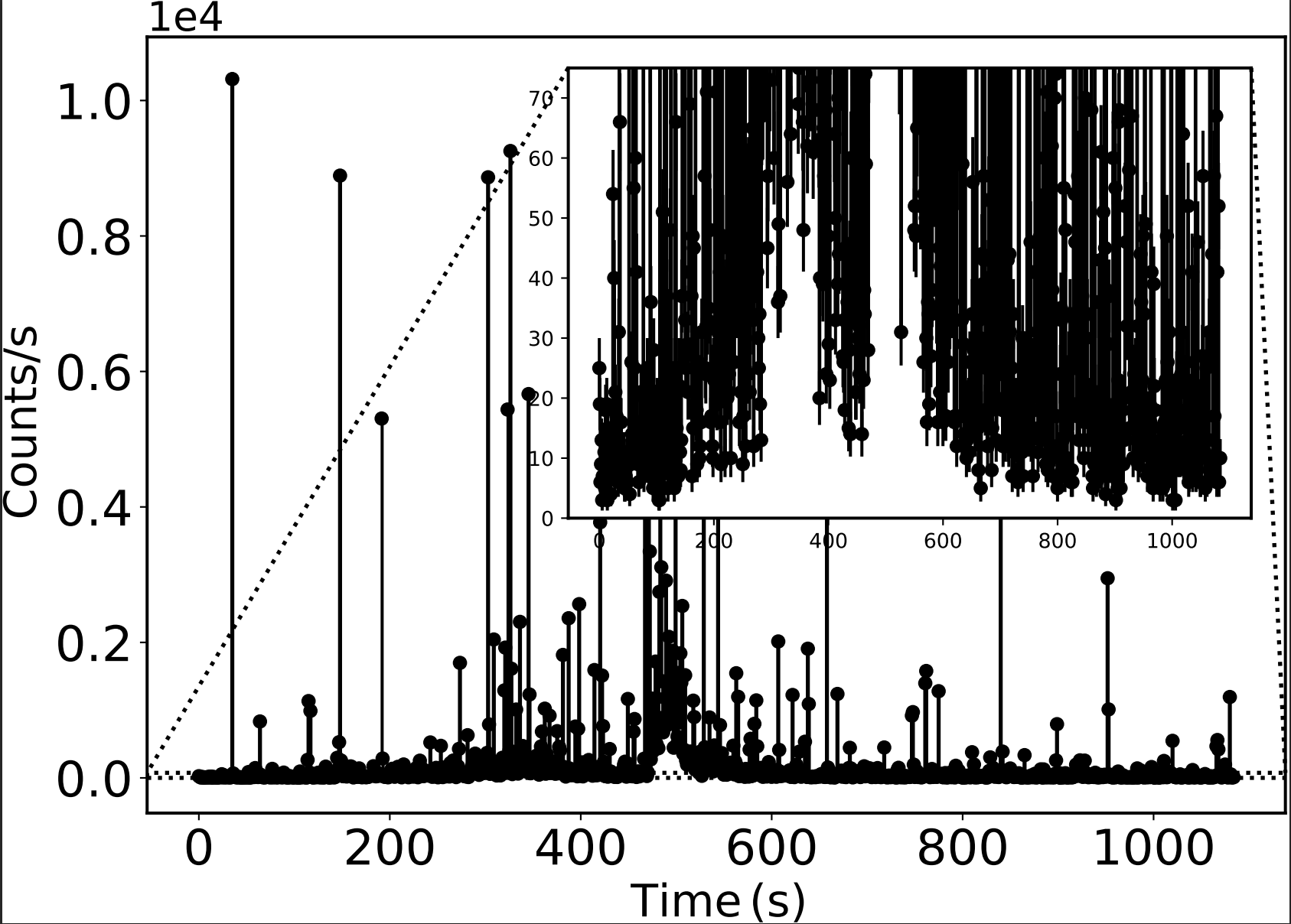
1s的bin,下面小图是把最亮的去掉之后看(注意纵坐标的单位)
5.2.2 Swift/XRT也看到了几个暴
http://www.astronomerstelegram.org/?read=13679
时间 beginning at 19:41 UT on April 27th, 2020,看了2ks,也许是时间精度没有NICER那么高,或者灵敏度不够,没有看到那种大量的暴。
但说看到了X-ray的dust scattered halo。
通过谱拟合的NH是: an absorption of 2.66 +/- 0.44 x 10^22 cm^-2 在前面的二者之间。
5.2.3 AGILE在5.3日又看到一个
The AGILE satellite detected a short hard X-ray burst at T0 = 2020-05-03 23:25:13.50 (UT). https://gcn.gsfc.nasa.gov/gcn3/27687.gcn3
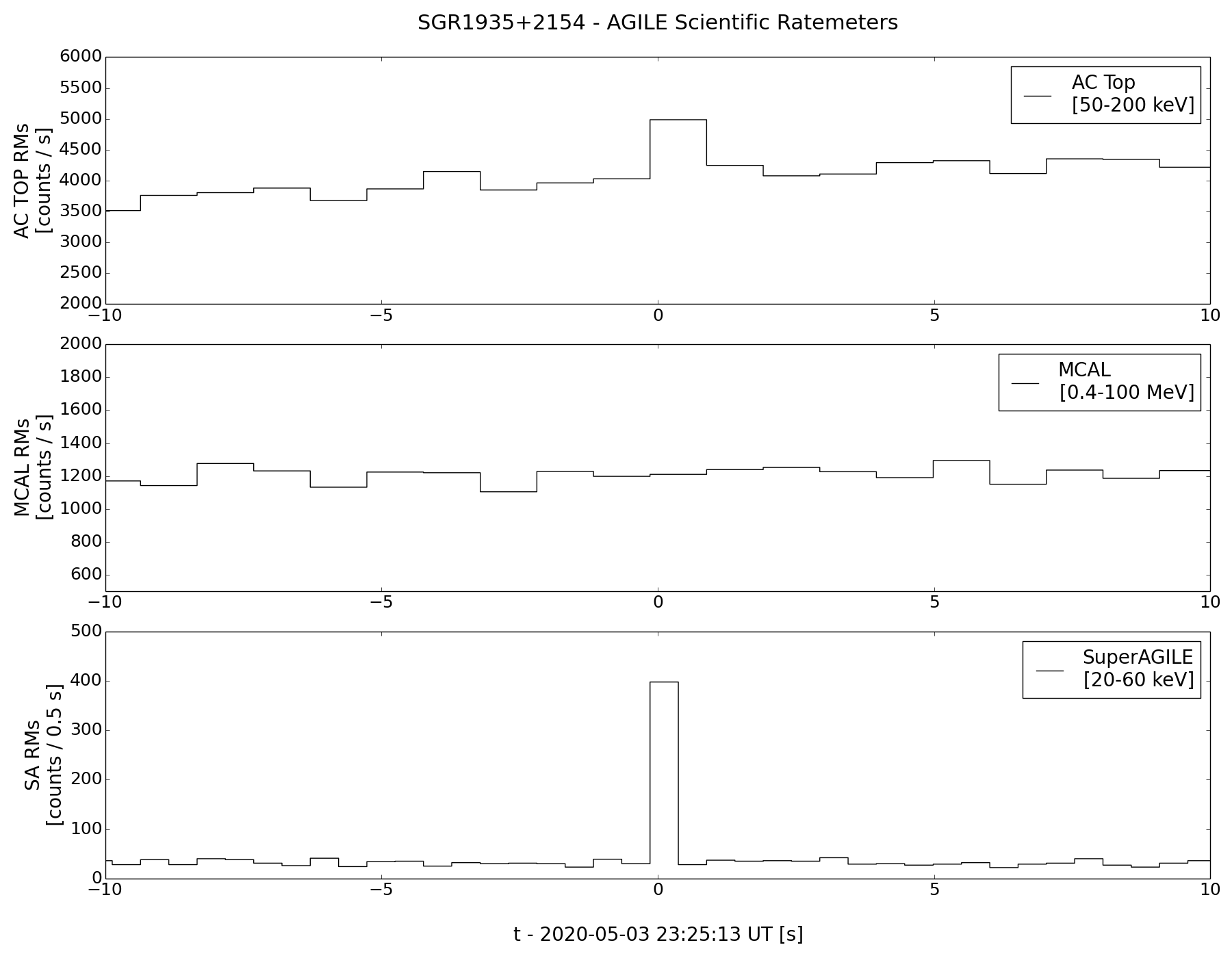
5.2.4 HXMT又看到一个,和AGILE、Fermi同时; 而且这段时期看到了很多
During the ToO observation to SGR 1935+2154, Insight-HXMT/HE detected a short (~0.2 s) and bright burst at 2020-05-03 23:25:13.4 UT (satellite time), which was also detected by Fermi/GBM (trigNum 610241118) and AGILE (GCN #27687). https://gcn.gsfc.nasa.gov/gcn3/27688.gcn3
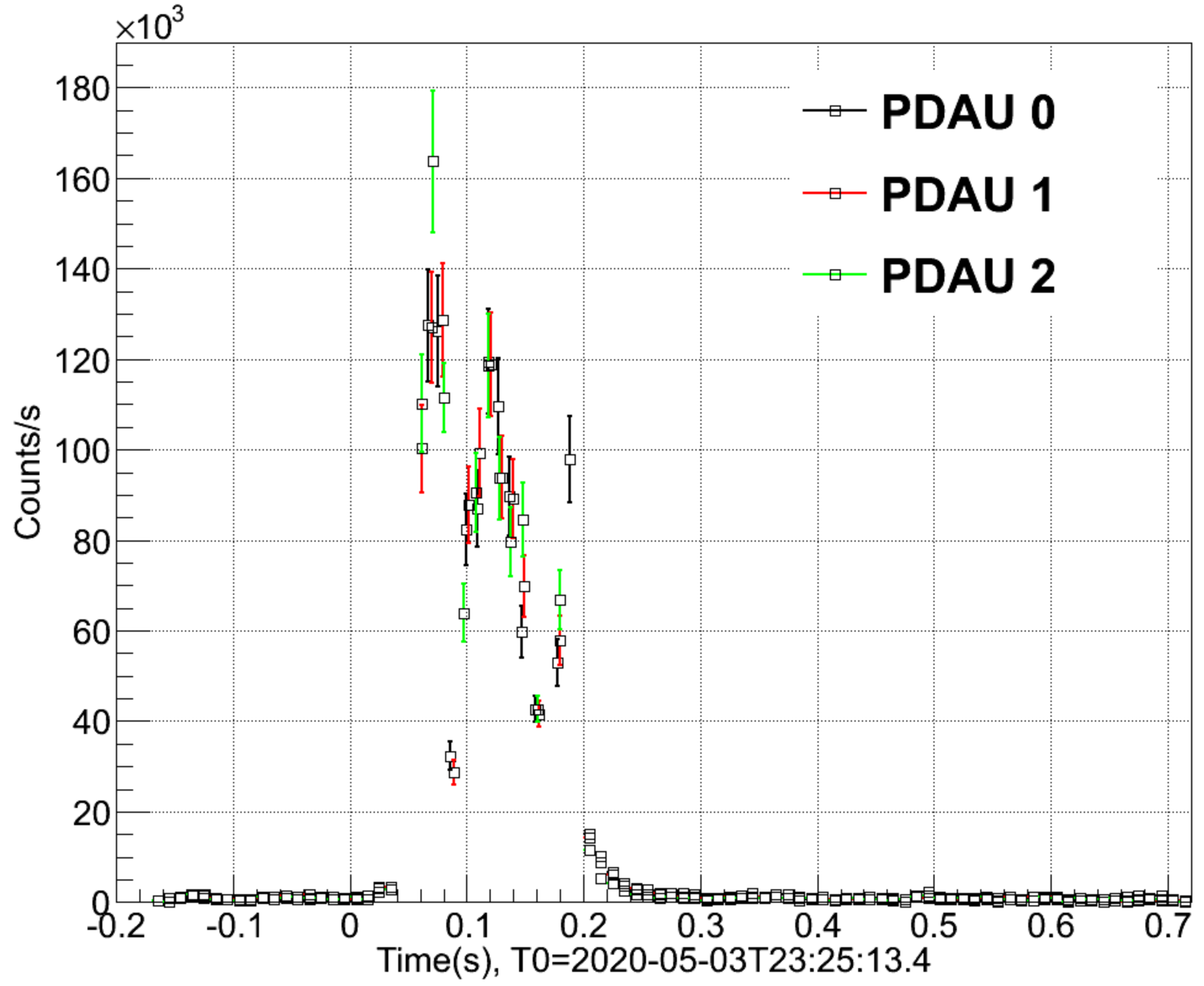
Fermi/GBM (trigNum 610241118) 这个没发GCN或者ATel。
看到很多的见这个ATel http://www.astronomerstelegram.org/?read=13729
Since 2020-04-28 07:14:51 UTC, Insight/HXMT has been observing SGR J1935+2154 under a public ToO. The current plan is to continue this public ToO until the end of May. An extended observation after May is probable if this SGR is still in active phase.
数据也开放了。这里有个看到的每次时间的记录: http://enghxmt.ihep.ac.cn/bfy/331.jhtml
5.2.5 NuSTAR, NICER and Swift监视
http://www.astronomerstelegram.org/?read=13720
貌似没看到X-ray flare,但看到了X射线脉冲星,而且还和它平时不一样了,从单峰变成了双峰。
The NuSTAR observation was performed on 2020 May 2, and the NICER pointing was acquired on 2020 April 29-30. We are planning further observations with both satellites in the coming weeks.
P = 3.247331(3) s
5.2.6 SRG 四天前扫过了哪里,没看到什么
observations of SGR 1935+2154: four days prior to the FRB event
http://www.astronomerstelegram.org/?read=13723
连3.2s的X射线脉冲星都没看到。
5.3 光学波段
5.3.1 MASTER-Amur robotic telescope没看到,给出了极限星等。
31716 sec after notice time and 31743 sec after trigger time at 2020-04-10 18:32:57 UT, with upper limit up to 17.3 mag. https://gcn.gsfc.nasa.gov/gcn3/27529.gcn3
5.3.2 MASTER Global Robotic 跟踪了4.27号的,
2020-04-27 21:57:38UT (3.5h after Swift trigger) https://gcn.gsfc.nasa.gov/gcn3/27670.gcn3 GCN中给了数据的地址
5.3.3 Tomo-e Gozen camera也没看到
7 hrs (3.5 hrs starting UTC 2020-04-30 15:28 + 3.5 hrs starting UTC 2020-05-01 15:28) using the Tomo-e Gozen camera (optical CMOS imager, Sako et al. 2018, SPIE, 10702, 107020J) mounted on the 105-cm Kiso Schmidt telescope. https://gcn.gsfc.nasa.gov/gcn3/27678.gcn3
5.4 射电波段
5.4.1 VLA什么都没看到
http://www.astronomerstelegram.org/?read=13690
时间 2020 Apr 29 17:40 UTC;Wideband data were obtained at center frequencies of 6 GHz (C-band) and 22 GHz (K-band) with the VLA in its C configuration. The image rms noise levels at the position of SGR 1935+2154 were 15 uJy and 18 uJy in the C- and K-band observations respectively.
给了persistent radio的上限: No persistent radio source was detected at the position of SGR 1935+2154, with preliminary 3sigma upper limits of 45 uJy and 54 uJy
然后4.30号又找了 2020 Apr 30 14:34 UTC,也还是没有。 http://www.astronomerstelegram.org/?read=13693
5.4.2 FAST也没看到
http://www.astronomerstelegram.org/?read=13697
No burst was detected during a 8-hour observational campaign toward SGR J1935+2154 by FAST. Despite 29 SGR bursts detected by Fermi GBM in the time span, stringent upper limits on radio emission associated with these SGR bursts are obtained.
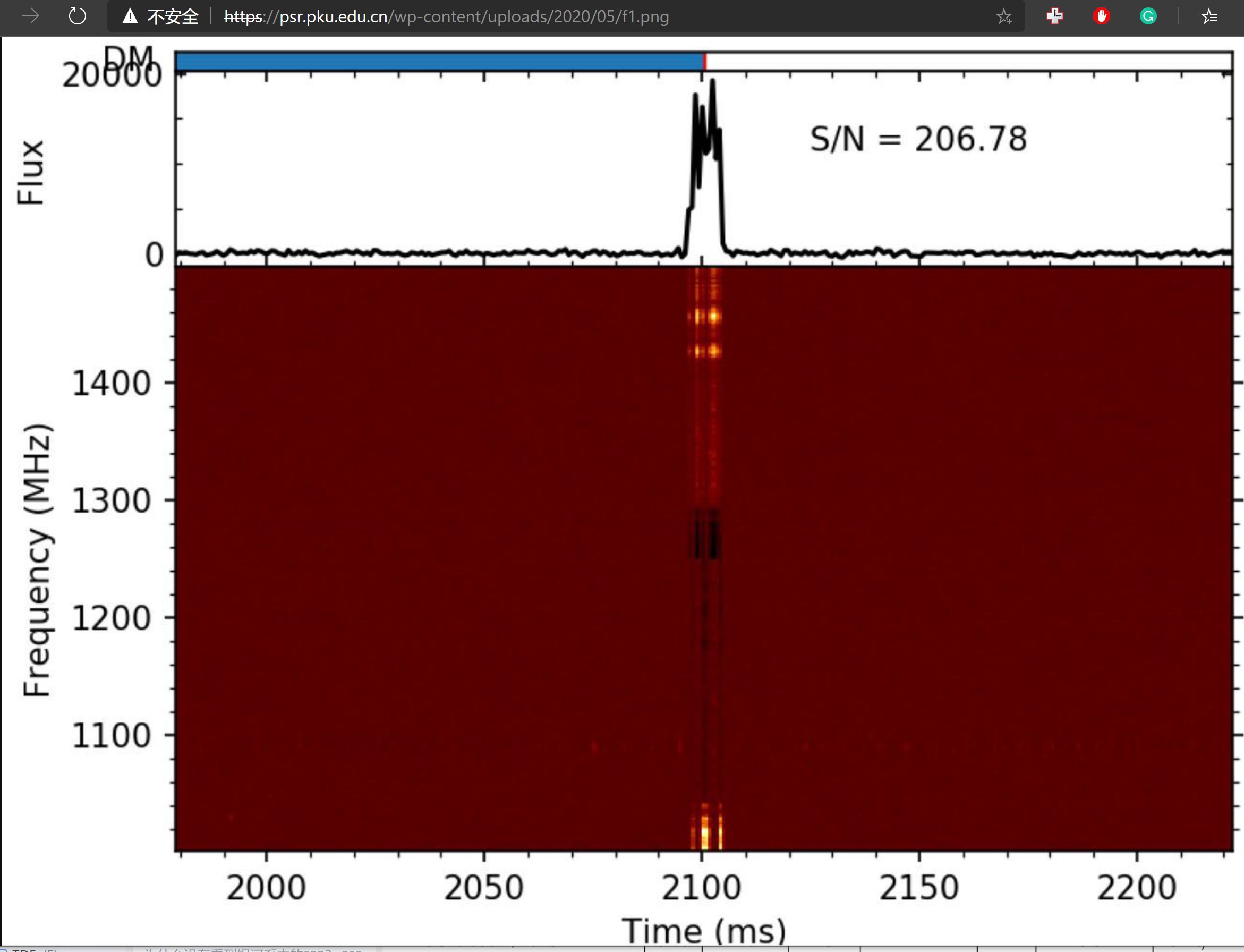
没看懂这个图的意思,明明像是看到了什么东西。
QQ群里李兵回复:您看那图的上面有个Flux和DM。他的意思是看到一个DM2000多的,但是没看到DM330多的,而且FAST不是定点观测,所以说他们觉得没看到来自于该暴的射电信号,但后期还有更多的协同观测。
所以这个不是1935+2154所对应的FRB,而是另一个DM 2000多的源。那这个是不是另外一个FRB? 应该是这个:“中国“天眼”发现新快速射电暴 来自85亿年前宇宙深处” http://www.chinanews.com/gn/2020/05-08/9178498.shtml
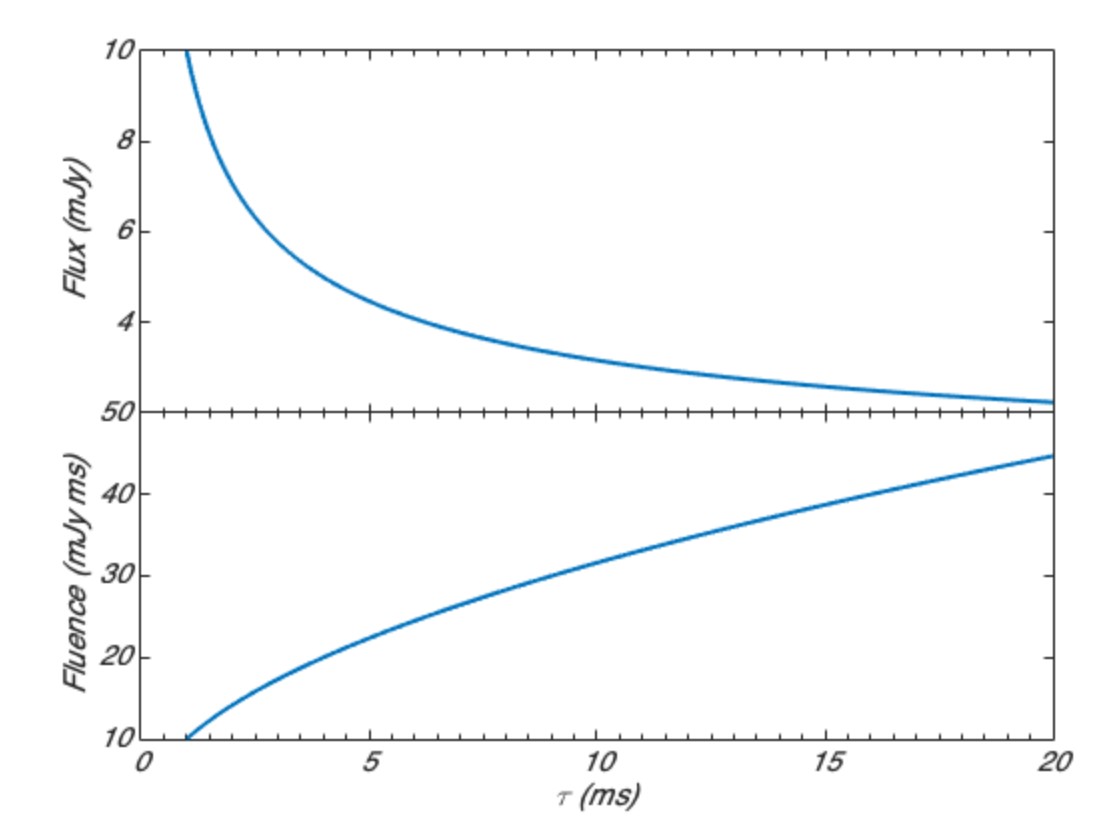
上限。
5.4.3 LOFAR也没找到
http://www.astronomerstelegram.org/?read=13707
2020 April 30, 03:30UTC找了两个小时,没有。不过看到了旁边millisecond pulsar B1937+21的一些giant pulse。所以giant pulse就这么频繁吗。
5.4.4 DSN也没找到FRB,并且也找了射电脉冲星,也没找到
http://www.astronomerstelegram.org/?read=13713
望远镜: Deep Space Network (DSN) 34 m diameter radio telescopes (DSS-55 and DSS-54) in Madrid, Spain at center frequencies of 2.3 GHz (S-band) and 8.4 GHz (X-band).;
三个时间段:Epoch 1 (start time: 2020 April 29, 22:54:25 UTC; duration: 9159 s), Epoch 2 (start time: 2020 April 30, 22:53:09 UTC; duration: 11063 s), and Epoch 3 (start time: 2020 May 1, 23:55:01 UTC, duration: 3420 s).
5.4.5 Aricibo在20191007的历史数据里也没有FRB
http://www.astronomerstelegram.org/?read=13726
The first observation was on 2019-10-07 23:32:43.0 UTC for 0.35 hours at 1.4 GHz and 0.31 hours at 4.5 GHz. The second observation was on 2019-10-17 21:22:38.0 UTC for 0.81 hours at 1.4 GHz, 0.75 hours at 4.5 GHz, and 0.36 hours at 327 MHz.
但10-04是有GBM看到耀发了的 http://gcn.gsfc.nasa.gov/gcn/gcn3/25975.gcn3
而且如果有,他们的灵敏度是够的“Our observations had the sensitivity to detect bursts such as the one recently reported by FAST (ATel #13699).”
5.5 高能宇宙线、中微子
5.5.1 IceCube说看到了一个中微子
http://www.astronomerstelegram.org/?read=13689
时间 2020-04-27 19:23:30.9 UTC
is found in spatial coincidence with SGR 1935+2154 during this time period. We find that these data are consistent with atmospheric background expectations, with a p-value of 0.033.
5.5.2 ANTARES说没看到
http://www.astronomerstelegram.org/?read=13721
No up-going muon neutrino candidate events were recorded at the location of the source.
6. 关于SGR 1935+2154
6.1 基本参数
6.1.1
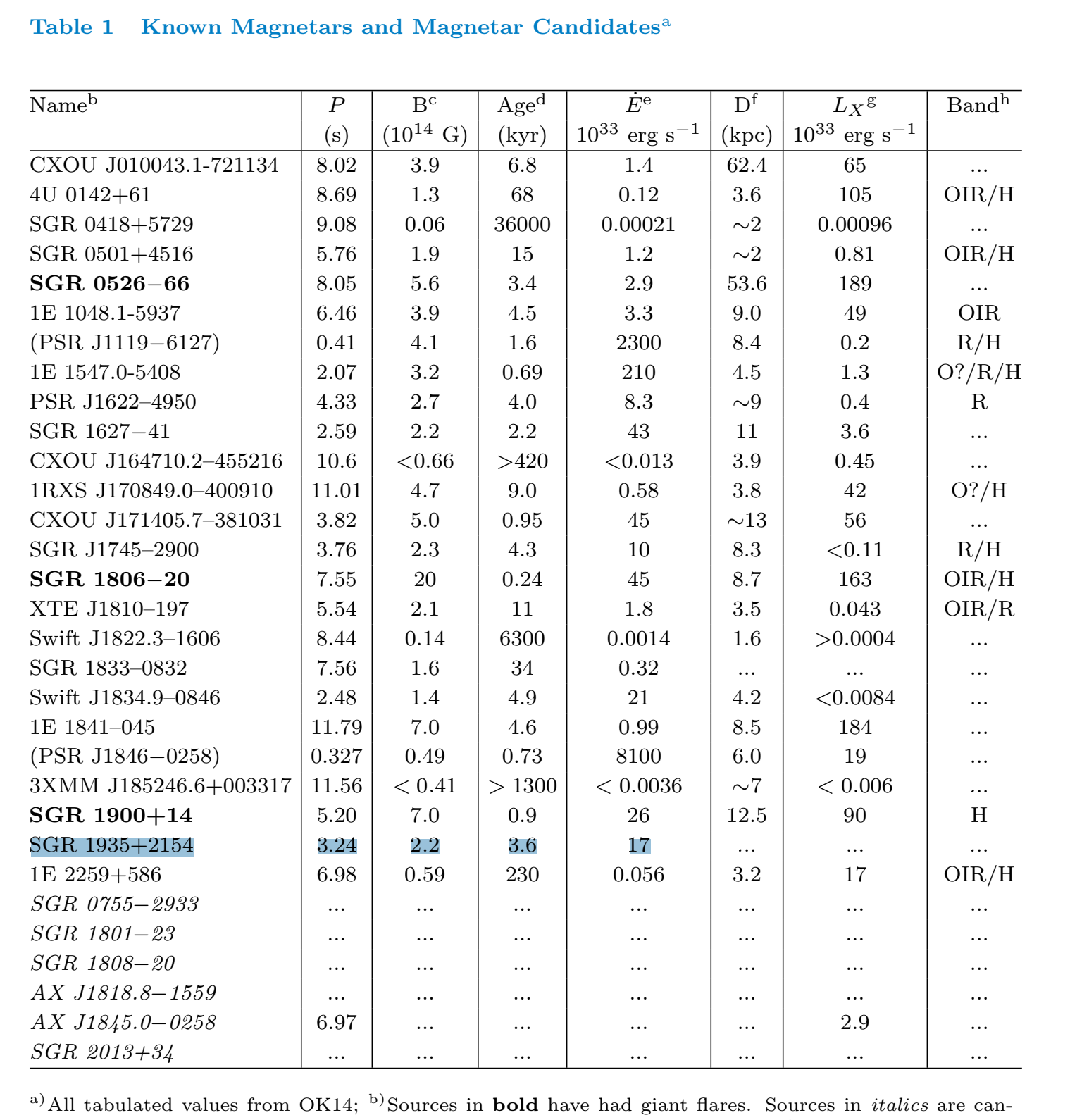
from https://ui.adsabs.harvard.edu/abs/2017ARA%26A..55..261K/abstract 一篇磁星的综述文章
6.1.2. 它的3.2s是X-ray的,
“Chandra discovery of 3.2s X-ray pulsations from SGR 1935+2154” http://www.astronomerstelegram.org/?read=6370
6.1.3 没有射电脉冲星
“Upper limits on the pulsed radio emission of SGR 1935+2154 from the Ooty Radio Telescope and the Giant Meterwave Radio Telescope” http://www.astronomerstelegram.org/?read=6376
6.1.4 频率变化 doi:10.1093/mnras/sty3213
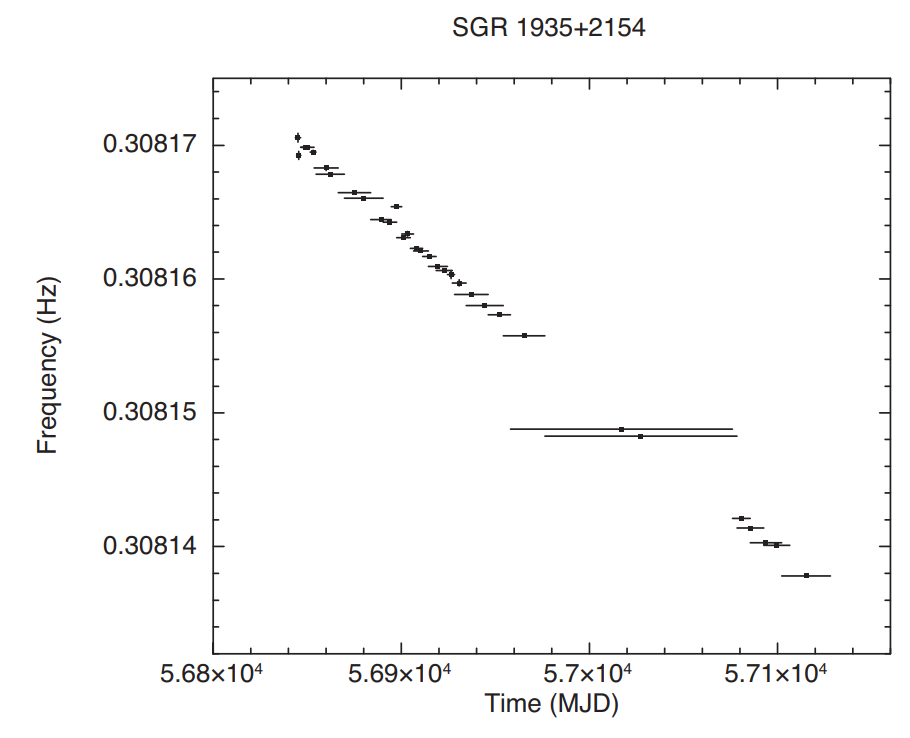
6.2 射电图像
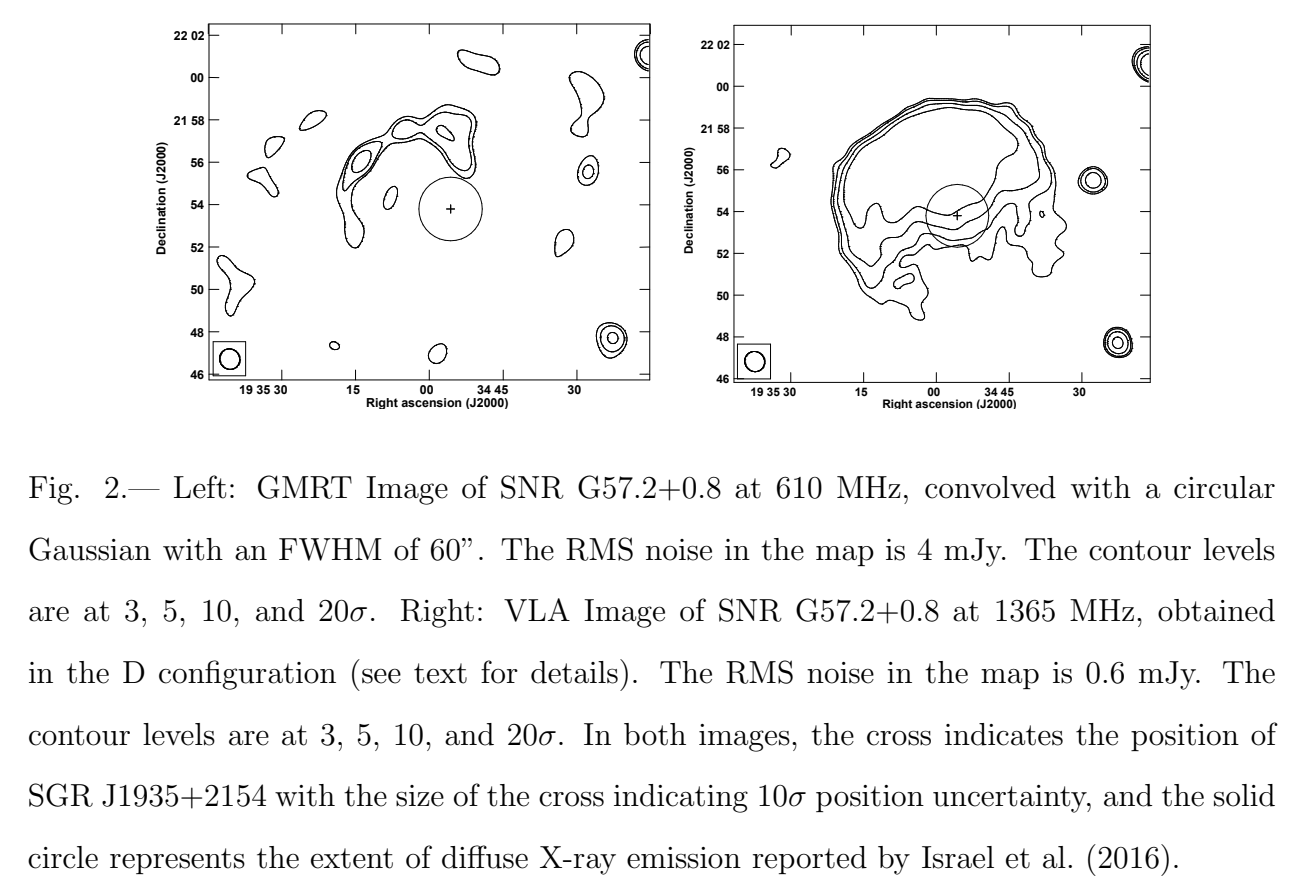
和X射线一起
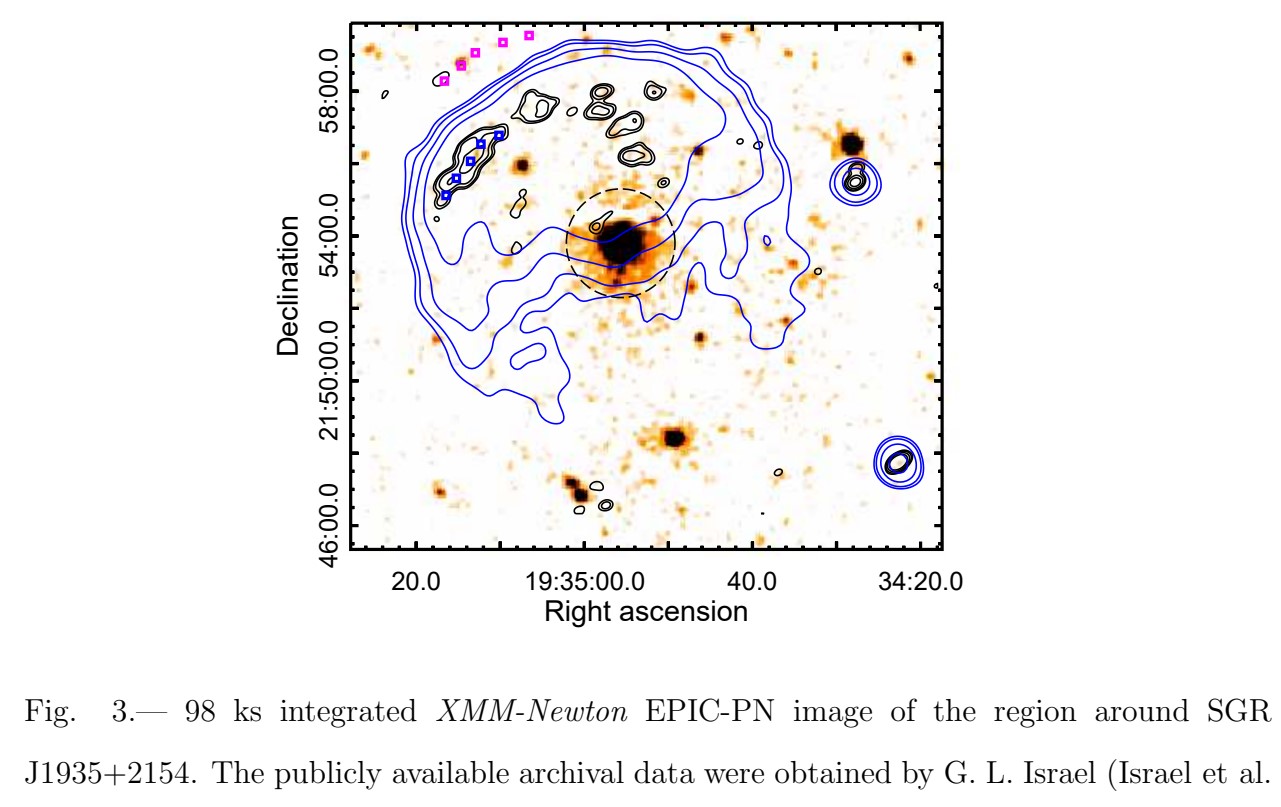
没看到射电脉冲星
from https://arxiv.org/abs/1605.08276
6.3 关于它的距离
6.3.1 历史文章,12kpc,9kpc等
这篇文章用X射线谱估算的距离是12kpc,对象是可能成协的超新星遗迹, SNR G57.2+0.8

https://arxiv.org/abs/1605.08276 Surnis2016

Israel 2016引用的9kpc(也是SNR的),但强调说很不确定,所以连误差都没给。



6.3.2 看 SNR G57.2+0.8 推测 SGR 1935+2154 的距离6.6 +/- 0.7 kpc arXiv:2005.03517
Revisiting the distance, environment and supernova properties of SNR G57.2+0.8 that hosts SGR 1935+2154
Ping Zhou, Xin Zhou, Yang Chen, Jie-Shuang Wang, Jacco Vink, Yuan Wang
Comments: 8 pages, 5 figures, submitted
Subjects: High Energy Astrophysical Phenomena (astro-ph.HE)
We have performed a multi-wavelength study of supernova remnant (SNR) G57.2+0.8 hosting the magnetar SGR 1935+2154, which emitted an extremely bright ms-duration radio burst on Apr 28, 2020 (Scholz & Chime/Frb Collaboration 2020; Bochenek et al. 2020). We used the 12CO and 13CO J=1-0 data from the MWISP CO line survey to search for molecular gas associated G57.2+0.8, in order to constrain the physical parameters (e.g., the distance) of the SNR and its magnetar. We report that SNR G57.2+0.8 is likely impacting the molecular clouds (MCs) at the local standard of rest (LSR) velocity V_{LSR} ~ 30 km/s and excites a weak 1720 MHz OH maser. The LSR velocity of the MCs places the SNR and magnetar at a kinematic distance of d=6.6 +/- 0.7 kpc. The non-detection of thermal X-ray emission from the SNR and the relatively dense environment suggests G57.2+0.8 be an evolved SNR with an age t>1.6×104 (d/6.6 kpc) yr. The explosion energy of G57.2+0.8 is lower than 2×1051(n0/10cm−3)1.16(d/ 6.6kpc)3.16 erg, which is not very energetic even assuming a high ambient density n0 = 10 cm−3. This reinforces the opinion that magnetars do not necessarily result from very energetic supernova explosions.
6.4 红外辐射
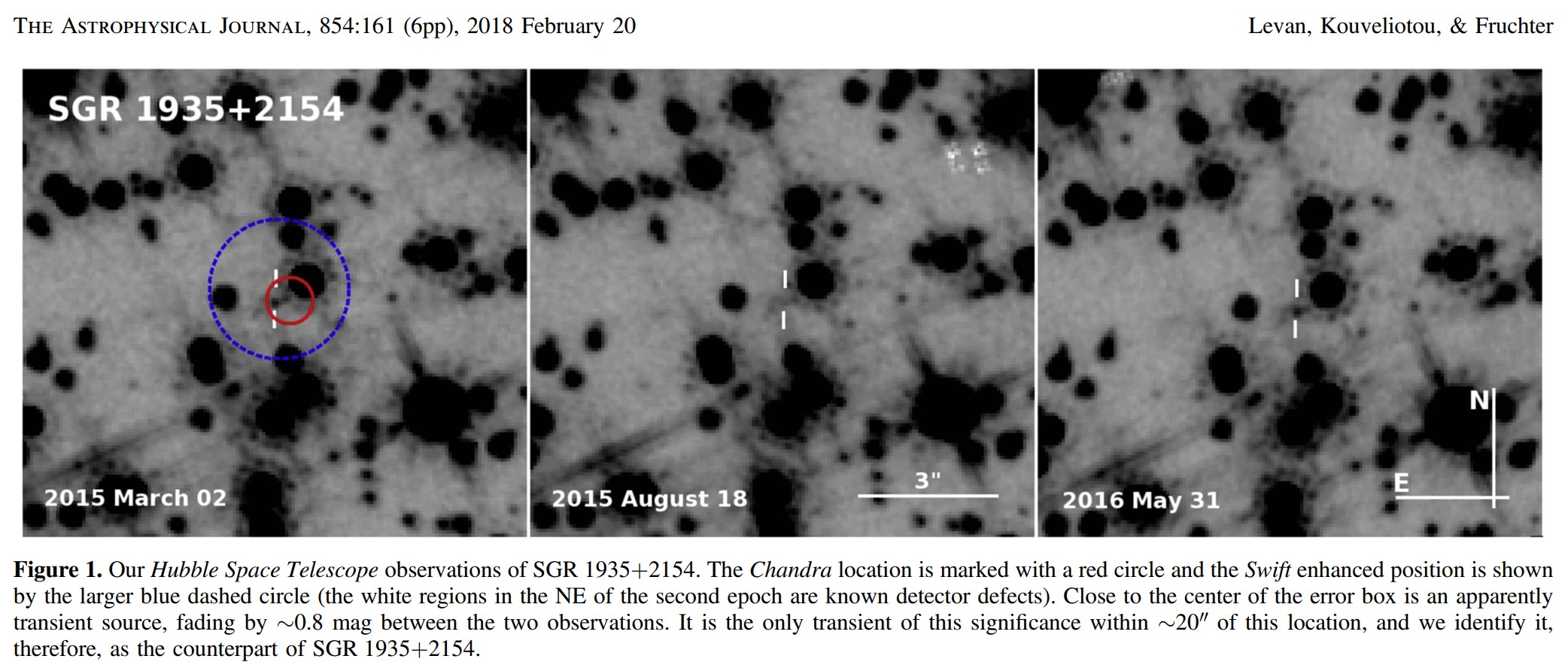
SGR 1935自己在爆发的时候也有红外辐射

https://ui.adsabs.harvard.edu/abs/2018ApJ...854..161L/abstract
6.5 射电脉冲星
目前没看到,Green Bank准备看:We propose to, for the first time, confirm pulsed radio emission from the active magnetar SGR 1935+2154.
https://dss.gb.nrao.edu/project/GBT20A-449/public
2020年5月2日
如果用激波朗道阻尼来解释,有这样一些点:
- 从两个pulse的谱上看,明显第二个比第一个高。STARE2看到的,也许是第三个,那频率就更高,1.4GHz。
这个可以这样解释:三次分别是三次内激波,激波一次就被压缩一次,对于非相对论性的激波(喷流整体还是相对论性的),密度就增加7倍,从而频率增加到sqrt(7).
注意到这是针对相对论性气体,gamma=4/3,如果是非相对论的,就是2倍了,貌似更符合。

- 第三个的流量也高很多,也许照样可以说是因为密度增加了。不过这需要定量的计算,要是第三个真多了几千倍,还是没法解释的。
- 也能解释这种现象:
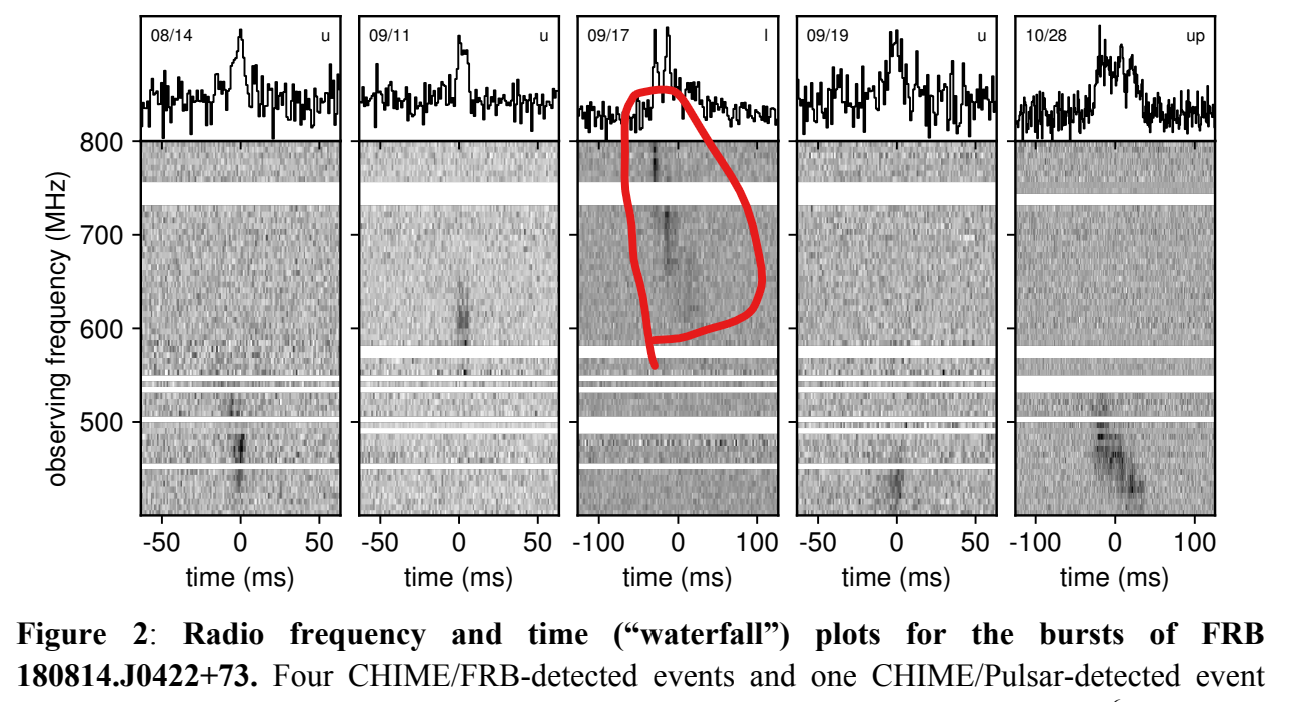
这种随时间频率降低的现象是同一个shell在不同维度的辐射,这样theta不一样,Doppler因子有小的差异导致随时间频率降低。但它又不是连续地降低的原因是辐射是集体相干辐射,没有中间状态。

移动的速率是线性的。arxiv 1901.04525
2020年5月3日
也许和II型太阳的射电暴是同样的机制呢。
II型暴都是双频的
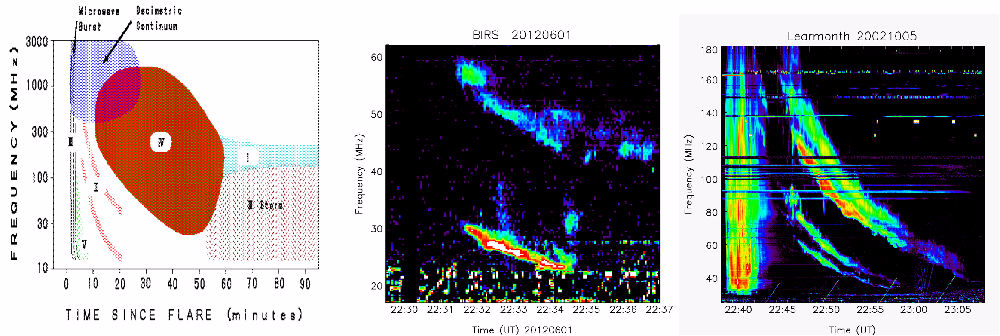
http://blog.sciencenet.cn/blog-685476-826124.html
见右图,如果把它时间“校准”(不确实这个是不是也是nu^-2),就变成和CHIME看到的两个峰类似了。
“对于II型射电暴而言,许多理论和观测研究都表明,这类辐射是由被激波加速的高能电子激发的。为何频率随时间下降较慢呢?这是由于激发这些射电的高能电子大都是在激波附近加速,而且被激波有关物理过程或结构约束在激波附近。这样,电波辐射频率的下降实际上反映的是激波处等离子体密度的下降。”
如果FRB是和II型类似和激波有关的话,那图像可以是这样的:两个shell要相撞的时候,后面那个也不是全相同的速度,快一些的先赶到,但是撞上去之后很快被减速,因为快的那部分数目很少;减速到了声速一下,然后后面的继续赶上,只到接近声速,这时候就有音障了,会导致需要更多的能量才能突破这个音障,而这些能量聚集着最终(通过复杂的过程,现在我也不知道是什么)转化成和等离子频率一致(猜测)的射电辐射,即观测到的FRB。如果快的shell慢慢装上慢的shell,就有足够的时间积累这个音障,形成比较亮的FRB。如果二者速度相差太快,就一下子就变成超音速激波了,积累音障的过程就很短,只有很少的能量转化进去,则产生的FRB就弱。这也就能解释为什么有的X-ray flare对应的FRB强,有的弱,而更多的是没有。(关于音速的时候需要更多的能量是来自飞机的音障效应,但那里飞机是一个点,在三维中往前运动。这里往前运动的是一个面,不知道还有没有这个效应。如果没有了的话,是不是可以借助飞机的模型,让“飞机”冲入前一个shell中呢。)
这样可以解释FRB和X-ray爆发的同时,而且FRB总是在X-ray之前,或者说是在X-ray上升阶段,FRB就结束了。如果是真的,对探究shell的结构和激波过程也是很有用的。
还有一种可能就是粒子的速度接近磁力线的声速--Alven速度。
这部分见条目“FRB和太阳II型射电暴的相似性说明FRB也是激波产生的”
2020年5月4日
和三型暴应该是不同的,虽然三型的研究的比较清楚了,是电子注入到了等离子中
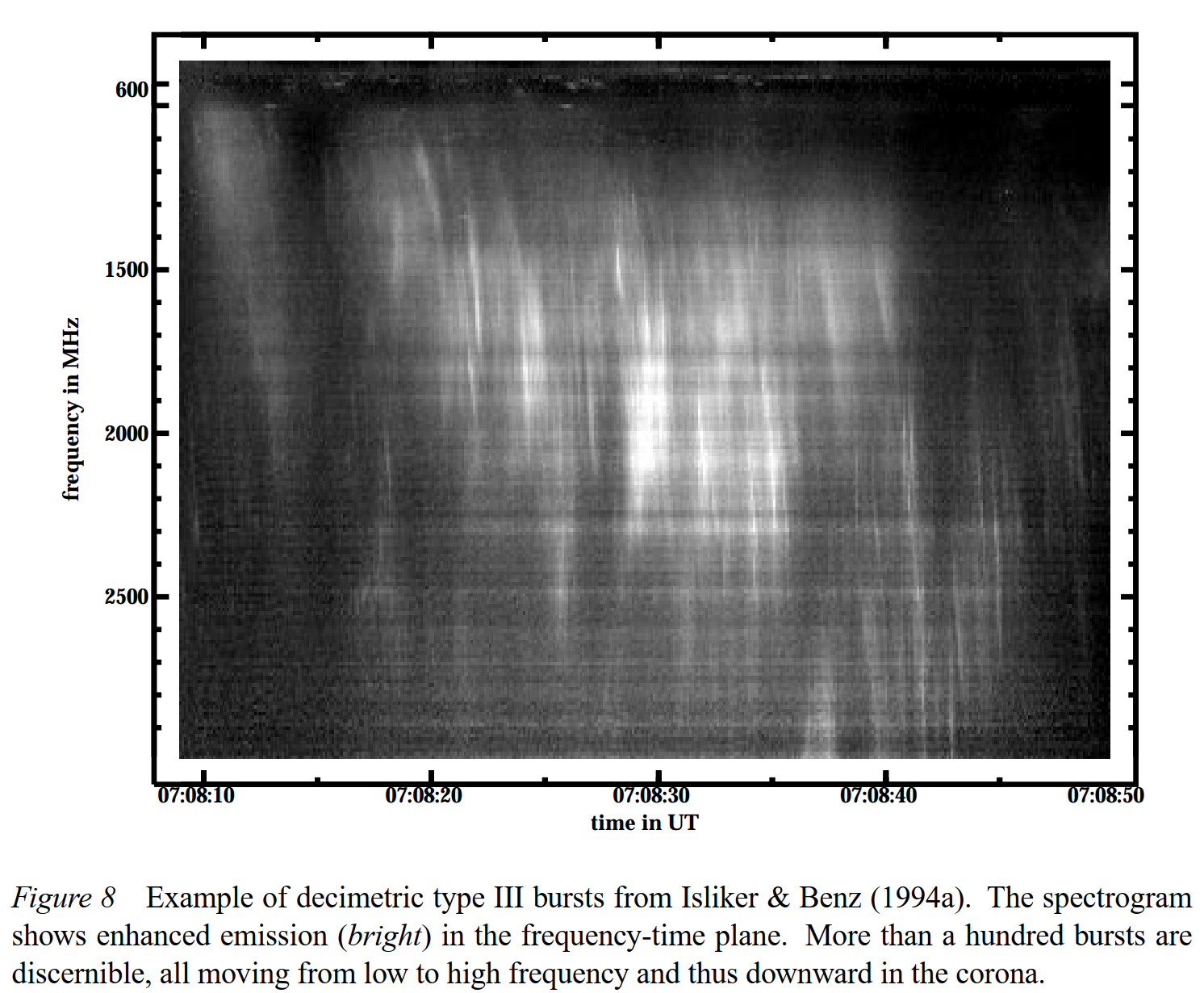
Annu. Rev. Astron. Astrophys. 1998.36:131-188. Downloaded from www.annualreviews.org
一分钟就有几百个。(注意这个图要倒着看,高频在下面。)
这是比较近的一篇II型暴的观测文章,也是科学网的那篇博文所对应的文章,作者做了不少Type II的radio bursts的工作。

https://ui.adsabs.harvard.edu/abs/2013ApJ...767...29F/abstract
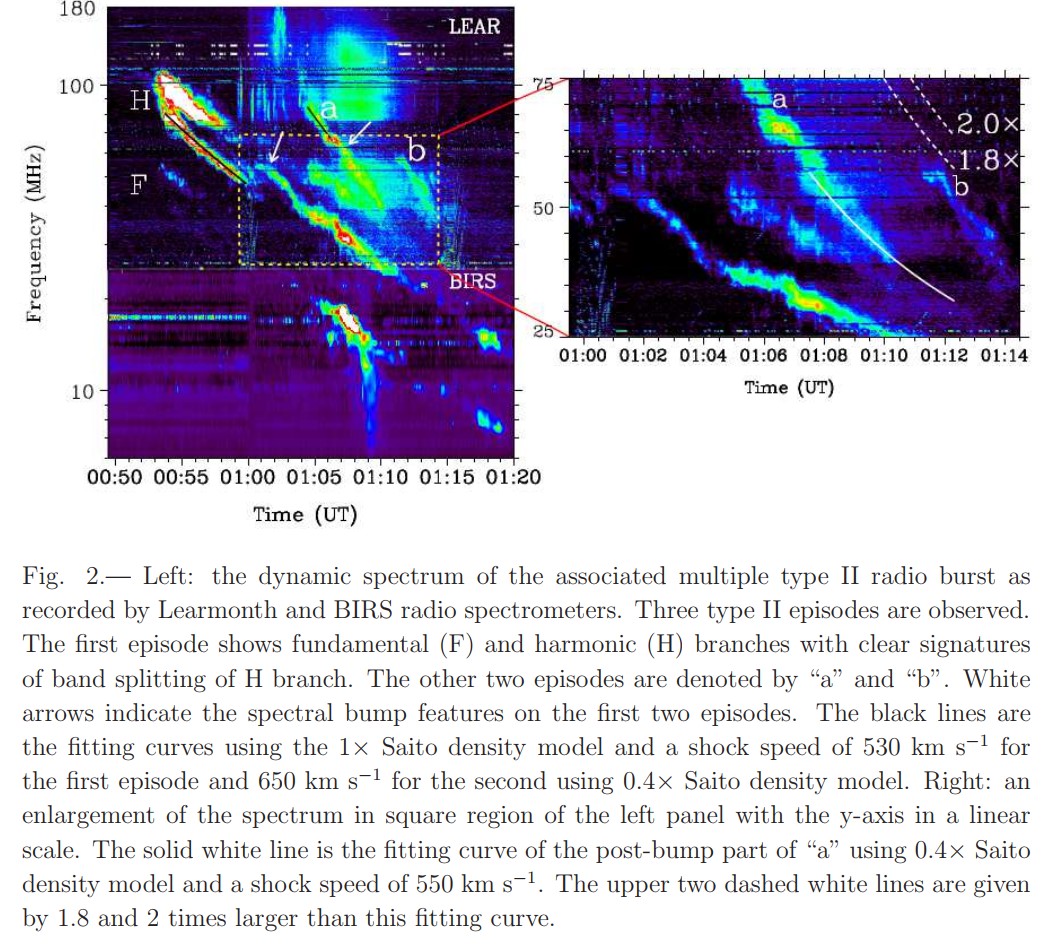
下面这应该是两篇(系列)最新的理论文章了


https://agupubs.onlinelibrary.wiley.com/doi/full/10.1029/2011JA017318
https://agupubs.onlinelibrary.wiley.com/doi/full/10.1029/2012JA017932
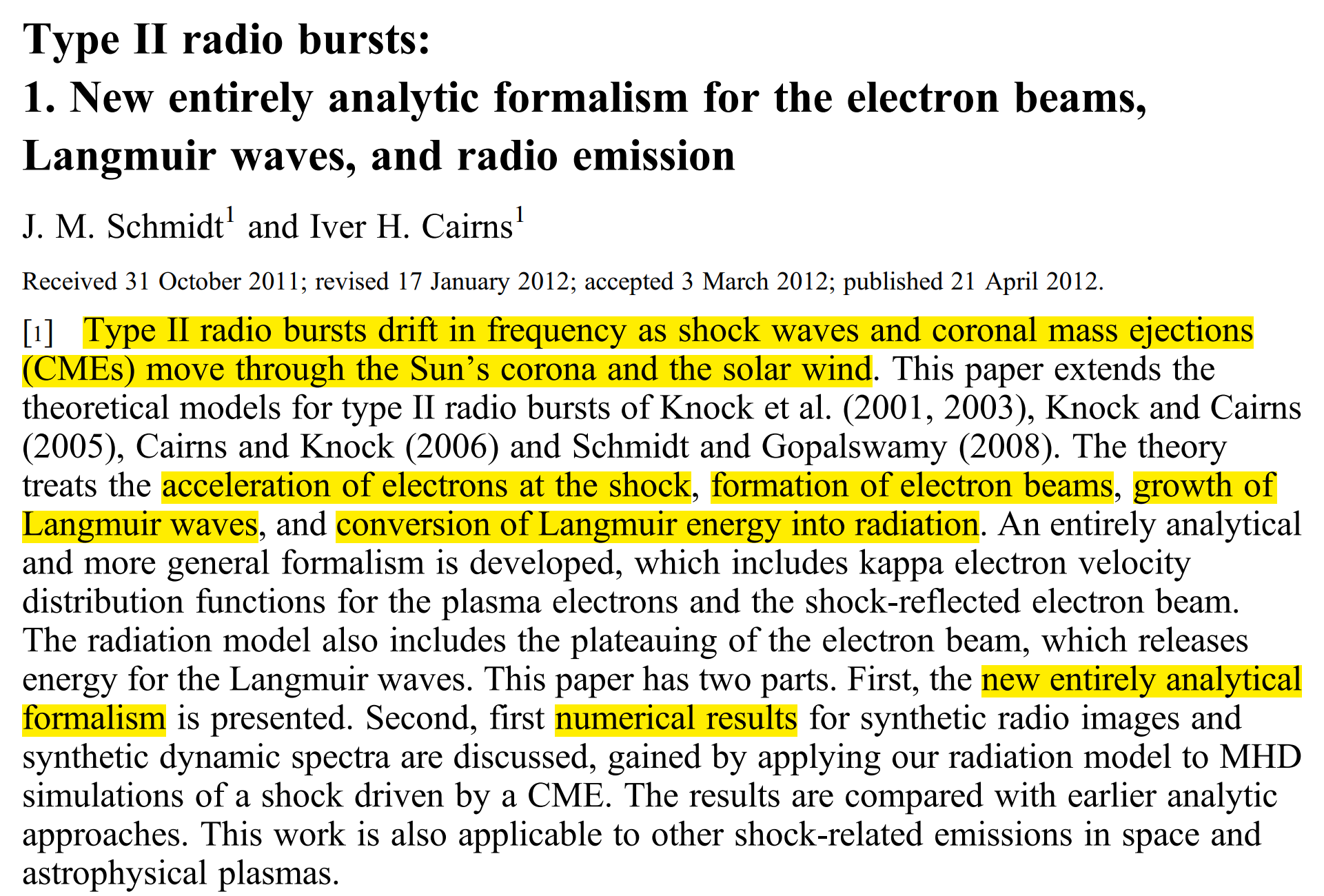
整个过程完整而复杂。
2020年5月22日
两篇FRB的观测文章都放到arxiv上了,都是投nature的。慧眼和FAST的观测文章下周一也要上来了,也是投Nature的。
CHIME的观测文章
A bright millisecond-duration radio burst from a Galactic magnetar https://arxiv.org/abs/2005.10324

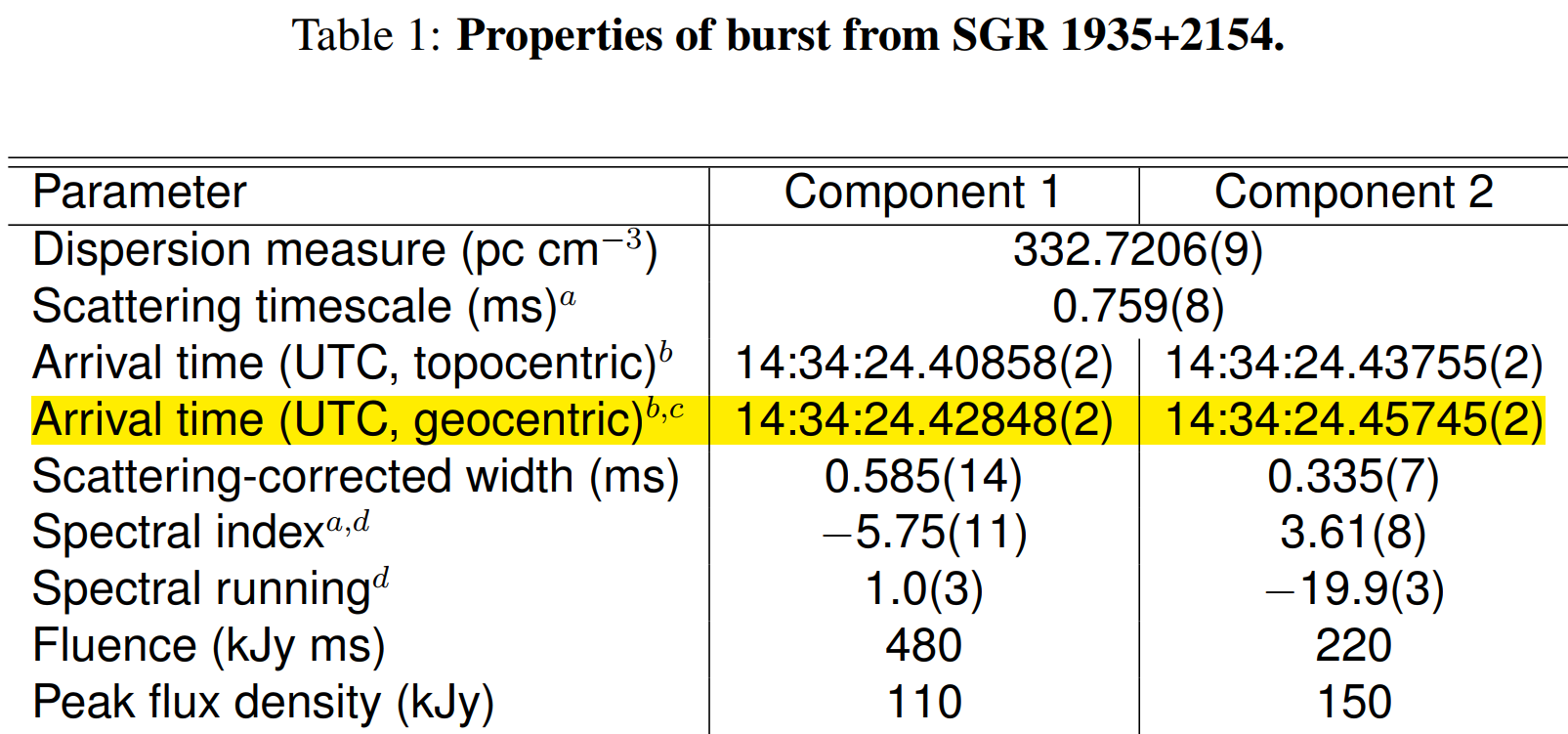
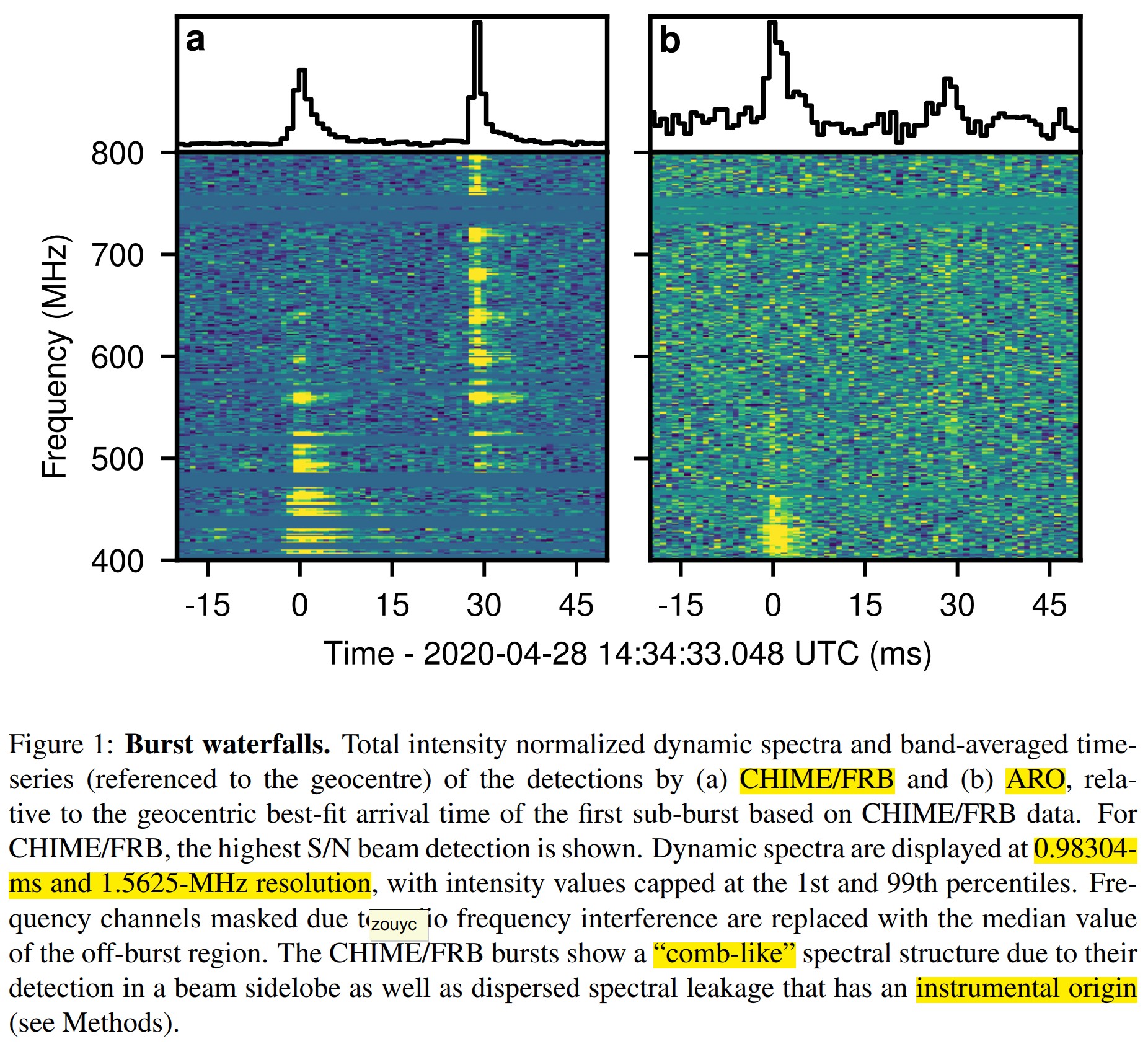
其中 The Algonquin Radio Observatory (ARO) hosts a stationary 10-m single-dish telescope in Algonquin Provincial Park, Ontario, Canada. 是个小望远镜。
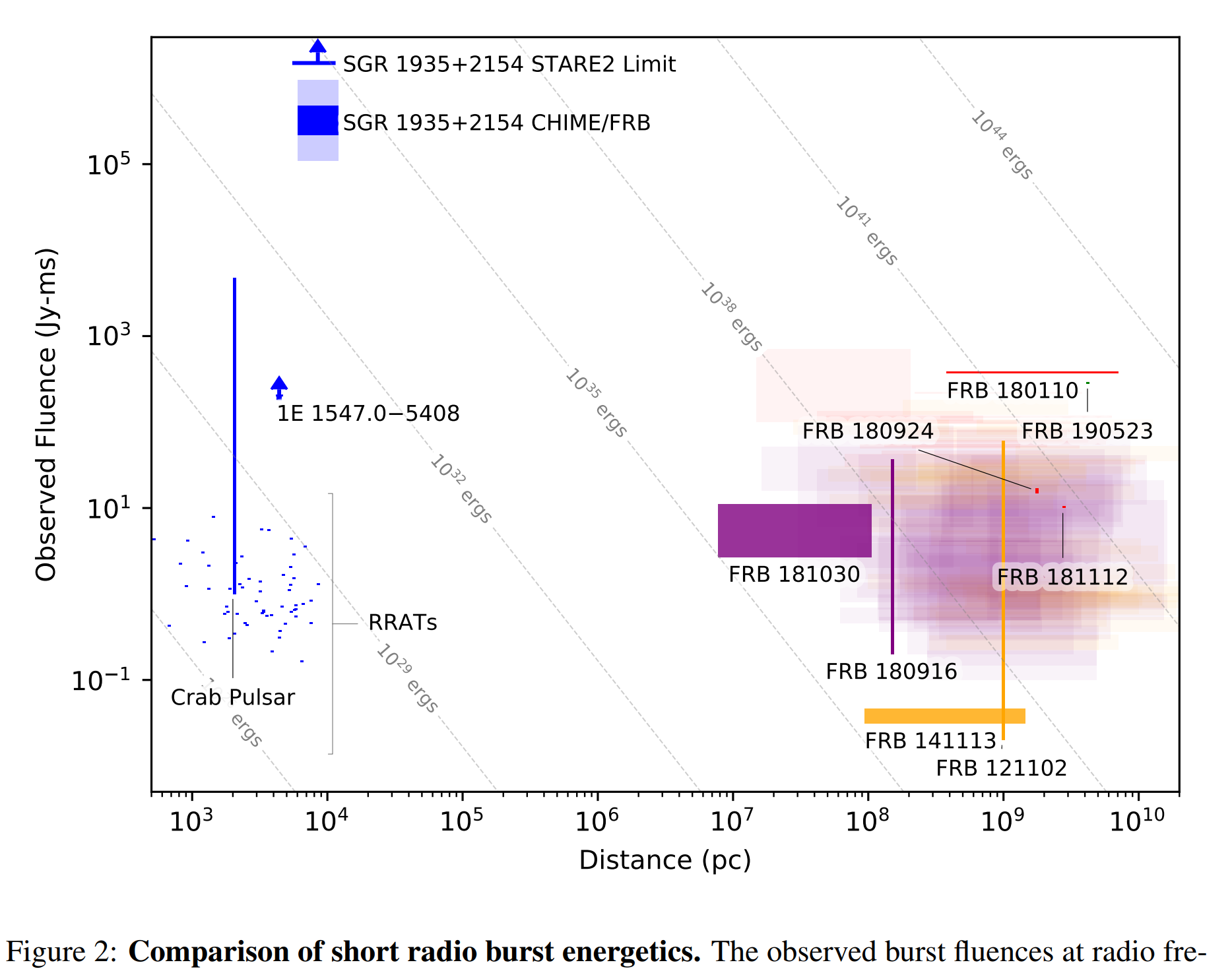
从这个图看,SGR 1935还是比其他的FRB的能量低一些的,起码低大约三个量级。
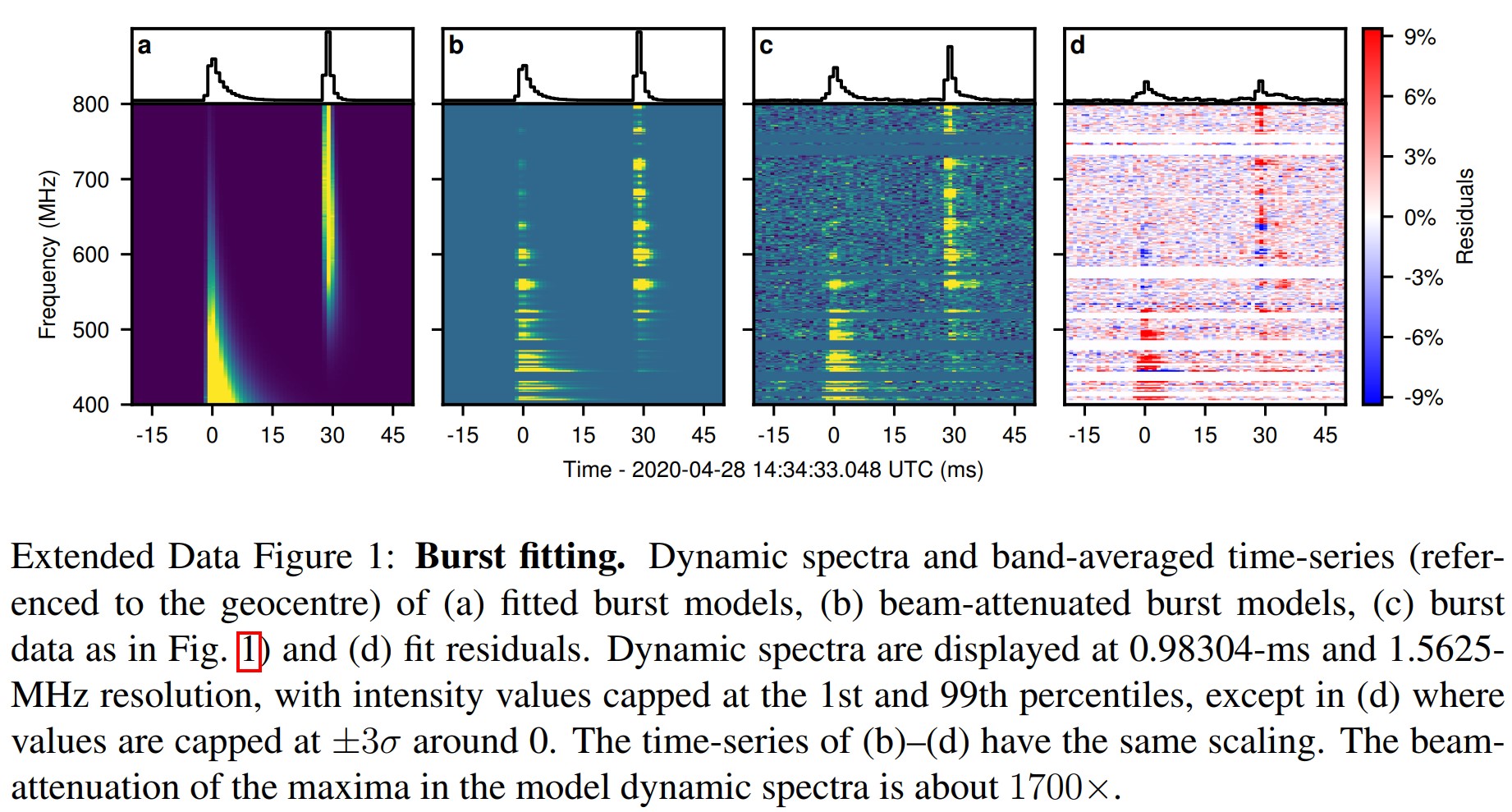
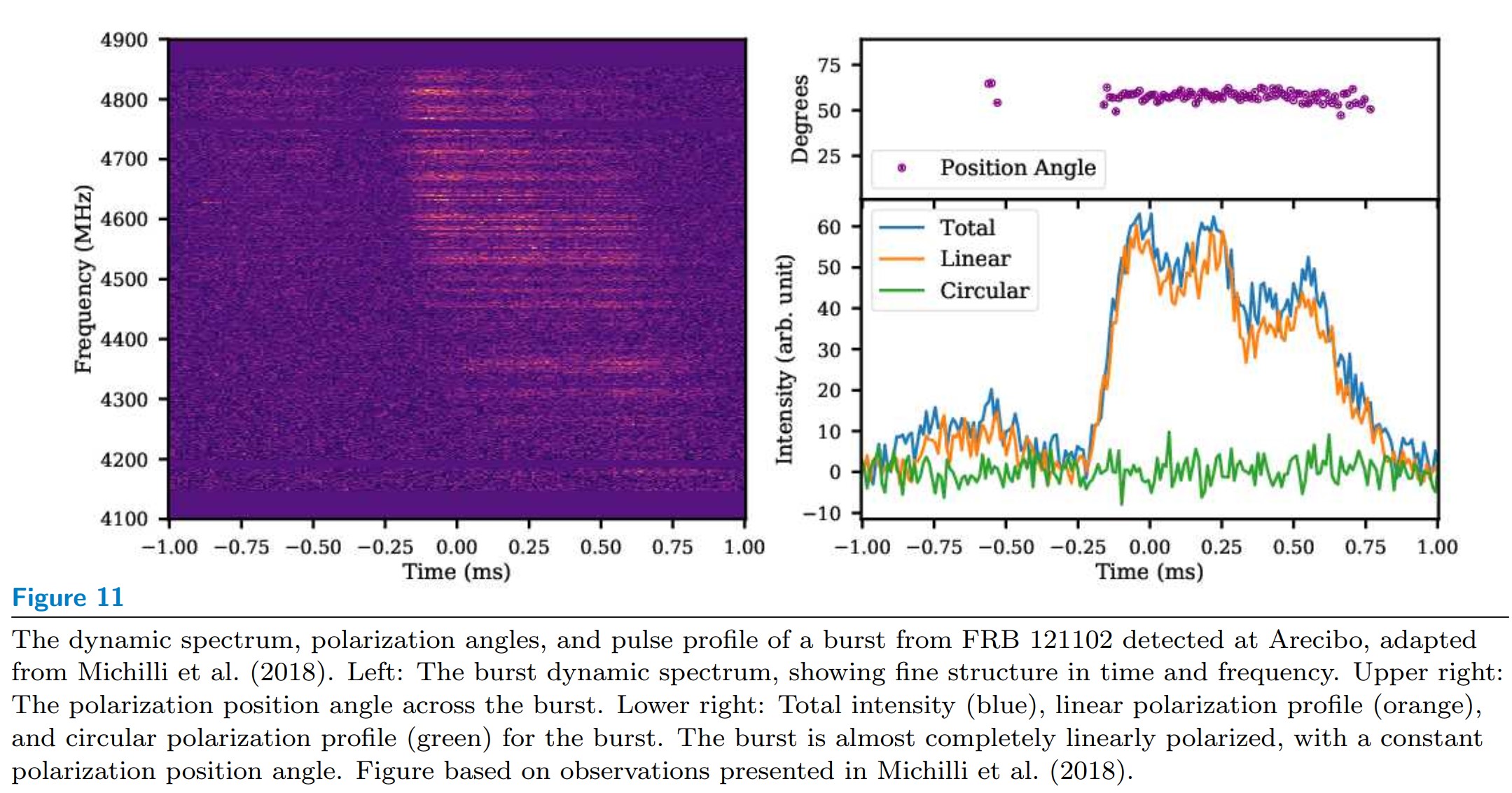
虽然上面FRB 200428的线谱是由于CHIME没对着看,仪器造成的,但线谱特征本身也还是存在的,比如FRB121102重复暴中的某一个。 https://ui.adsabs.harvard.edu/#abs/2019ARA%26A..57..417C/abstract
STARE2的观测文章
A fast radio burst associated with a Galactic magnetar https://arxiv.org/abs/2005.10828

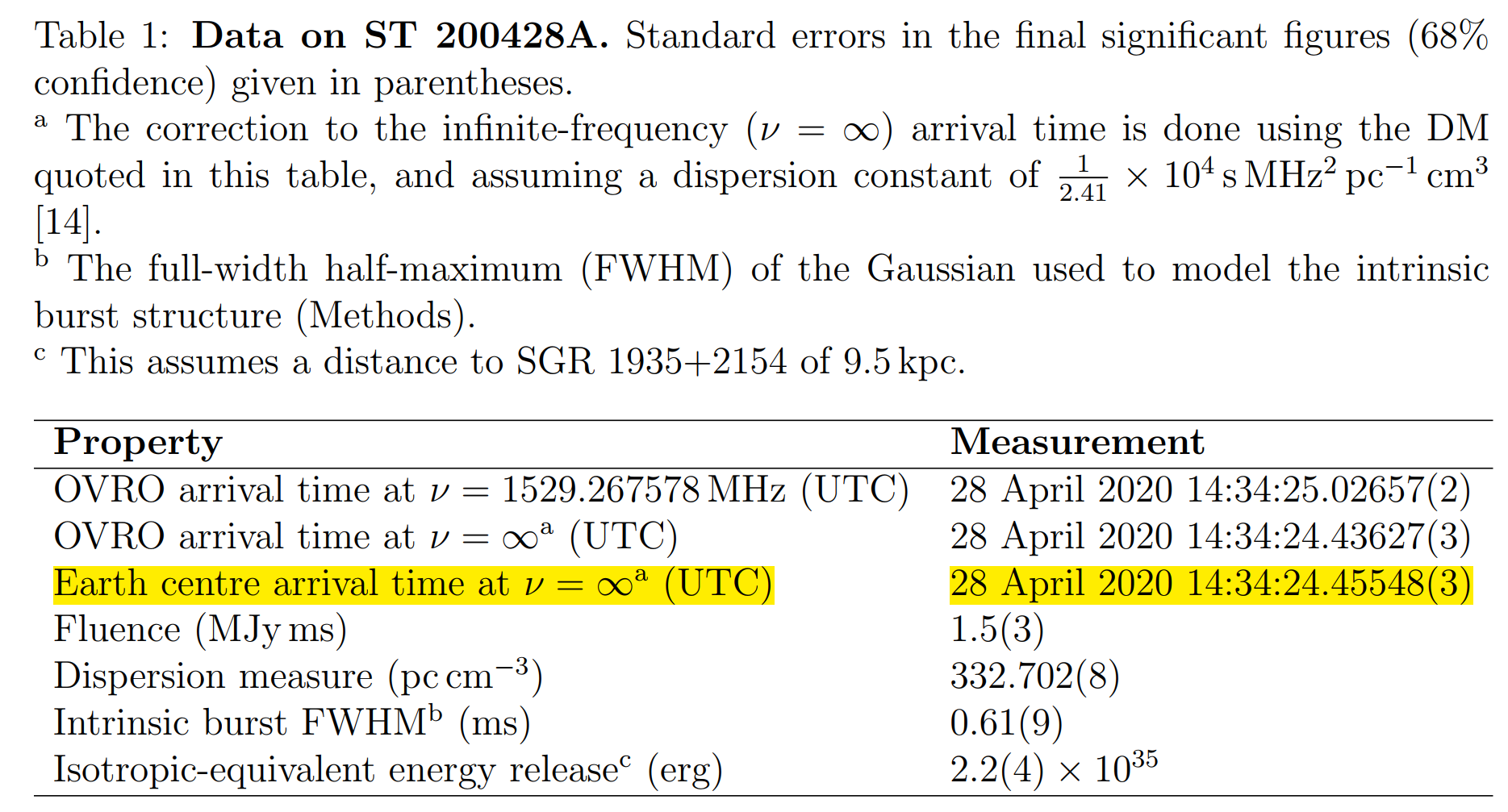
可以和前面CHIME仔细比较时间,注意STARE2的这个是和CHIME的第二个应该是同一个pulse。
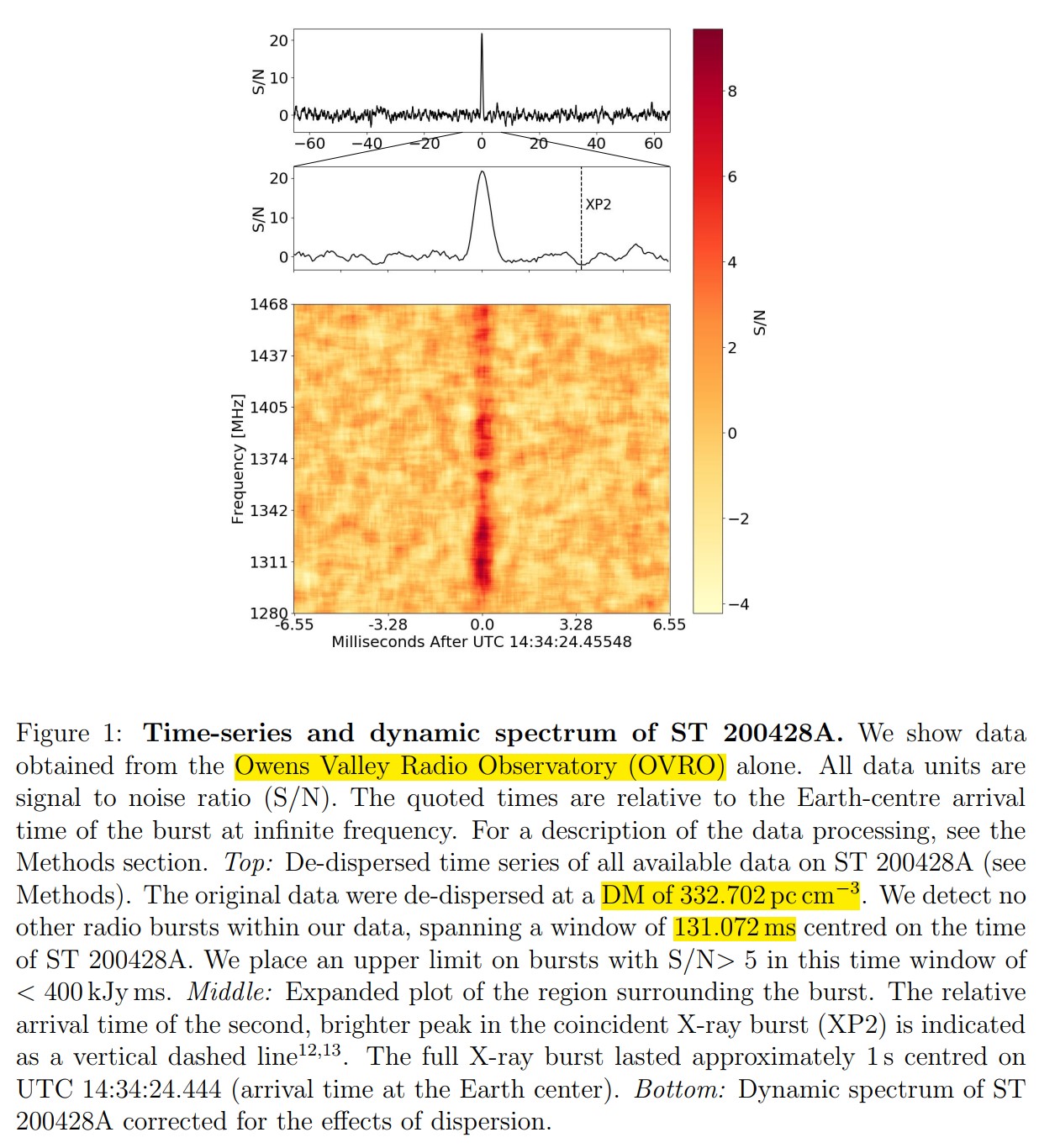
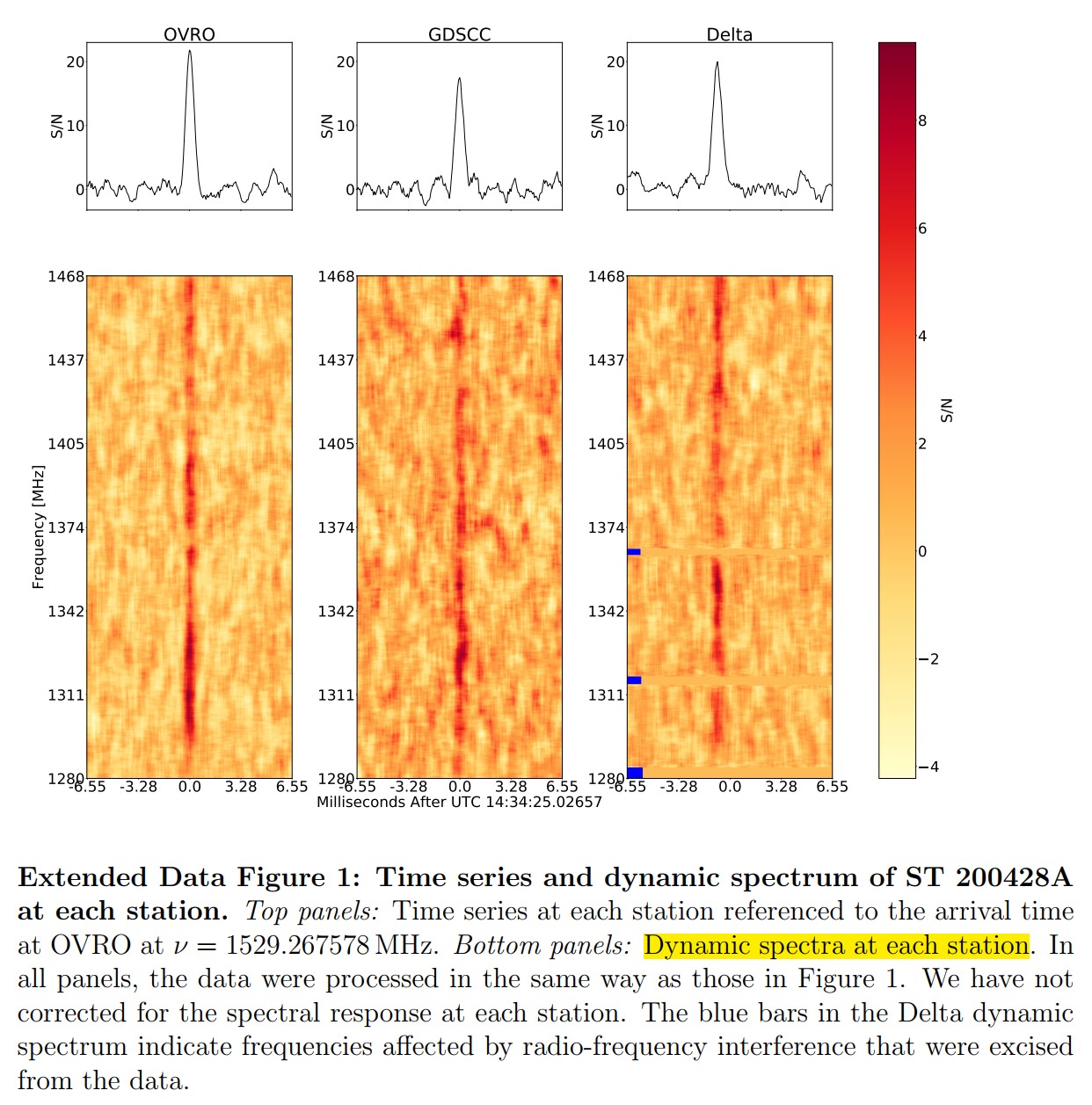
原来有三台望远镜都看到了。
2020年5月24日
看起来CHIME的第二个峰和STARE2的1.4GHz的峰相差了一点点时间,STARE2的早了2ms。会不会这就是还有个nu^-1或者其它频率依赖的lag的信号呢~

还有这个周期暴也有这种相差时间的,是60ms。
慧眼的观测
https://arxiv.org/abs/2005.11071

最终光变图和开始放在ATel上的一样的。

谱
Konus-WIND的观测
https://arxiv.org/abs/2005.11178


谱的结果和慧眼不太一样
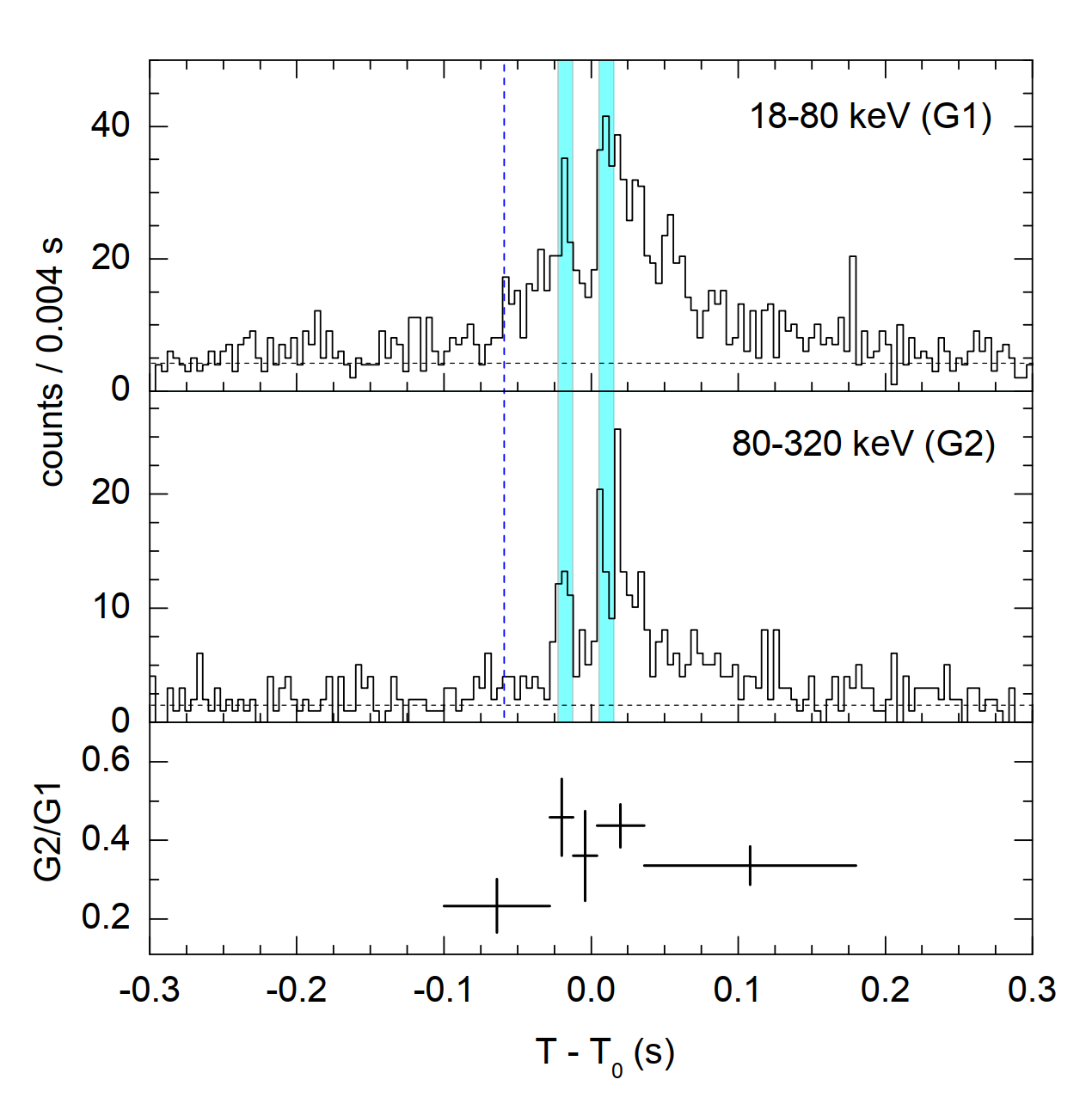
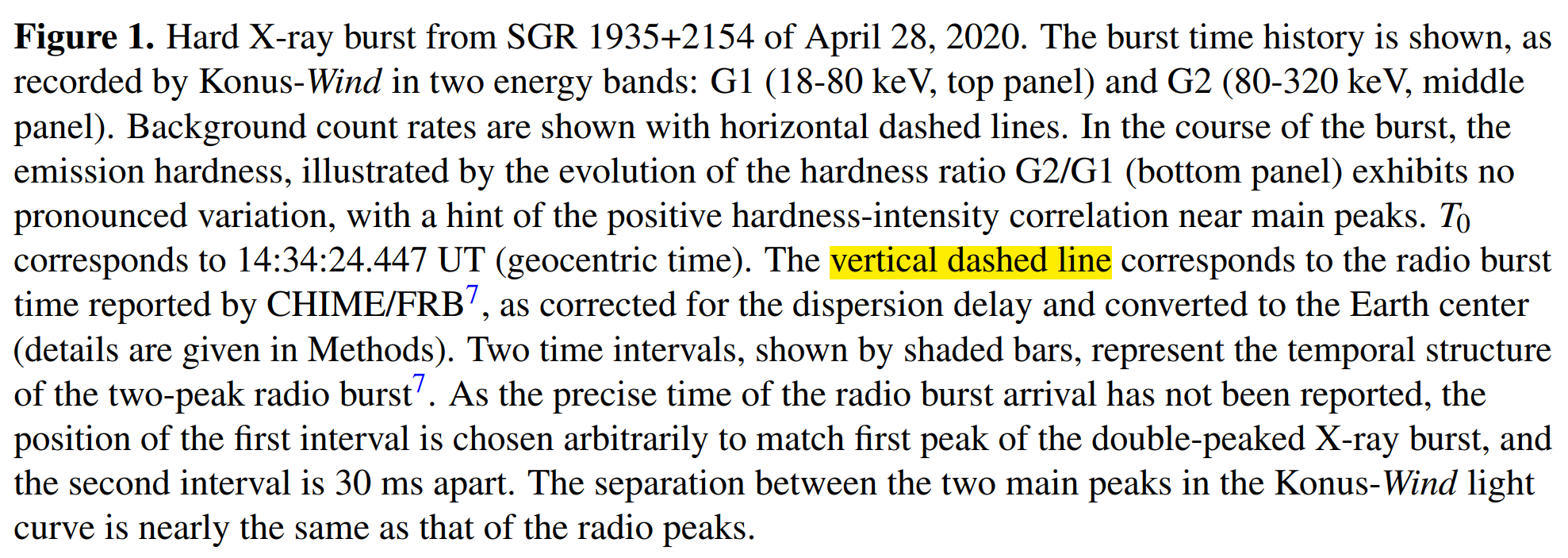
其实他们的这两个峰(蓝色垂线)是慧眼的第2、3个峰。
2020年5月26日
FAST给出了限制,在其它的flare时没有FRB
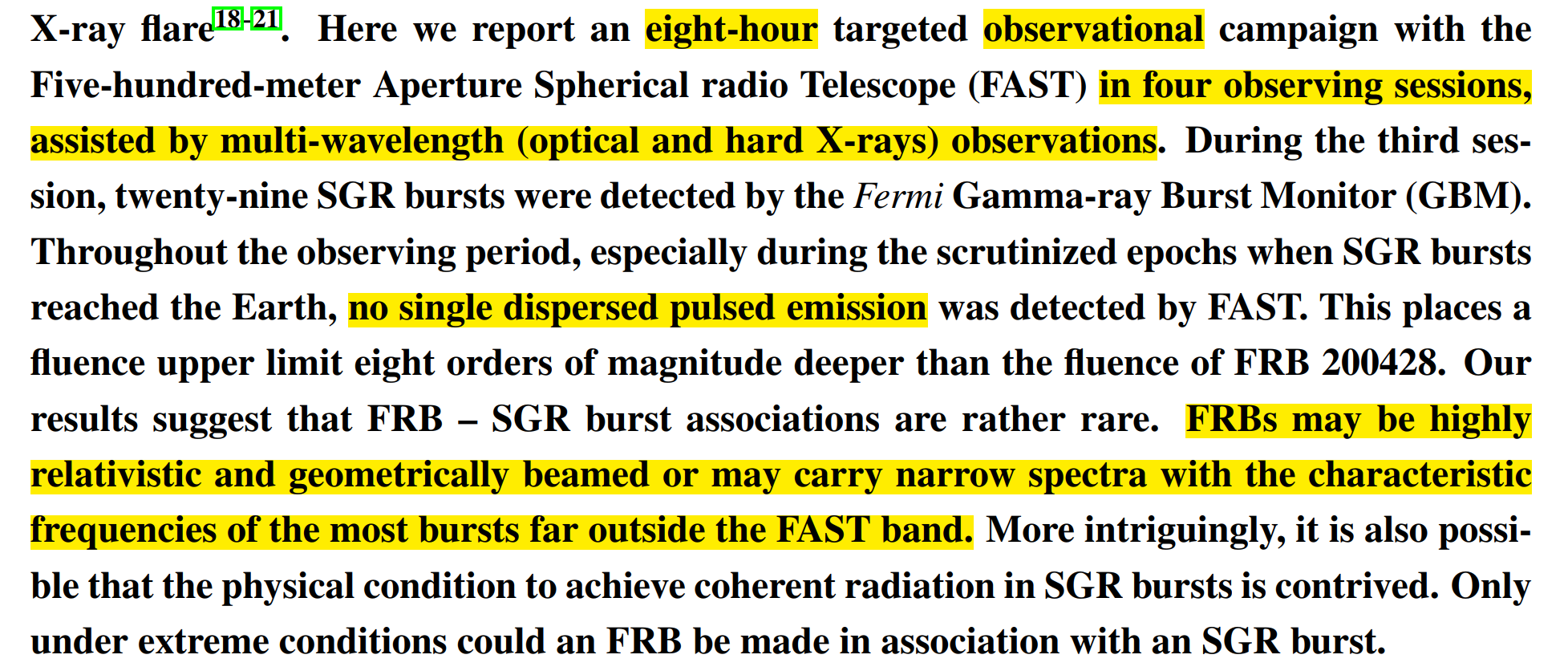
限制到比FRB 200428要低8个量级 https://arxiv.org/abs/2005.11479

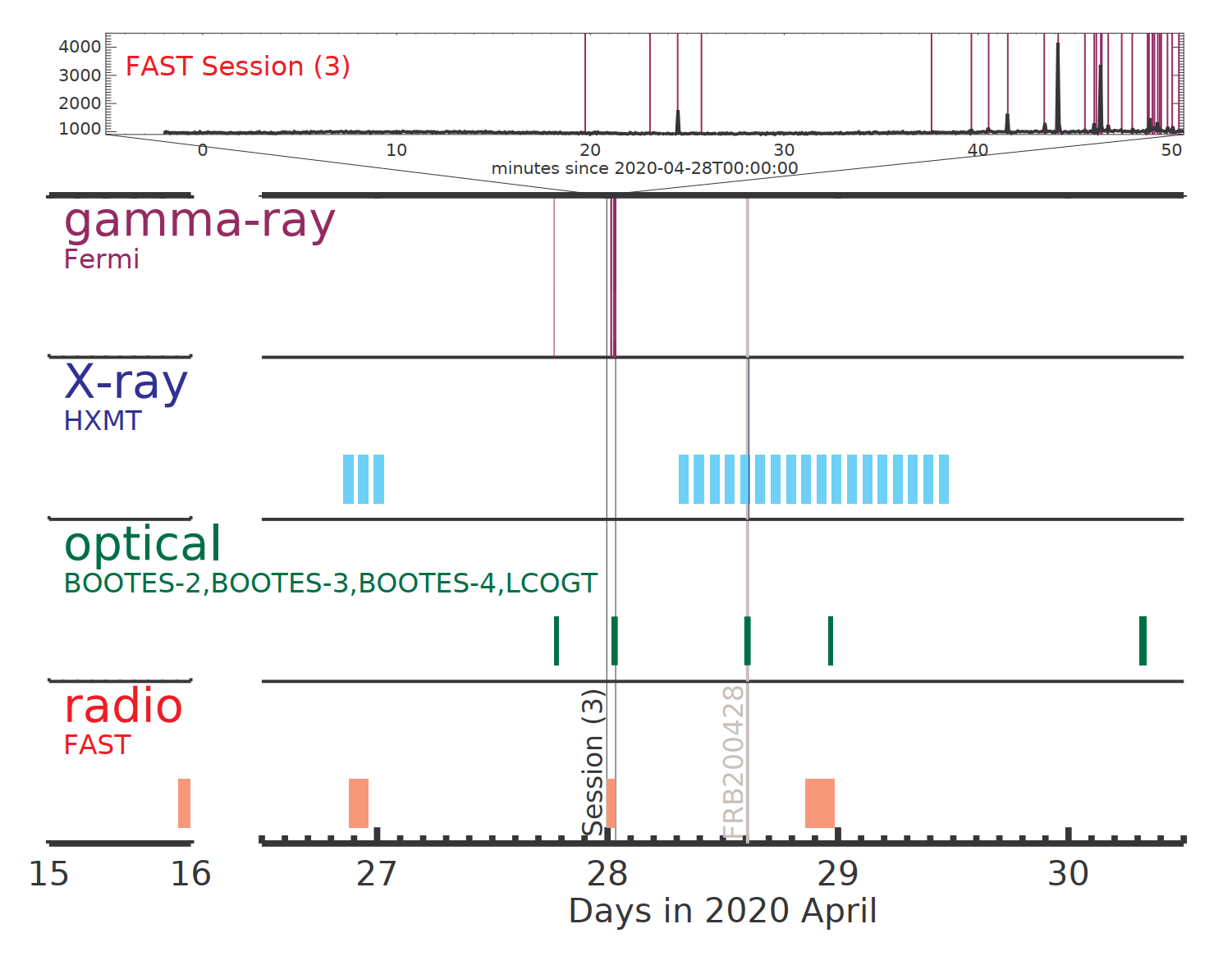
第三次的观测,有大量GBM的数据。
AGILE对FRB时期X-ray的观测

他们只投了Nature Astronomy,也难怪,数据结果比不上另外的仪器 https://arxiv.org/abs/2005.12164
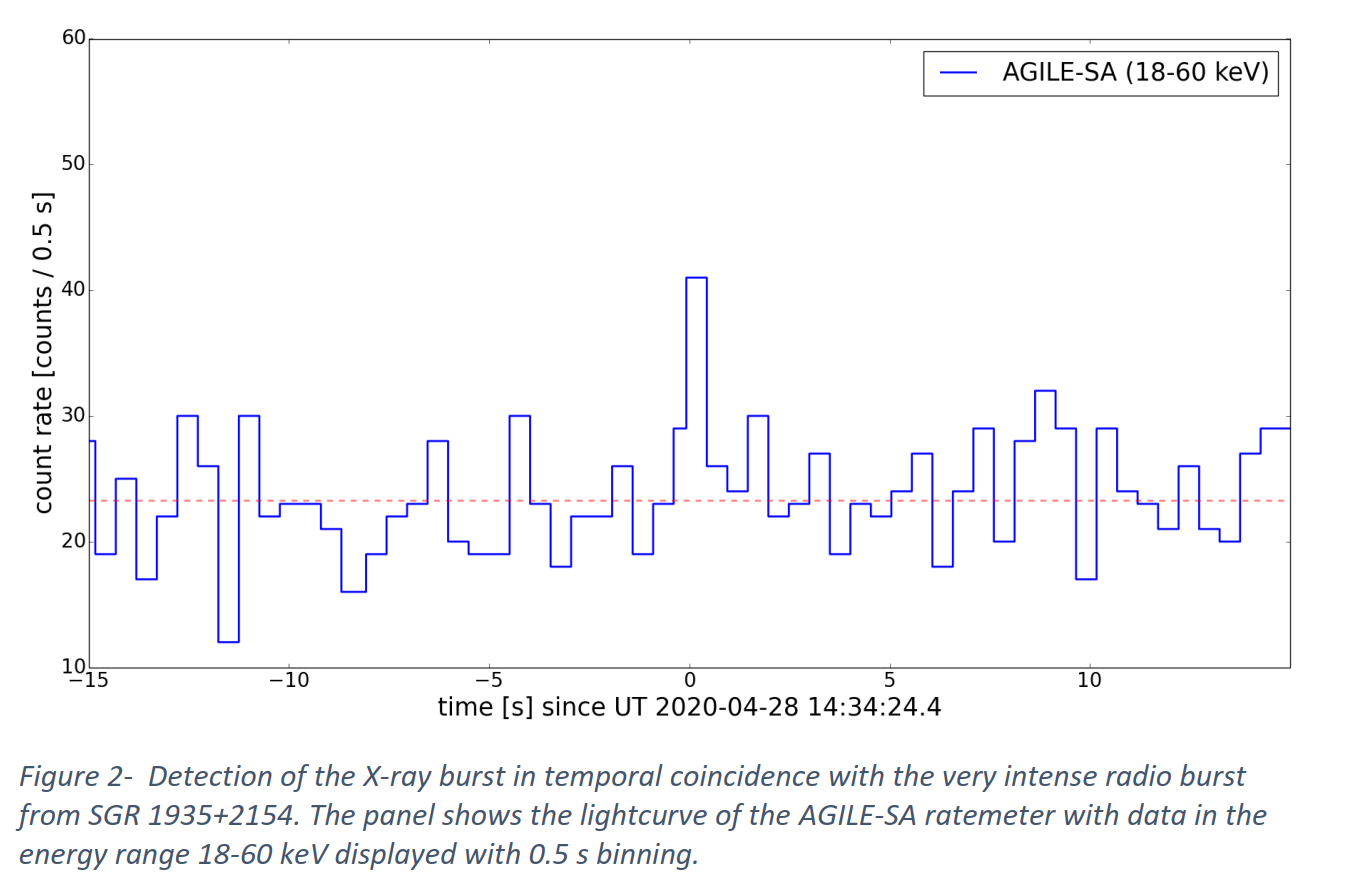
2020年6月2日
Swift,NICER,NuSTAR在暴前后的观测
https://arxiv.org/abs/2006.00215
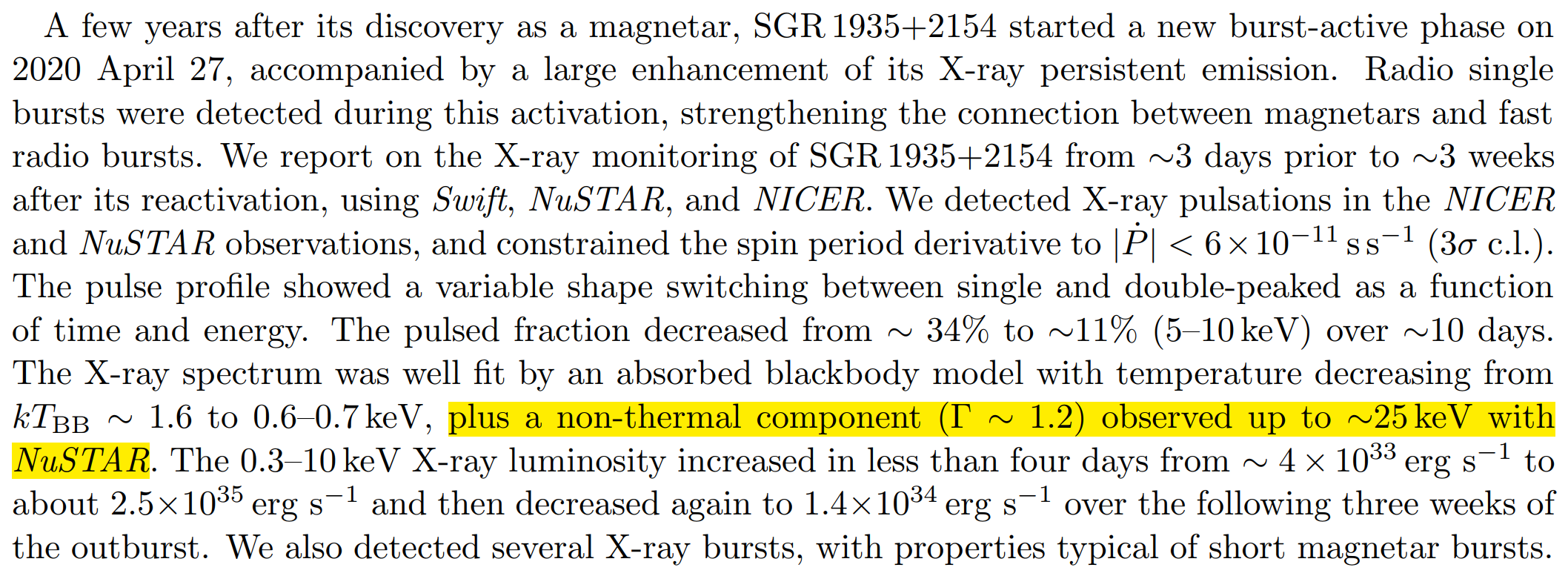
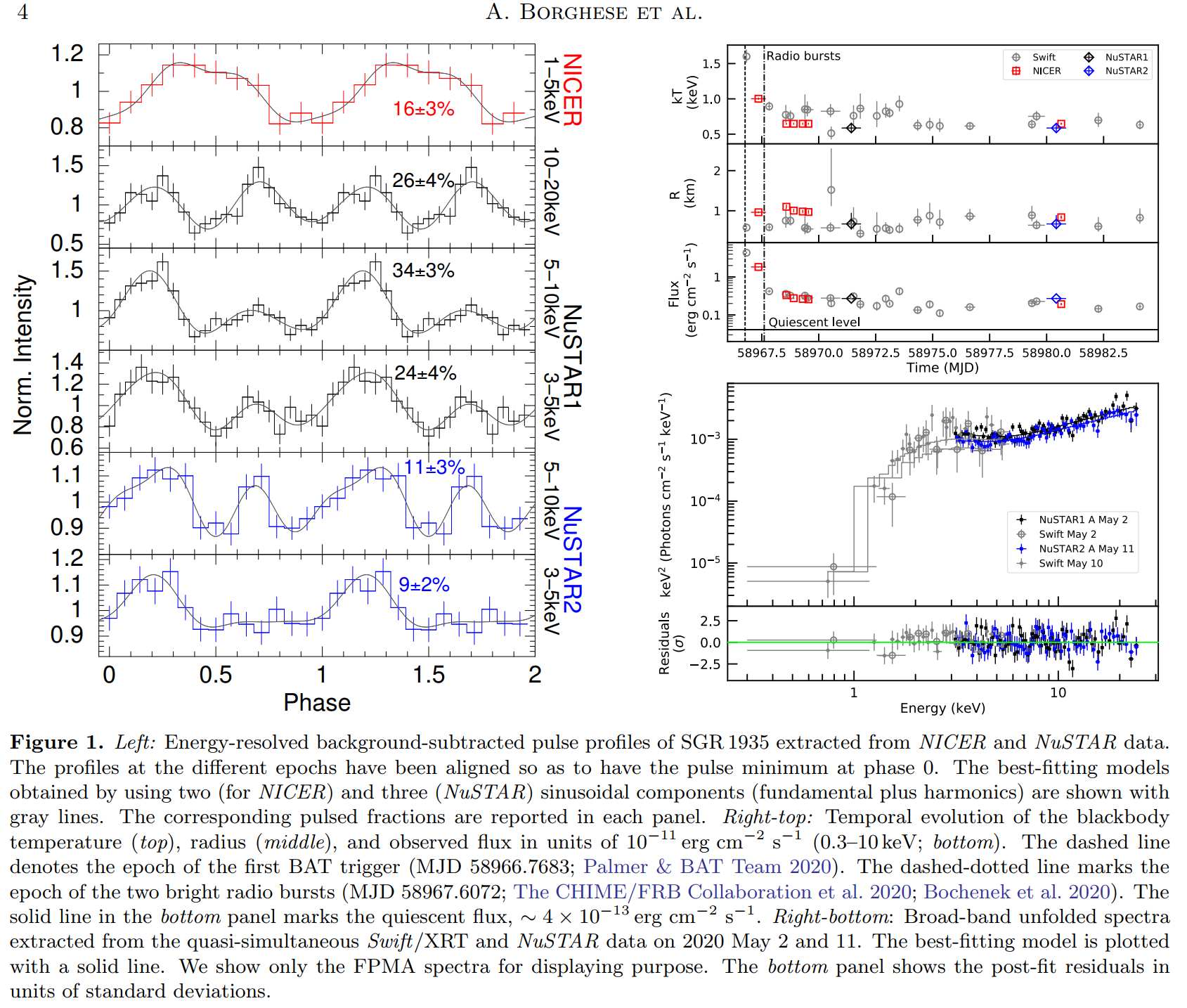
这是整体的X-ray辐射,不是X-ray bursts的,只不过这段时间更亮。
2020年6月23日
又一篇想投Nature的,说同时的这个X射线暴比别的暴都硬
https://arxiv.org/abs/2006.11358
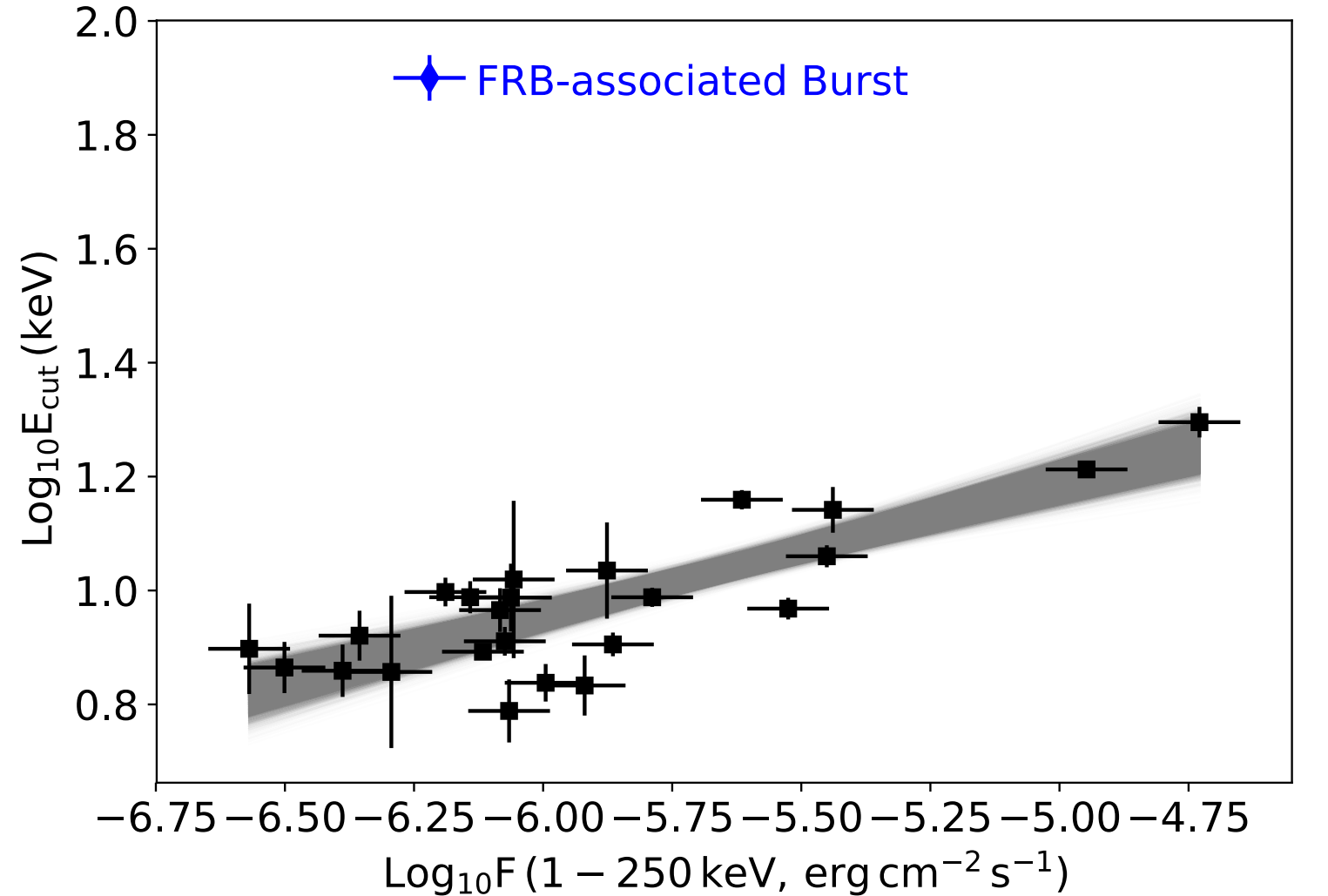
2020年7月5日
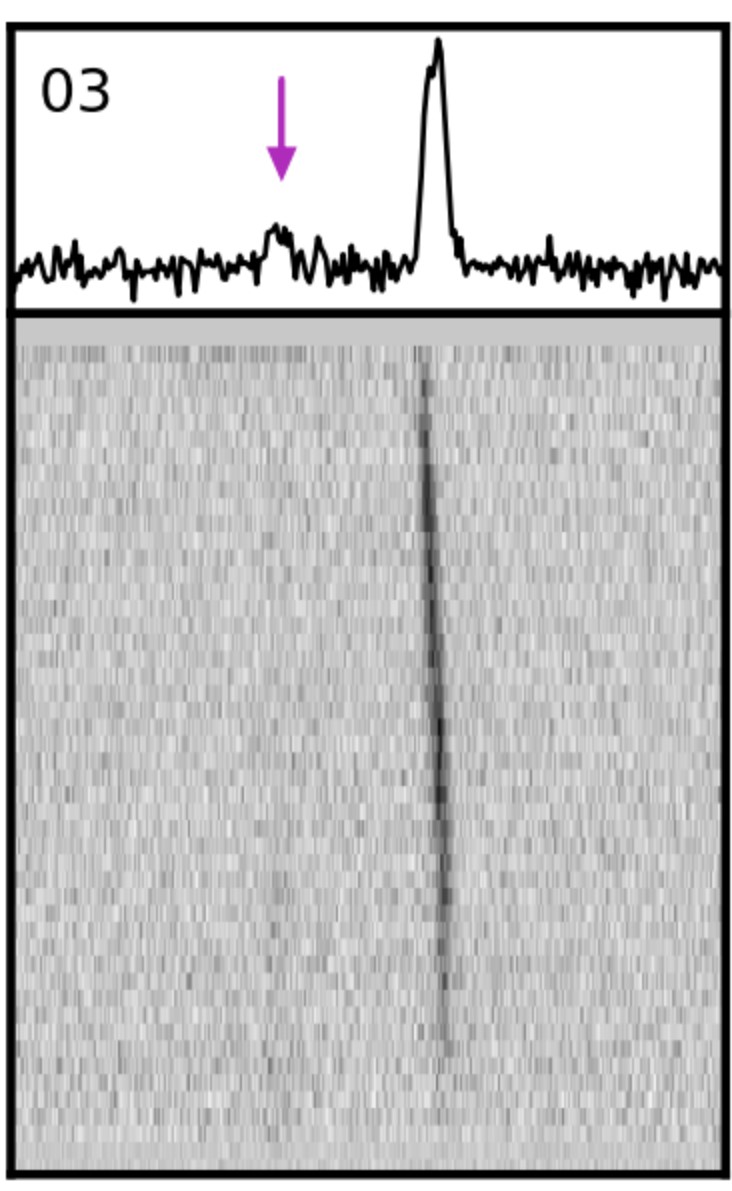
这个暴不同频率偏的很明显
https://arxiv.org/pdf/2006.08662.pdf
2020年7月30日
又发现了1935的两个FRB,流量低四五个量级,https://arxiv.org/abs/2007.05101

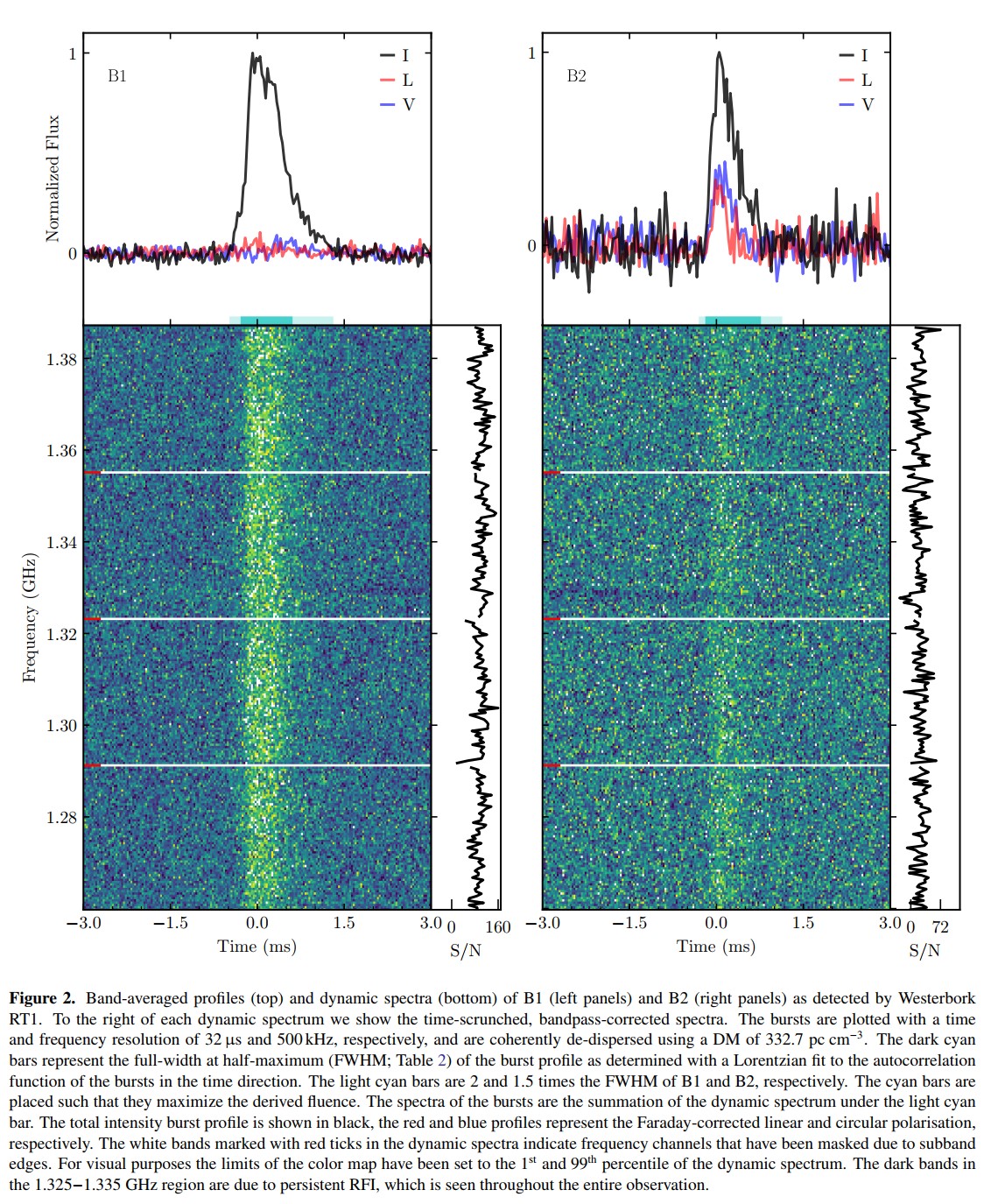
这个DM是332.7,STARE2的主暴似乎332.702,一样一样的。

其实他们测的不是很准,太宽了。
2020年8月21日
射电和X射线都有周期,3s
NICER在X射线看到了P = 3.247331(3) s的周期。
http://www.astronomerstelegram.org/?read=13720
而且爆发的时候还和平时不一样: The pulse profile is double-peaked, differently from the single-peaked profile observed in previous epochs (Israel et al. 2016, MNRAS 457, 3448), with a pulsed fraction of about 23%.
在这篇2016年的文章中已经说了X射线的周期是3秒多
https://academic.oup.com/mnras/article/457/4/3448/2588925

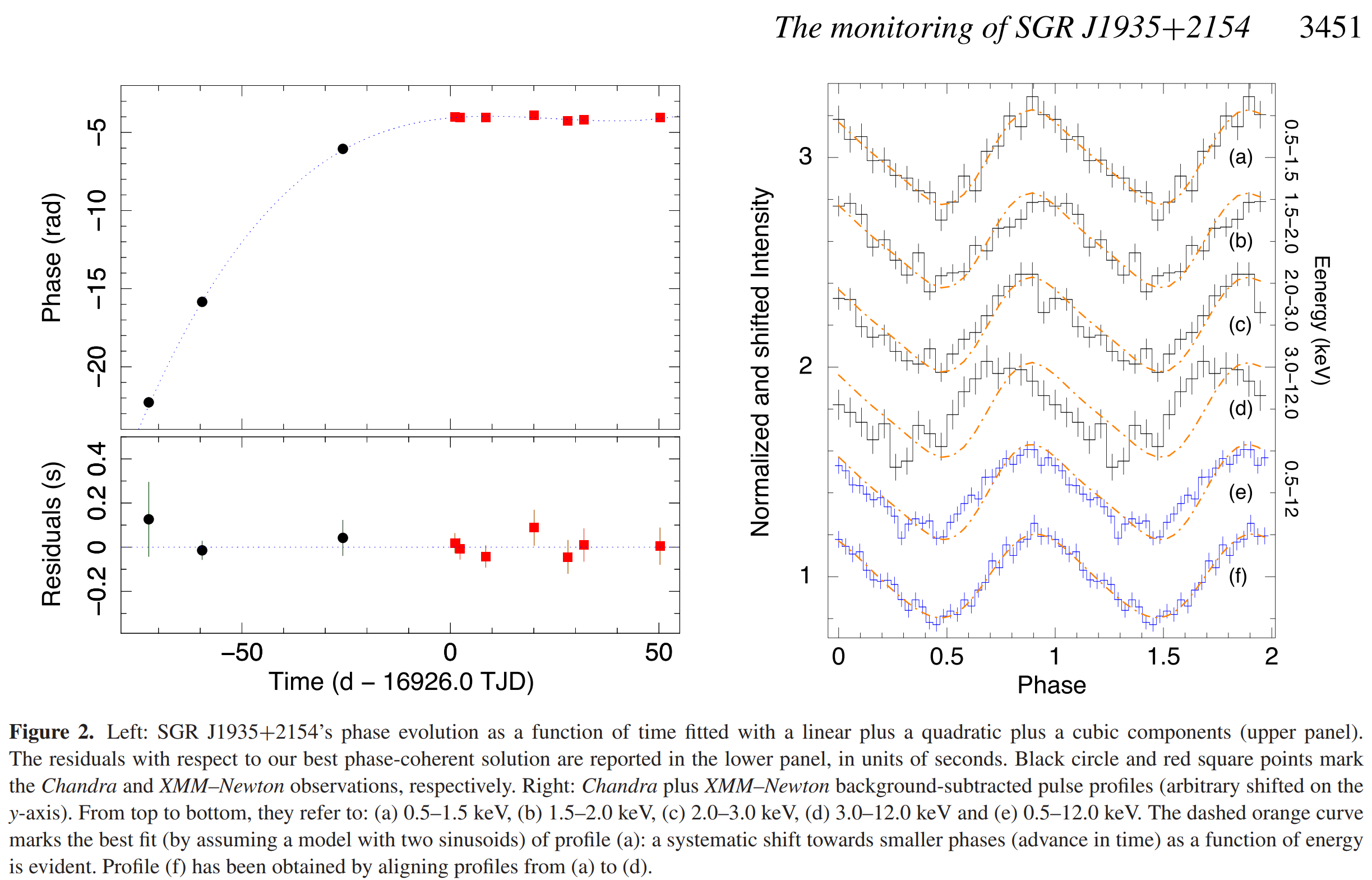
X射线的很像正弦曲线,说明确实不是集束的,而应该是来自中子星表面的热斑什么的。
而6月份还测到一个射电的周期,但要注意的是很多射电望远镜都看了,没看到周期信号;而且这个也只是marginally。
http://www.astronomerstelegram.org/?read=13783
The observations on the 30th started at UT 00:31:03 and finished at UT 02:01:01. Data were folded using the spin period measured from NuStar data (ATel #13720) and the dispersion measure (DM) of the FRB-like bursts detected on April 28th (Atel #13681, #13684). A search spanning +/- 1 ms around the nominal period (and +/- 200 pc/cm3 in DM) was carried out on the folded data, and resulted in a marginal detection of a periodic signal with period P = 3.24760(3) s, DM = 316(18) pc/cm3 and width of order 100 ms (see plot in the link below).
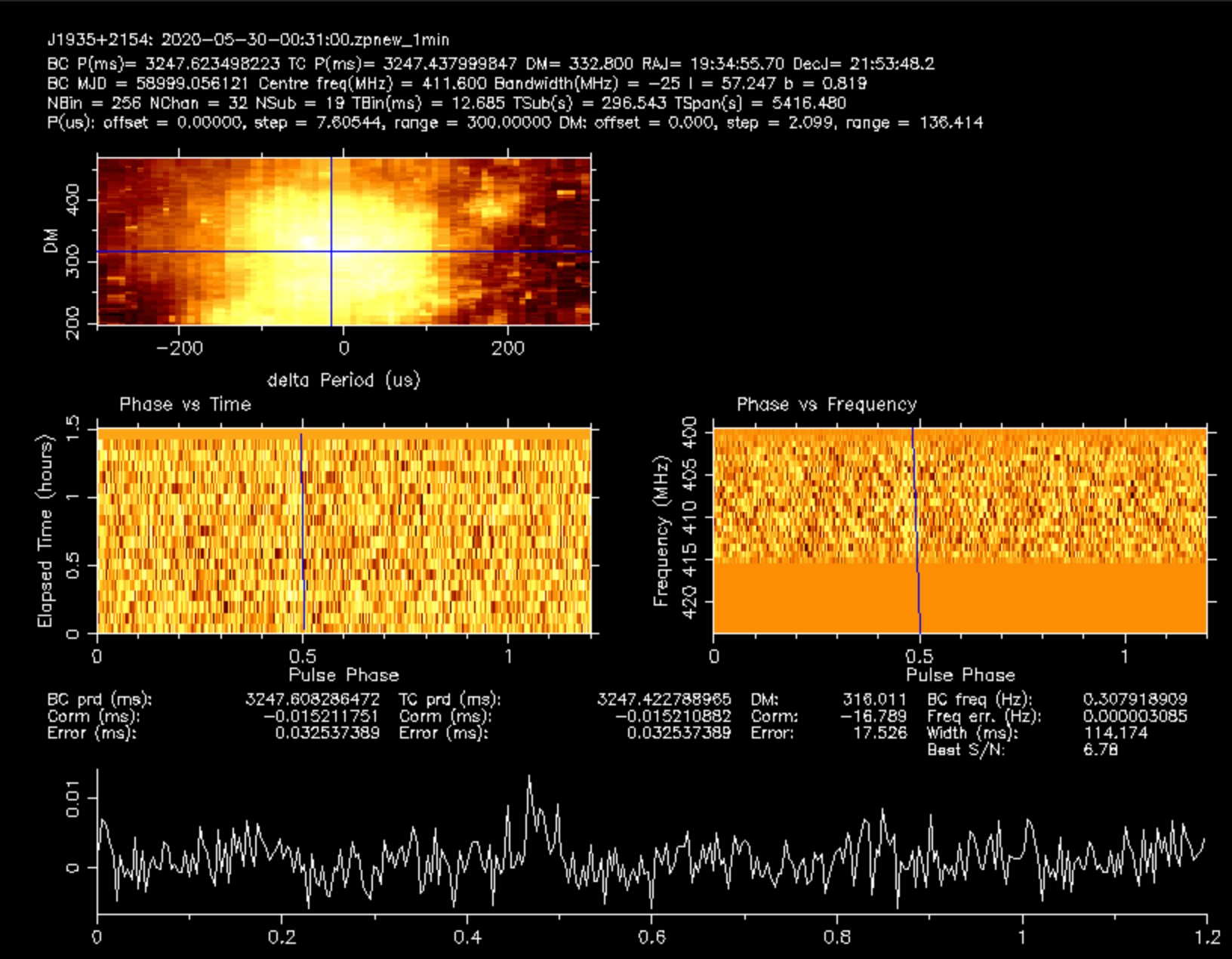
确实不明显
2020年9月18日
NICER的文章出来了
arXiv:2009.07886 [pdf, other]
The NICER View of the 2020 Burst Storm and Persistent Emission of SGR 1935+2154
George Younes (1), Tolga Guver (2), Chryssa Kouveliotou (1), Matthew G. Baring (3), Zorawar Wadiasingh (4) Beste Begicarslan (2), Teruaki Enoto (5), Ersin Gogus (6), Lin Lin (7), Alice K. Harding (4), Alexander J. van der Horst (1), Walid A. Majid (8), Sebastien Guillot (9) ((1) The George Washington University, (2) Istanbul University, (3) Rice University, (4) NASA/GSFC, (5) RIKEN, (6) Sabanci University, (7) Open University, (8) Caltech, (9) IRAP/CNRS)
Comments: Submitted to the Astrophysical Journal, 8 Figures, 2 Tables, comments welcome
Subjects: High Energy Astrophysical Phenomena (astro-ph.HE)
We report NICER observations of the most intense bursting period yet from the magnetar SGR 1935+2154, focusing on 2020 April 28 from 00:40:58 to 16:21:19 UTC, an interval that ends <2 hours after the fast radio burst (FRB) associated with the source. During the first 1120 seconds we detect over 217 bursts, corresponding to a burst rate of >0.2 bursts/s. Three hours later the rate is at 0.008 bursts/s, remaining at a comparatively low level thereafter. The T90 duration distribution of the bursts peaks at 840 ms; the distribution of waiting times to the next burst is fit with a log-normal with an average of 2.1 s. The 1-10 keV spectra of the bursts are well fit by a single blackbody, with an average temperature and area of kT=1.7 keV and R2=53 km2. The differential burst fluence distribution over ~3 orders of magnitude is well modeled with a power-law form dN/dF∝F−1.5±0.1. Our timing analysis of the source persistent emission, after the initial burst storm, retrieves the magnetar spin period and derives a double-peaked pulse profile. There is no discernible correlation of the 217 burst peak times with pulse phase. However, we find that the arrival time of the FRB aligns in phase with the brightest peak of the pulse profile. Finally, we present the persistent emission spectral evolution up to 2020 July 26; its flux and blackbody temperature decrease rapidly in the early stages of the outburst, reaching quiescence 40 days later, while the size of the emitting area remains unchanged.
Pasted from: https://arxiv.org/list/astro-ph/new
magentar pic reconnection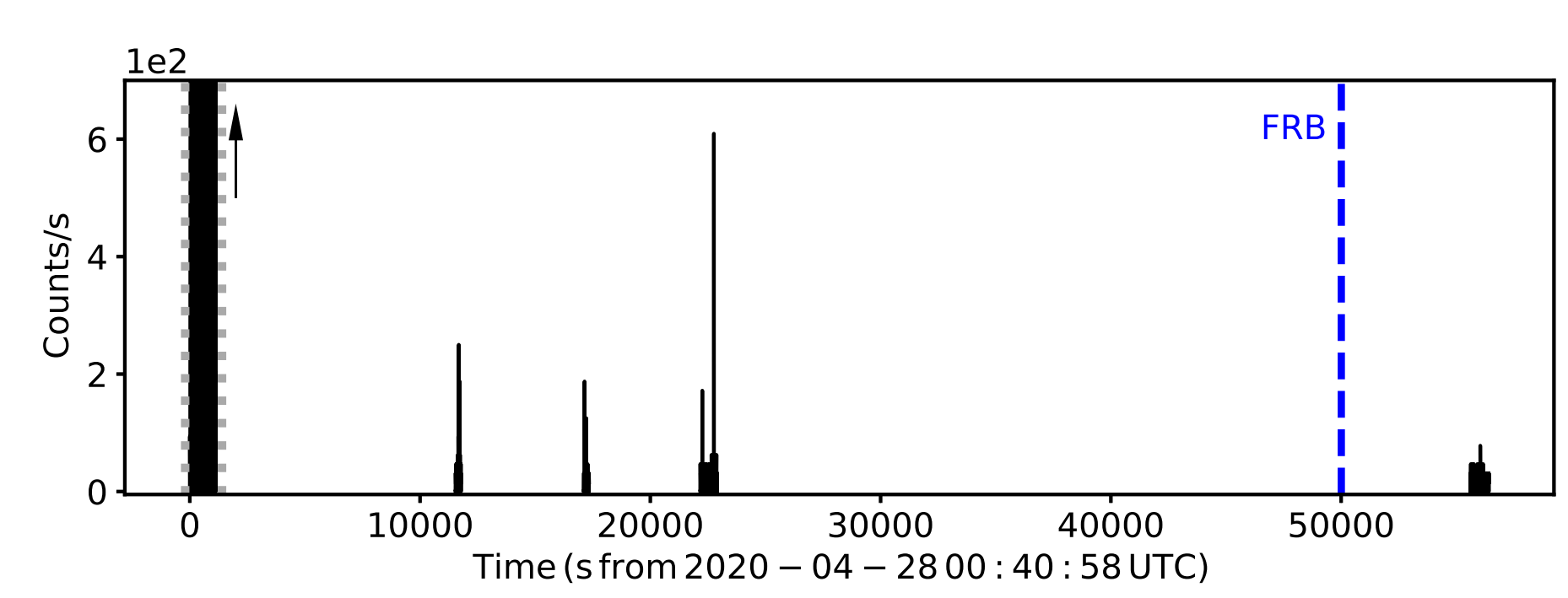
FRB并不是X射线爆发最多的时候看到的,隔了50000秒,半个月的样子。
看到了很多的暴,分布是这样的
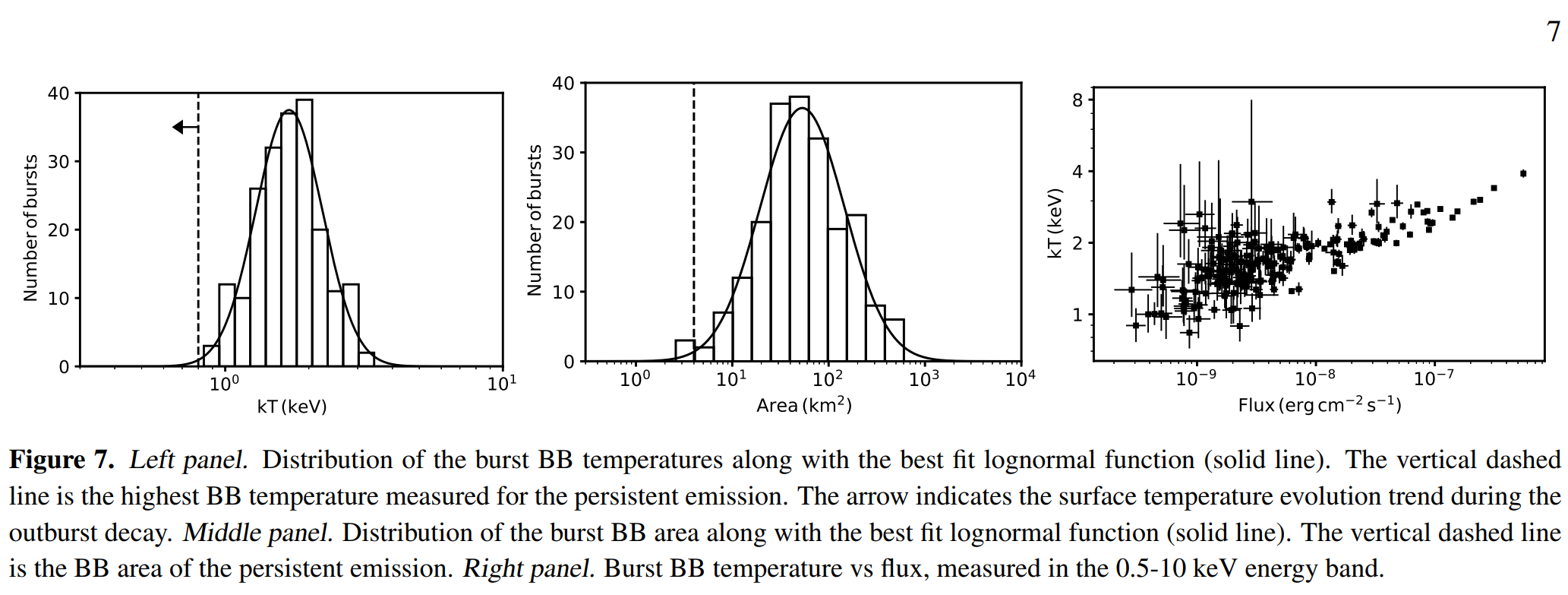
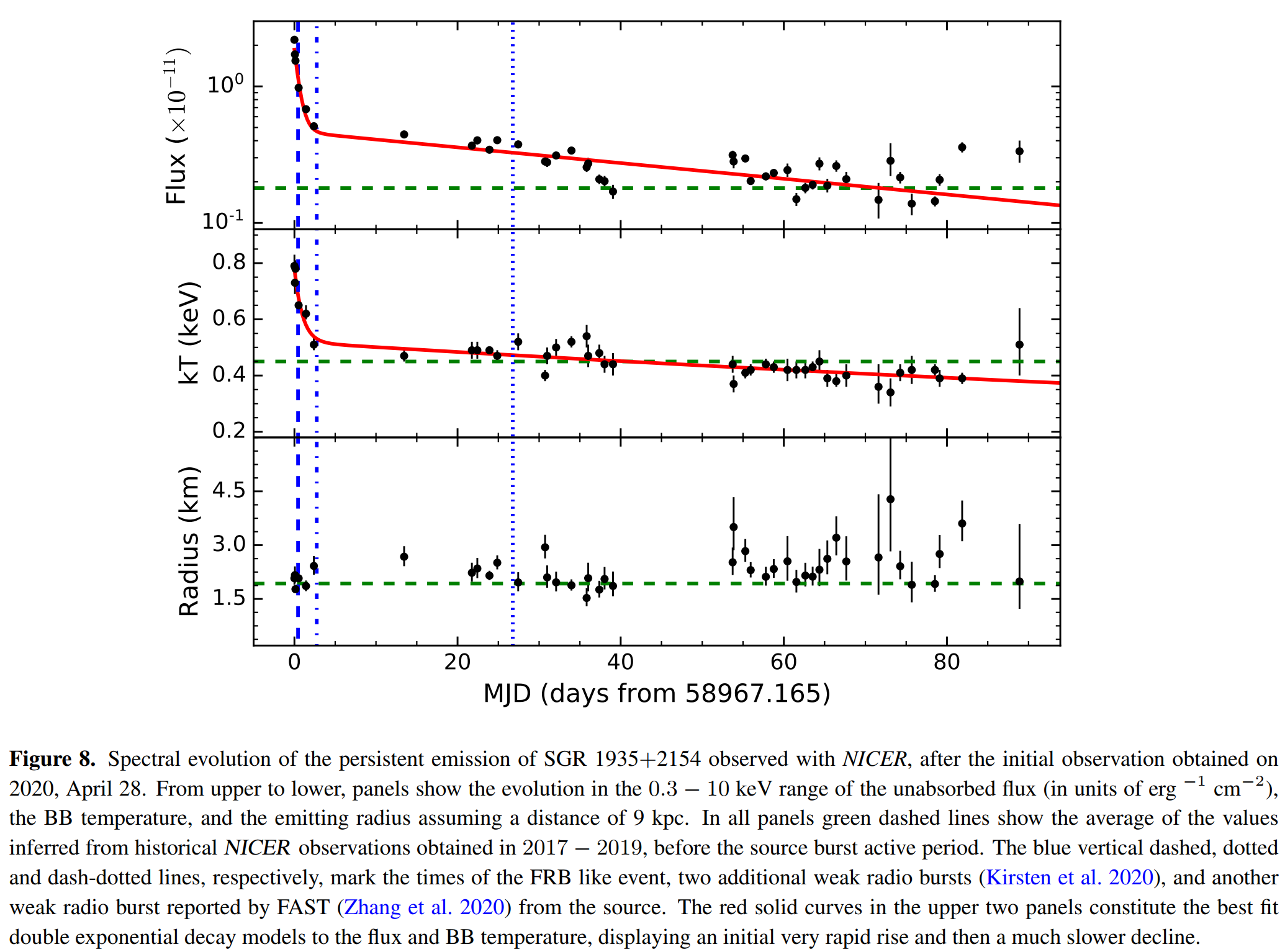
竟然从那个FRB之后有演化!
注意是持续辐射的在演化,不是bursts

2020年11月5日
Nature的文章都出来了,共四篇:
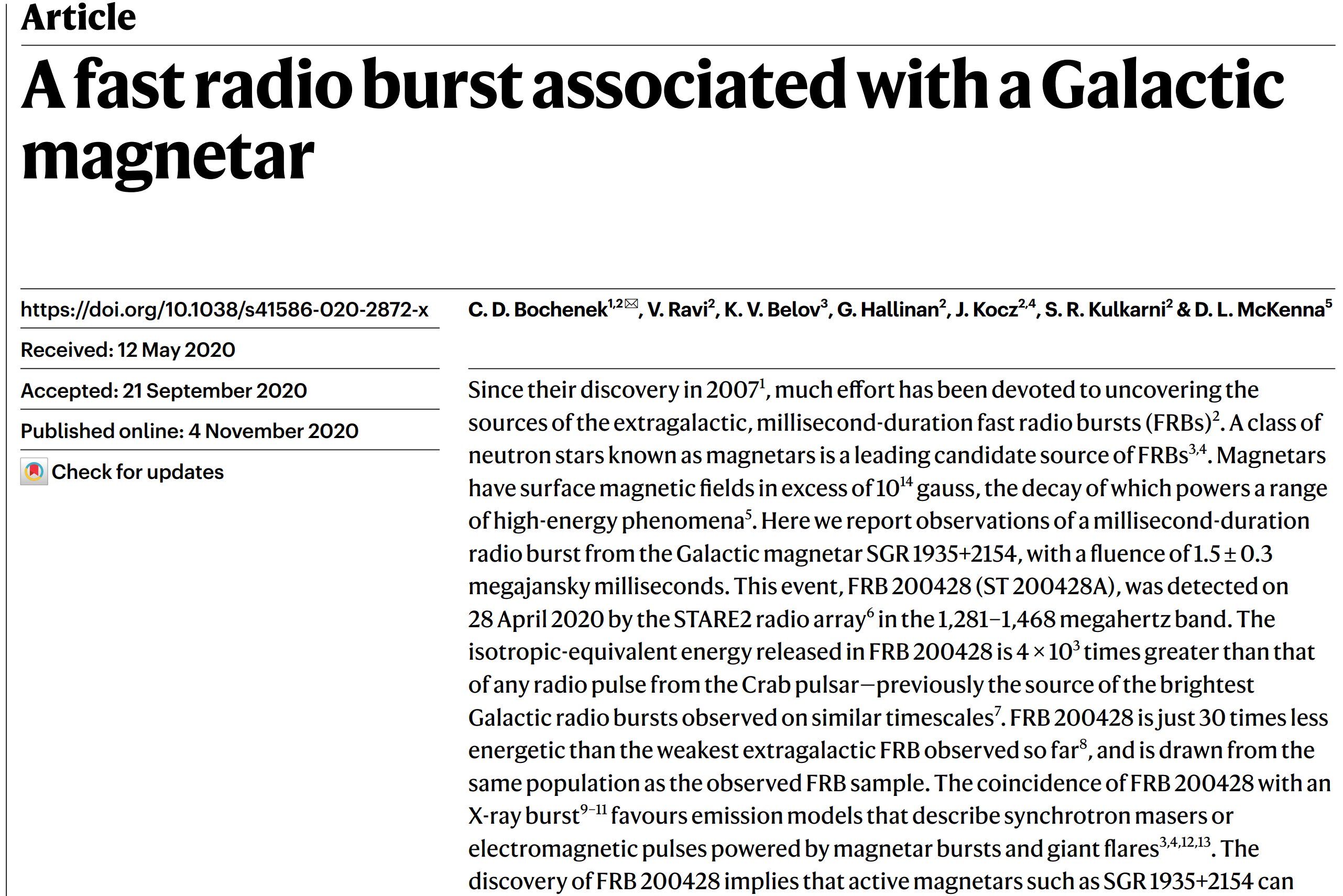
STARE2的观测
https://www.nature.com/articles/s41586-020-2872-x

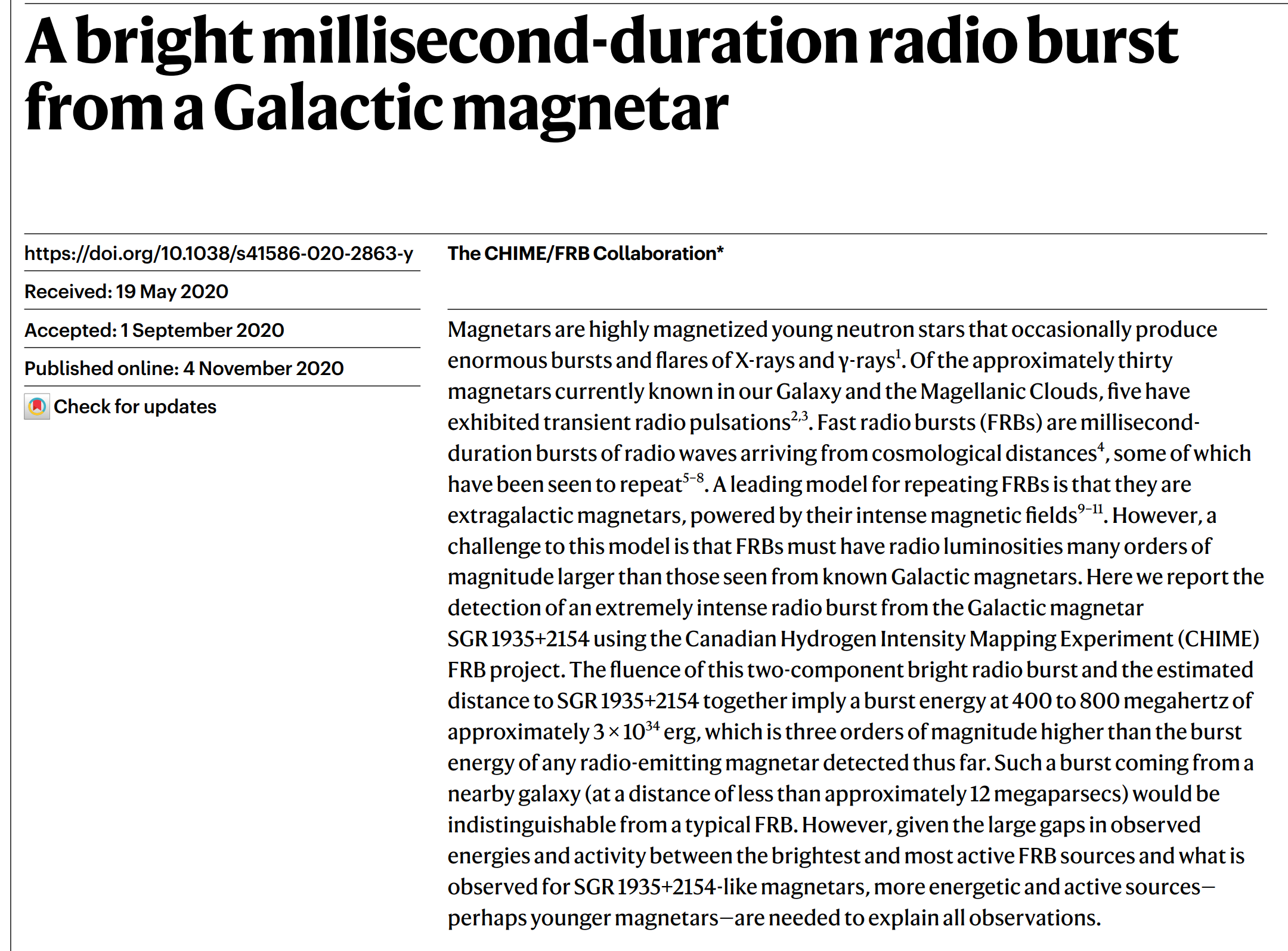
CHIME的
https://www.nature.com/articles/s41586-020-2863-y

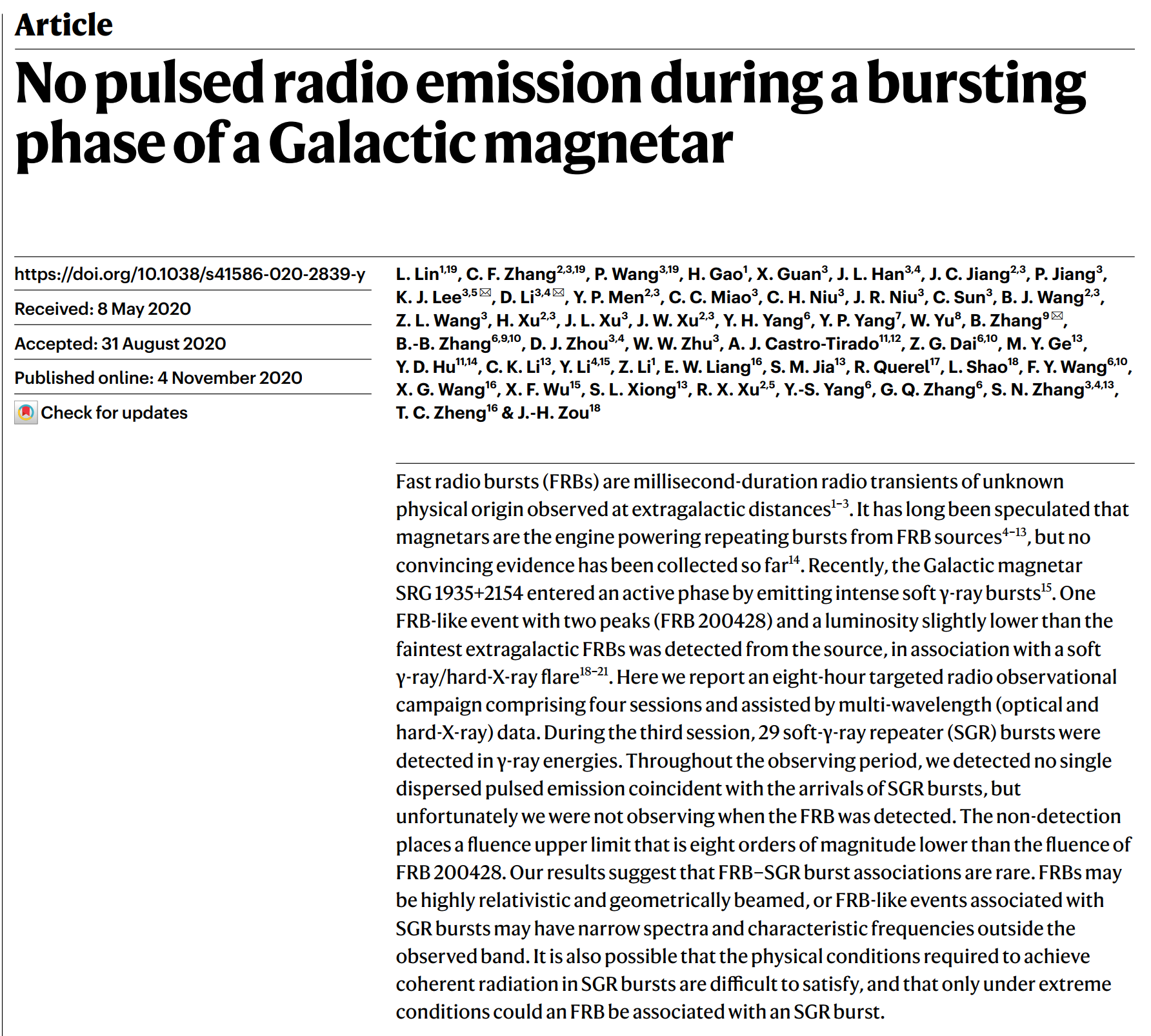
FAST的
https://www.nature.com/articles/s41586-020-2839-y

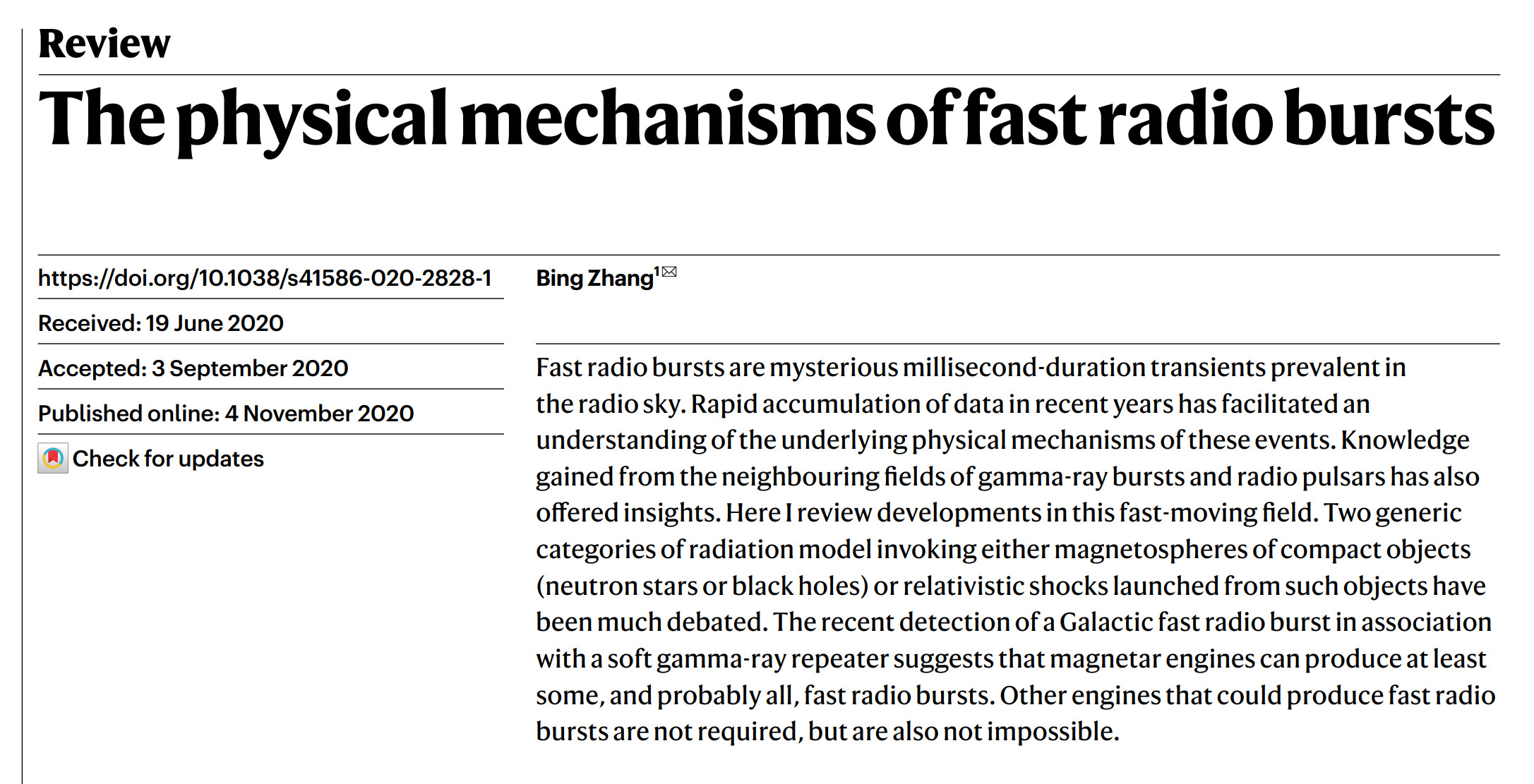
还有张冰老师的综述
https://www.nature.com/articles/s41586-020-2828-1

2022年4月1日
慧眼的X射线观测到了75个爆发, 在总共一个月的时间里
https://arxiv.org/abs/2203.16855
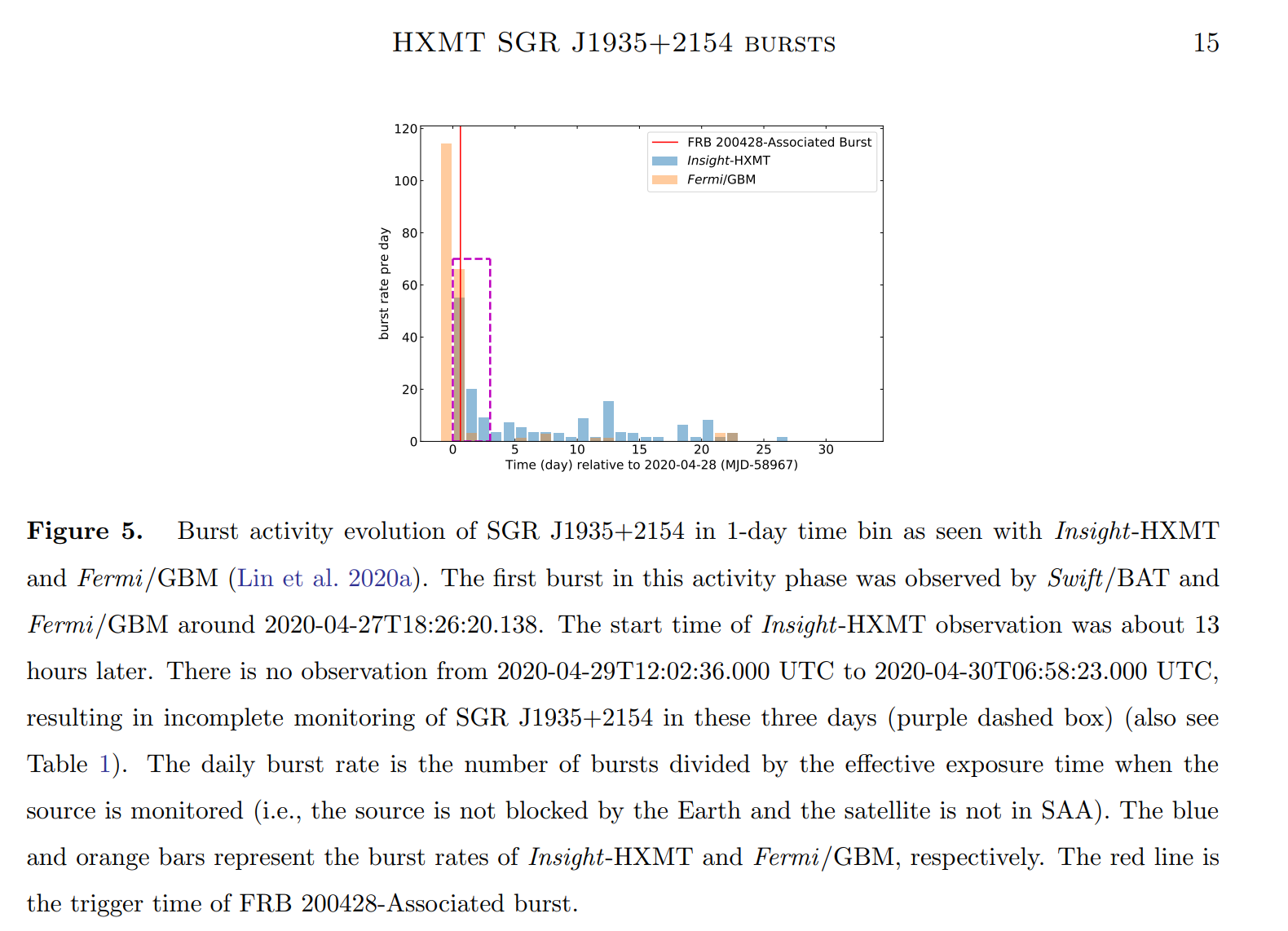
这是它的活动性

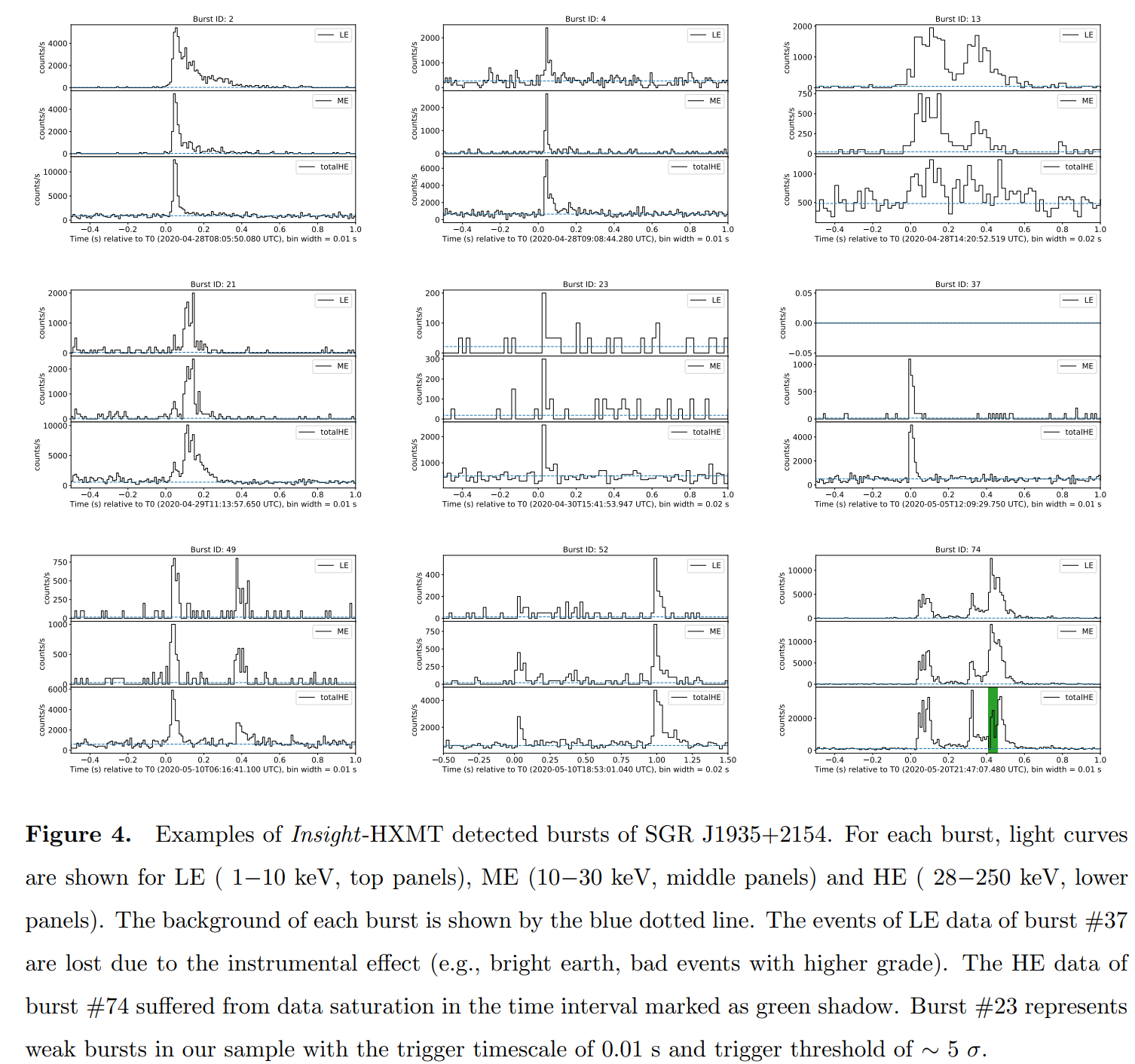
一些暴的样子
附件列表




【推荐】国内首个AI IDE,深度理解中文开发场景,立即下载体验Trae
【推荐】编程新体验,更懂你的AI,立即体验豆包MarsCode编程助手
【推荐】抖音旗下AI助手豆包,你的智能百科全书,全免费不限次数
【推荐】轻量又高性能的 SSH 工具 IShell:AI 加持,快人一步
· 无需6万激活码!GitHub神秘组织3小时极速复刻Manus,手把手教你使用OpenManus搭建本
· Manus爆火,是硬核还是营销?
· 终于写完轮子一部分:tcp代理 了,记录一下
· 别再用vector<bool>了!Google高级工程师:这可能是STL最大的设计失误
· 单元测试从入门到精通